

Visiting Angkor Wat? Here’s everything you need to know
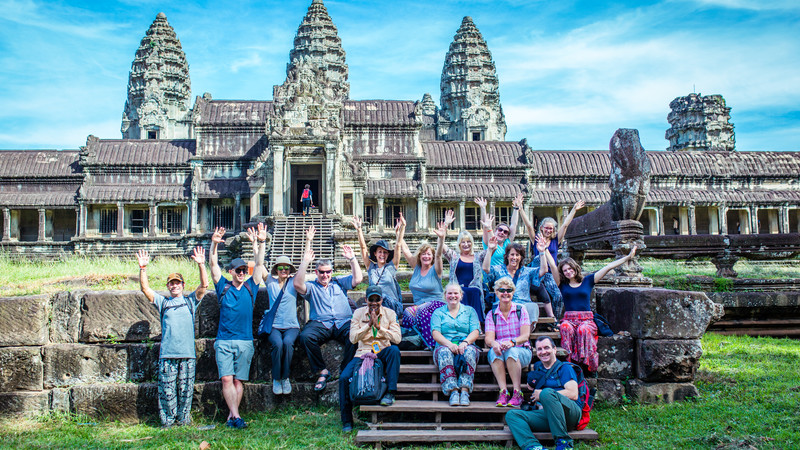
There are few experiences in all my travels that I recall with greater clarity or fondness than the magical time I spent exploring the Angkor Archaeological Park.
I remember waking up in the earliest part of the morning when there was still a thick layer of fog. I remember getting into a tuk-tuk with my partner, Briana, and arriving just as the sun was keen to peak out its knowing head. I remember being entranced by the famed spiraled towers of Angkor Wat, and I stood there, completely in awe, with nothing to do but soak in the sun’s rays and the temple’s majesty.
Visiting Cambodia ‘s Angkor Wat is like being granted the keys to another world for a short period of time. While I was there, I often imagined in my head that, like a certain CS Lewis novel, I must have walked through a closet and into another realm.
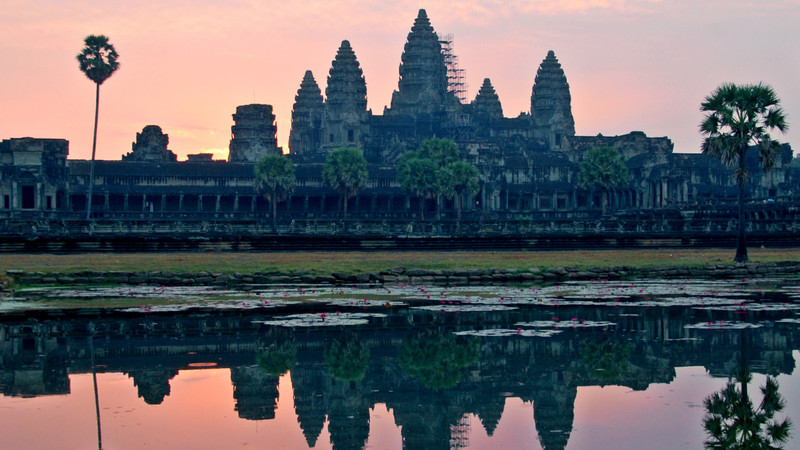
What is Angkor Wat anyhow?
Angkor Wat is the prized temple and showpiece of what is now known as the Angkor Archaeological Park. The city of Angkor itself was built in the 12th century to be an unparalleled Khmer capital for King Suryavarman II. When built, the ancient city extended over 400 kilometres, which makes it the largest pre-industrial city in history. While guesses about the city’s population vary wildly, some prominent historians suggest that the population could have been as high as one million people. Mysteriously, archaeologists are still unsure of what actually happened to this vast empire and its people.
What I didn’t know when I visited, but learned after through further reading, is that the Angkor Archaeological Park shouldn’t really be conceptualized as a collection of disparate temples and monuments in a jungle. This was a fully functioning, complex city that was well-connected, and these temples were just a part of that burgeoning city.
When is the best time to visit Angkor Wat?
Generally speaking, November to February is going to be your best window for a visit. I had the pleasure of getting some input from Channa, an incredible intrepid leader with a remarkable story , and she wholly concurs because, “it is not too hot, and there’s no rain.” Now, it’s worth noting that because you’ve got this window without the aggressive humidity and rainfall, you’re going to have more tourists, so it’s going to be quite a bit busier.
As far as timing for visiting, the Angkor Archaeological Park is open most days from 5am until 6pm. I would very strongly recommend getting there for sunrise. Most people who are visiting Angkor Wat will be staying in Siem Reap, and that means if you want to do this right, you’re in for an early morning. The tuk-tuk ride takes approximately 30 minutes, so factor that into your plans.
KNOW BEFORE YOU GO: HOW TO PHOTOGRAPH THE TEMPLES OF ANGKOR
Once the park opens, you’re going to want to head straight to Angkor Wat to get the famous sunrise picture. The full breadth of the sunrise usually occurs between 5:30-6:00, so have your camera ready. And prepare for crowds.
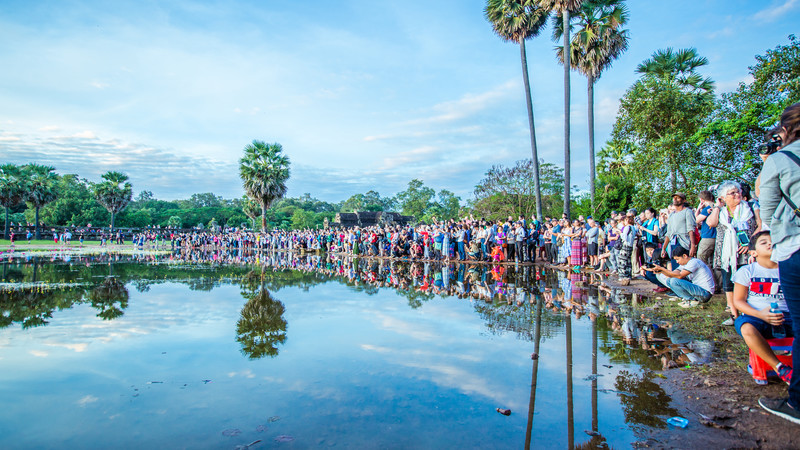
Prepare for crowds!
You might be tired, but I always joke to my fiancée (who in all likelihood is getting tired of my jokes) that it’s always worth it to get up extra early or stay up extra late because fatigue is temporary, but a picture lasts forever.
Trust me, Angkor Wat at sunrise is something to behold, do yourself a favour and get up to appreciate it.
VISIT ANGKOR WAT ON A SMALL GROUP ADVENTURE WITH INTREPID
What should I wear to Angkor Wat?
It’s important to note that at Angkor Wat, there is a dress code that must be abided by. You’ll need to wear clothing (preferably light) that covers your shoulders and knees. The sun is likely to be quite strong, so it makes sense to bring a hat, and you should be wearing good-quality walking shoes. Lastly, you might want to carry around or pack a thin raincoat as weather can be a touch erratic.
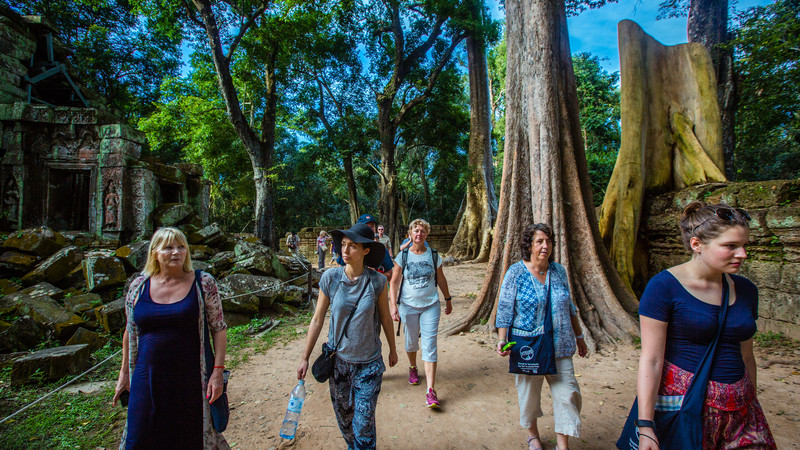
What do you need to see if you’re short on time?
If you haven’t got much time, you’re going to want to make the most of every moment. The good news is that you can cover a lot of ground in just a little bit of time if you’ve planned with purpose. There are some places that you simply need to see if you’re visiting the Angkor Archaeological Complex, and they are, in my humble opinion, the following:
Firstly, the Angkor Wat temple itself. I’d recommend taking in the views of Angkor Wat at sunrise, then going directly after to explore the famed temple. Angkor Wat is the pièce de résistance of the complex, and the postcard picture you’ve seen a million times.
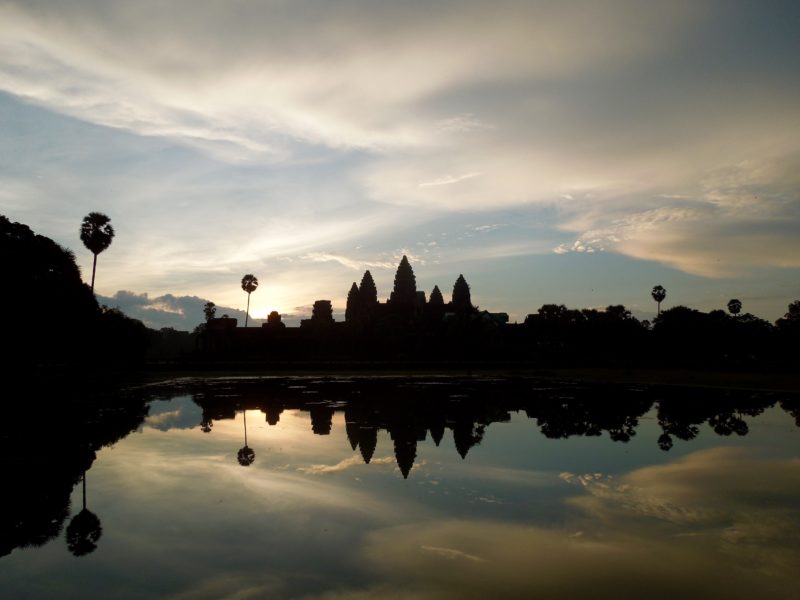
The iconic Angkor Wat
Its pointed towers rising up from the base structure are a classic example of Khmer Architecture of the 12th century, and, based on its prominence, some suspect that this structure was actually constructed by Suryavarman to be his final resting place. Angkor Wat, in short, is a temple like you’ve never seen, on a scale you couldn’t have anticipated. It doesn’t disappoint.
FIND OUT WHAT IT’S REALLY LIKE ON AN INTREPID TRIP TO CAMBODIA, IN PHOTOS
Angkor Thom, known as the Bayon Temple, is also an absolute must. Technically Angkor Thom is a city built by the ruler Jayavarman VII and the Bayon Temple is within it, but they’re often thought of as synonymous. Before I move forward describing what the Bayon Temple is, you should note that there’s no need to be intimidated by the distances between temples as you can take a tuk-tuk between sights to save time if you’ve only got a day.
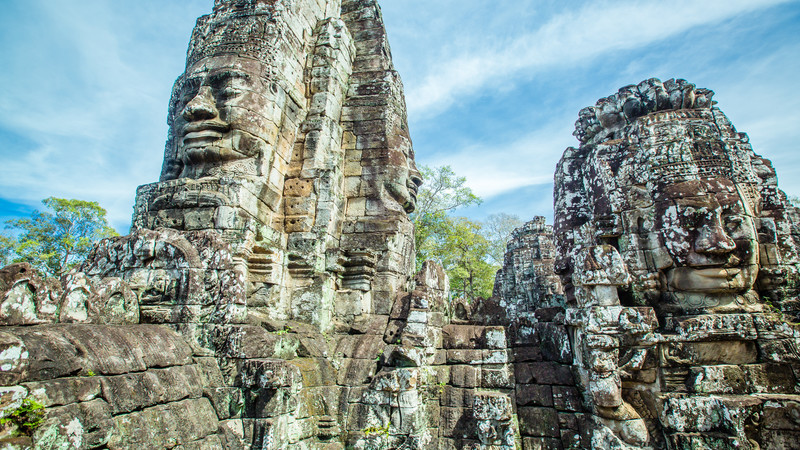
Bayon Temple
The Bayon Temple is a very impressive temple built towards the end of the 12th century, and it’s beyond photogenic. What makes it unique is the smiling faces which jut out of the rocks and greet you with their warm disposition.
Insider tip from top Intrepid guide in Cambodia, Channa :
My favourite spot in the whole park is Bayon Temple, one hour before sunset. There are fewer tourists, it’s cooler and when sun rays hit the faces it is just magic.
Lastly, you’d be remiss to leave without spending some time at Ta Prohm Temple, which was constructed roughly around the same at Angkor Thom, and commissioned by the same ruler. Ta Prohm was constructed to be a monastery and university, and what is perhaps most impressive is that it’s still in remarkable condition considering when it was constructed. What makes it truly famous, however, is the way the jungle has grown into and straddled the structure. It’s an example of what happens when a man made structure is essentially given back to nature. To me, this is the most unique spot to snap a photo.
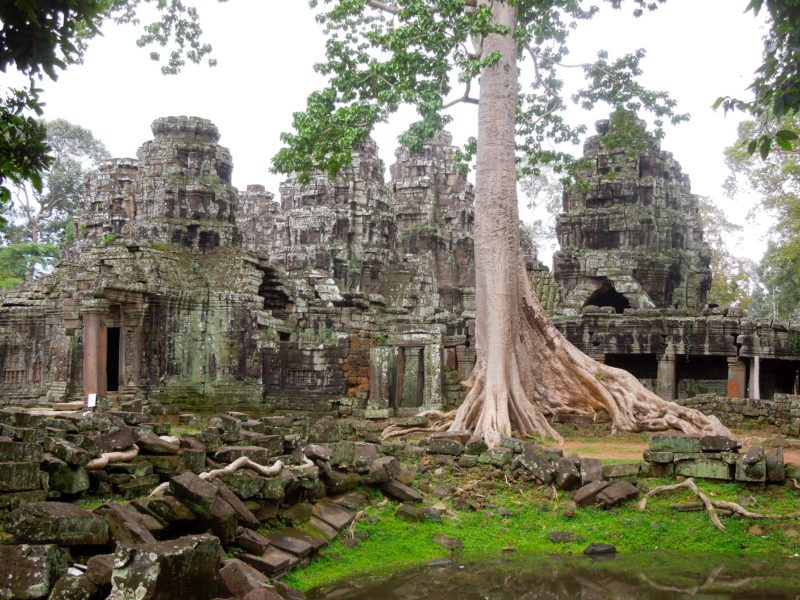
What should you see if you’ve got time to spare?
The sights listed above will astonish you, but they’re far from the only sights to see. Preah Khan is also dazzling in its own right, and it’s not too far away from Ta Prohm and other more famous temples. Preah Khan was also built by Jayavarman VII (12 century), but, in this case, to honour his father. It served as a massive administrative headquarters of sorts, but is now famous because of the overgrowth that has added a layer of mystique.
Jayavarman VII also built a small temple known as Ta Som. It’s a temple dedicated to his father, Dharanindravarman II, and it’s not far from Angkor Thom, which makes it well worth checking out. It’s a single-level shrine that has been left unrestored, and also exists in congruence with growth of the jungle. This is a nice temple to check out if all the other more popular temples seem a little crowded.
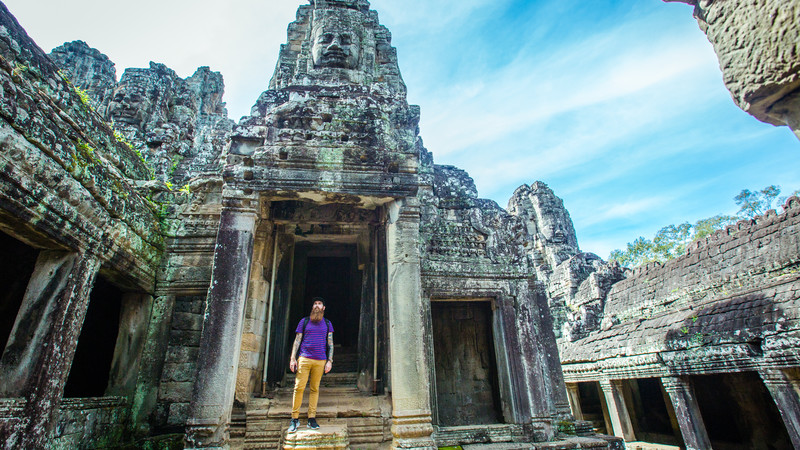
An Intrepid traveller exploring Angkor Wat
Perhaps the unsung hero is Banteay Srei, which you wouldn’t be able to fit into a short visit, but is certainly worth fitting into an extended visit. It’s about 25km away from the more well-known temples, but it often receives rave reviews from tourists due to the fact that there are less crowds, and it’s build with red sandstone. It’s not large and imposing, but it’s gorgeous, ornate, and offers something a little different. Not to mention, it was built in the 10th century, so it predates much of what you’ll see elsewhere!
What can you do in Siem Reap?
I’m not going to lie, when I was staying in Siem Reap, I likely stayed out on Pub Street a touch longer than I needed to the night before heading to the Angkor Archaeological Park. Now, while I wouldn’t recommend that, I also can’t say I regret it. Siem Reap is a fun place to be.
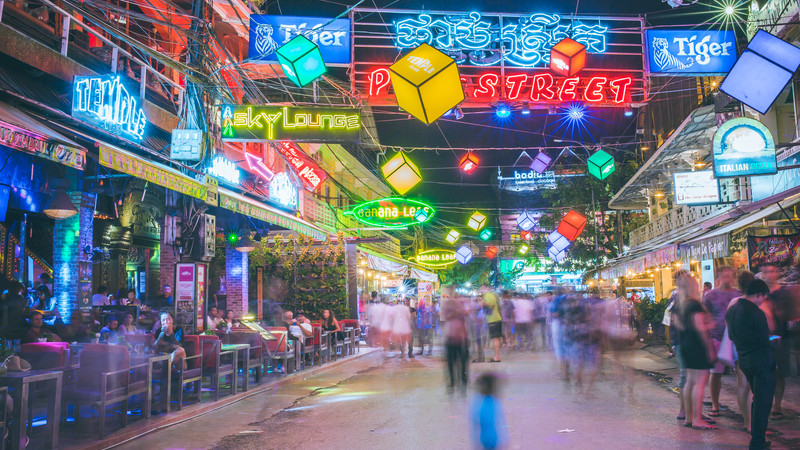
That being said, Siem Reap is a lot more than just “Pub Street,” that’s for absolute sure. The food in Siem Reap is just remarkable, and it’s a good place to dive into Cambodian cuisine which, in my opinion, deserves just as much respect as Thai or Vietnamese. I personally love Fish Amok, which is essentially a fresh fish curry (usually served in a banana leaf), but I’m also a fan of Lap Khmer which is more or less beef salad. I’d also say that you’re safe trying most curries, especially red curries, as they’re to die for.
READ MORE: A GUIDE TO CAMBODIAN DISHES AND MUST-VISIT RESTAURANTS
One of the more unique experiences that I had in Siem Reap was taking one morning to go out to the Tonlé Sap Floating Villages (explore them on this day tour). It was fascinating to see how people lived seasonally when the lake flooded, and the communities that formed more or less on stilted houses.
What to do in Siem Reap according to top Cambodian Intrepid guide, Channa :
Go to Phare (a circus with dance, theatre and live music that tells Cambodian stories). Go to the Angkor Silk Farm . Go shopping, visit local villages and monasteries, and try a cooking class.
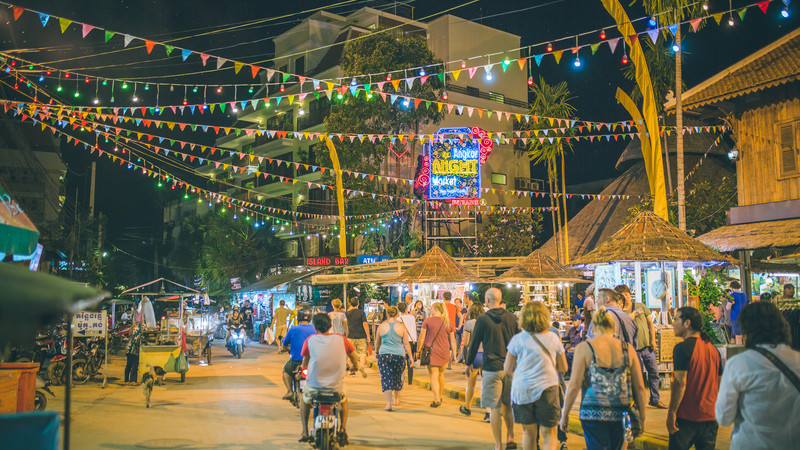
Siem Reap, by night
So, why go?
I’ve been to the Angkor Archaeological Park, but I’m yearning to go back because it’s just that special. I’ve always been a creative and imaginative person, and I feel like visiting this place unlocked doors I didn’t know existed for me. It was like watching fact and fiction blur together before my eyes.
That’s what makes this place so unbelievable, it’s the idea that, unless you go, you just can’t imagine being there. I look around today at the skyscrapers that populate the skylines of most metropolitan cities, and I just can’t imagine them being around for too long. Then you have the Khmer temples which have endured centuries, and will still be there long after the skyscrapers are gone.
Ready to experience this awe-inspiring site for yourself? Check out Intrepid’s range of tours in Cambodia.
(Image credits from top to bottom: Intrepid Travel x5, Chris Mitchell, Intrepid Travel, Chris Mitchell, Intrepid Travel x3.)
Feeling inspired?
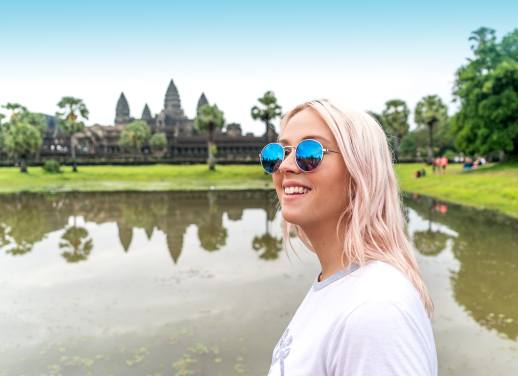
Chris Mitchell
Chris regularly thanks his unquenchable sense of curiosity for ensuring he's never in one place for too long. He's been to over 75 countries across this gorgeous planet of ours and has always felt that all that's needed for a good trip is a well-bound notebook, a well-written book, and a passport with an expiry date that offers a little wiggle room for extending your journey. As a freelance writer and blogger, Chris is only too pleased that his passion for travel, photography, and writing have ever so politely collided. You can follow his adventures at travelingmitch.com, or with the handle @travelingmitch on any of your favourite social media platforms.
You might also like
The 7 best places to go on a..., 5 reasons to visit sri lanka in the..., why 2024 is the best year to see..., yellowstone vs yosemite: which national park to visit, 6 unique experiences you can have in el..., from delhi to udaipur, here are the five..., cinque terre vs amalfi coast: which destination to..., love at first bite: 10 famous sandwiches from..., galapagos or madagascar which unique destination should be..., central vs south america: how to plan your..., 4 reasons you should take a road trip....

Visiting Angkor Wat – The Ultimate Guide
Posted on Last updated: January 29, 2024
Categories Asia , Cambodia , Guides , Travel Guides
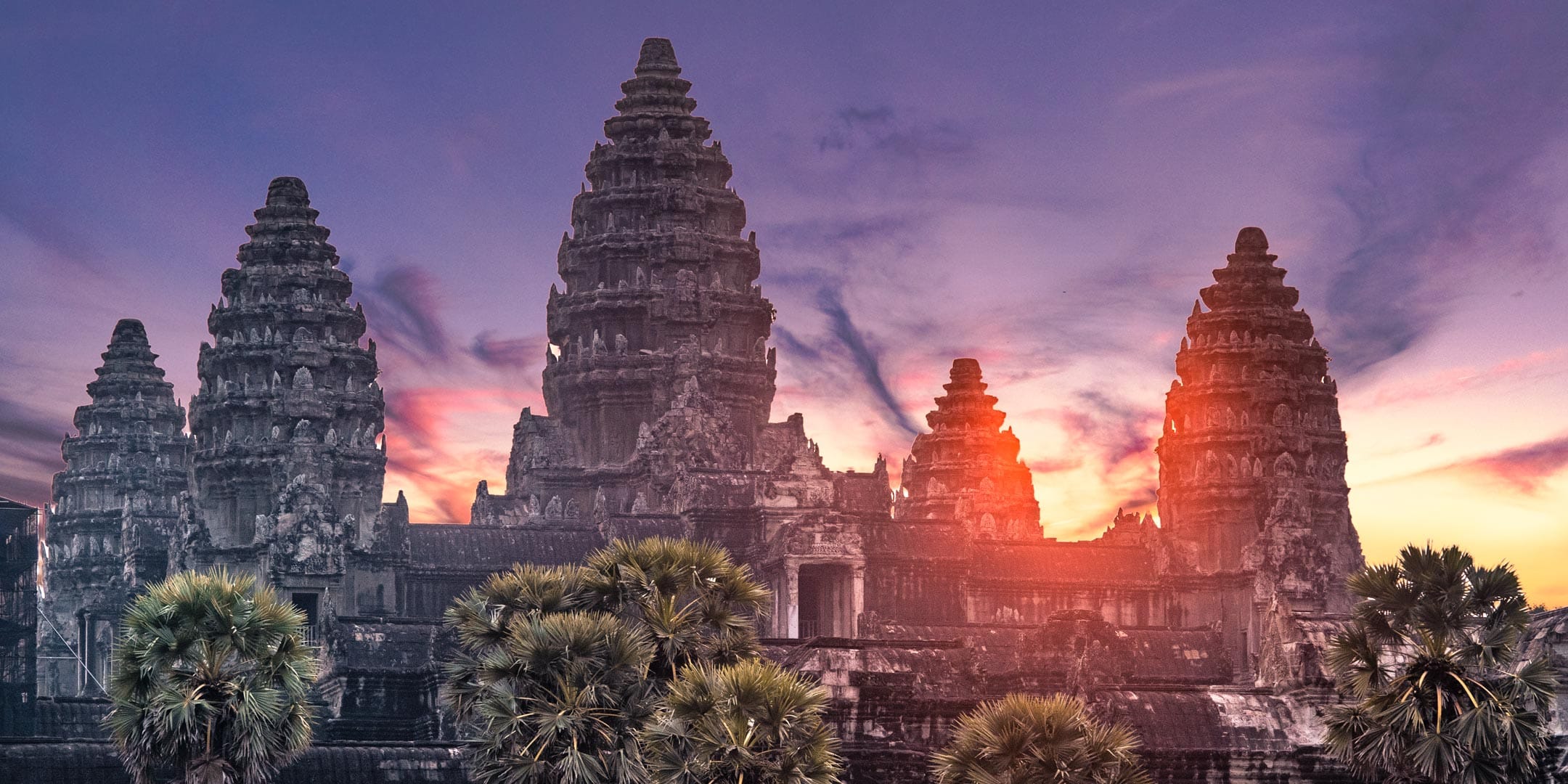
Visiting Angkor Wat is not hard. Being one of the most popular tourist attractions in Asia and the biggest highlight of Cambodia, the ancient Khmer city hosts millions of tourists every year.
Visiting Angkor Wat the best way possible and having a wonderful time – well, this is not as easy as it sounds. Avoiding hordes of tourists, surviving Cambodia’s scorching heat, and finding the best route around the dozens of temples can leave you physically and emotionally exhausted. Visiting Angkor really is a daunting task.
It is possible, though, to see one of the biggest marvels in the world, have a great time, and even avoid the gazillion other enthusiasts. No, I’m not advertising some group tours here ( I hate those ). If you plan your visit carefully ( and I guess you’re already doing that since you’re reading that post ), you can be prepared for everything Cambodia has to throw at you. And if you follow my itinerary, you can even avoid the massive crowds ( not all of them but at least the huge groups ) and see Angkor Wat the best way possible.
Now I know what you’re thinking: Is it really necessary to read such a long guide only to visit a temple? Angkor Wat does look big, but is it really that hard to see? Well, Angkor Wat is significant indeed, but that’s not the main reason you need a guide. Believe it or not, to see Angkor Wat the best way possible, you need not one but three days. How come? Because Angkor is not just a temple.
What is Angkor Wat
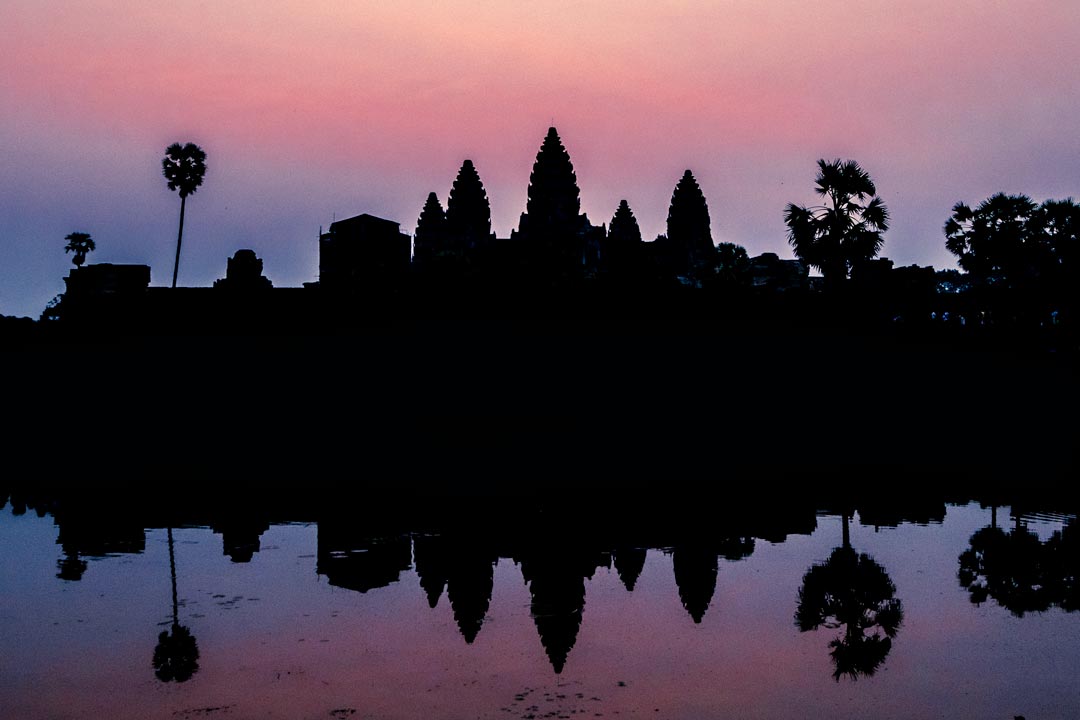
Wait, I thought Angor Wat is this colossal temple that’s on the flag on Cambodia. What do you mean, it’s not a temple?
Well yes, this is Angkor Wat, but it’s only one of the many temples in the Angkor Archeological Complex. A building complex containing more stone than the great pyramid of Giza and covering four times more land than Vatican city. The forgotten medieval metropolis used to be home to more than 1,000,000 people, and it’s considered to be the largest preindustrial city before the Khmers abandoned it.
We can see only a glimmer of the glorious site today. The reason is that apart from public infrastructure and temples, all other buildings were built by wood, which was fastly consumed by the merciless Cambodian jungle. Due to many wars and political instability, most of the city remained hidden in the wilderness until it was rediscovered in 2007.
The main temple – Angkor Wat – may be the largest religious structure on Earth and the biggest highlight of the park, but it is more definitely not the only thing to see there.
Getting to Angkor Wat
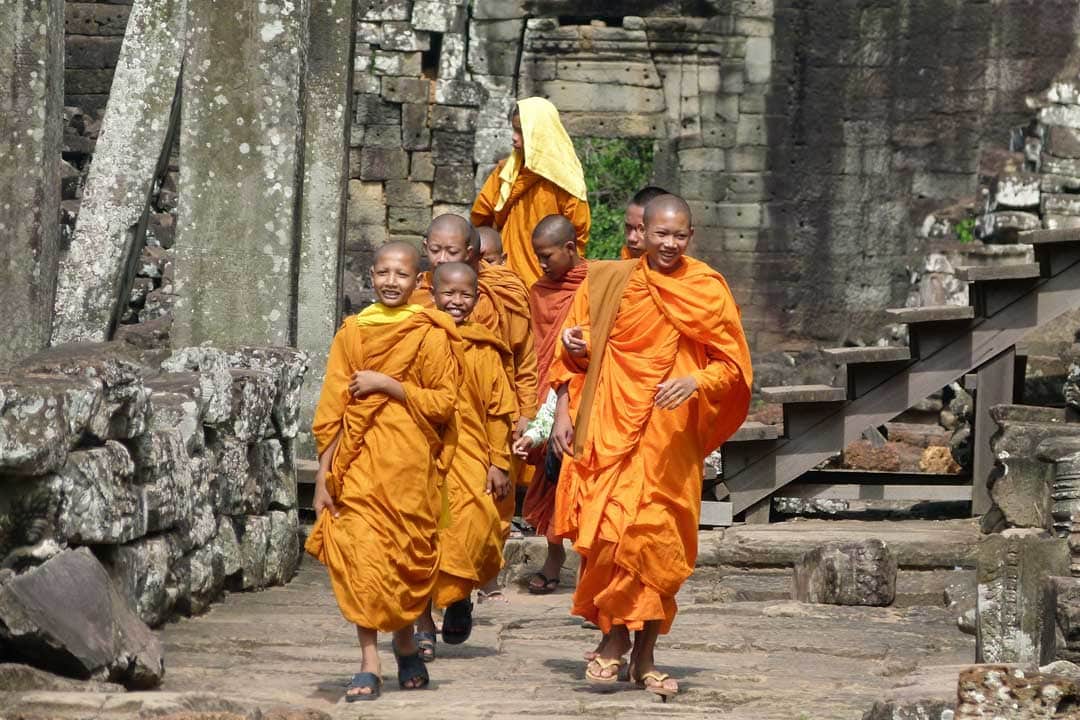
Getting to Angkor Wat is the easiest part of the whole adventure. Being an immensely popular travel destination, everything around the archeological complex is built for tourists.
The gateway to the temples is the Cambodian city of Siem Reap. It has a modern airport, plenty of hotels, and food joints ( including a vast choice of western food ). If you prefer to travel by bus, Siem Reap has more bus routes to it than any other place in Cambodia.
If you still haven’t got your Angkor Wat journey set, check out 12go.asia . The unrivaled number one transport site in Asia.
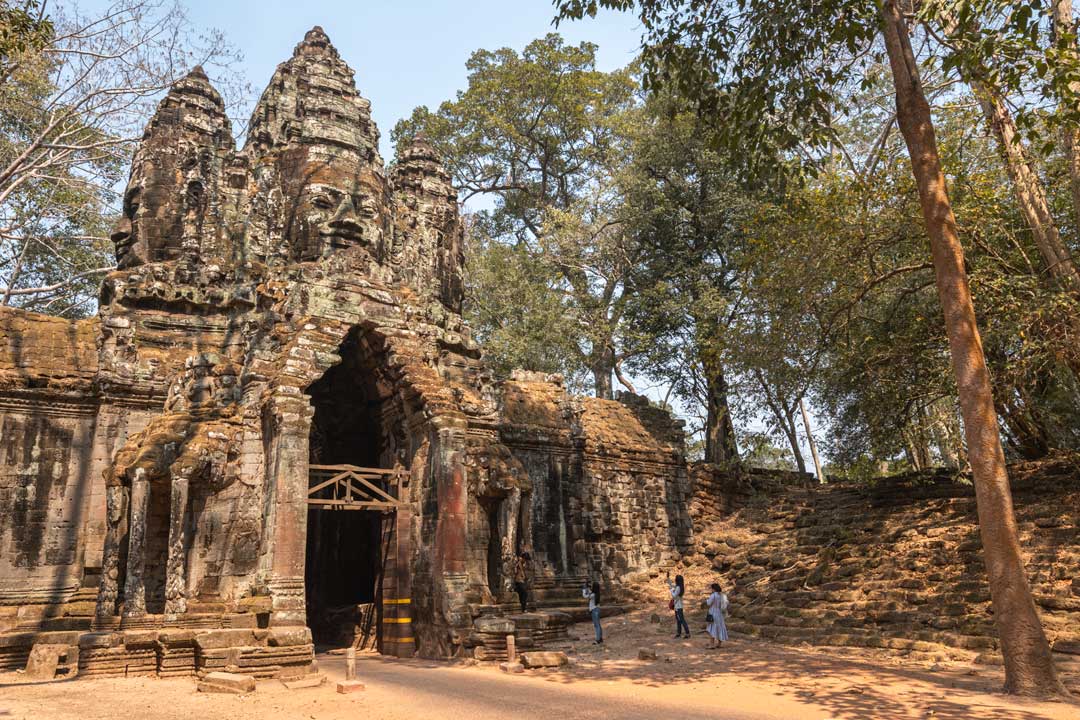
The Angkor Wat archeological complex is located around 5km ( 3 miles ) from Siem Reap, and you can’t reach it by foot ( I mean you can, but it would be very unpleasant and would waste a ton of time ). You can hire a bike which I wouldn’t recommend unless you’re a big bike enthusiast ( distances between the temples are significant, and Cambodia is hot and dusty ) or hire a tuk-tuk driver.
Tuk-tuks are the most popular way to explore the Angkor temples. They cost around 20-30 USD per day and can be found everywhere in Siem Reap. Keep reading to see how to get yourself a top-notch tuk-tuk driver.
Where to Stay in Siem Reap
Central Blanche Residence
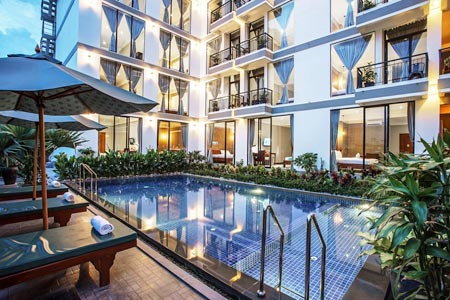
An incredible value for money, the Blanche residence offers modern, clean rooms, and friendly staff that goes above and beyond to satisfy your every need. Airport shuttle and breakfast are also included in the price. Also, a great pool area which is vital to surviving the scorching heats of Cambodia! See the latest prices
Want to explore more options in Siem Reap? See the best hotels in town with a tasty breakfast and free wi-fi
What’s Inside the Angkor Complex
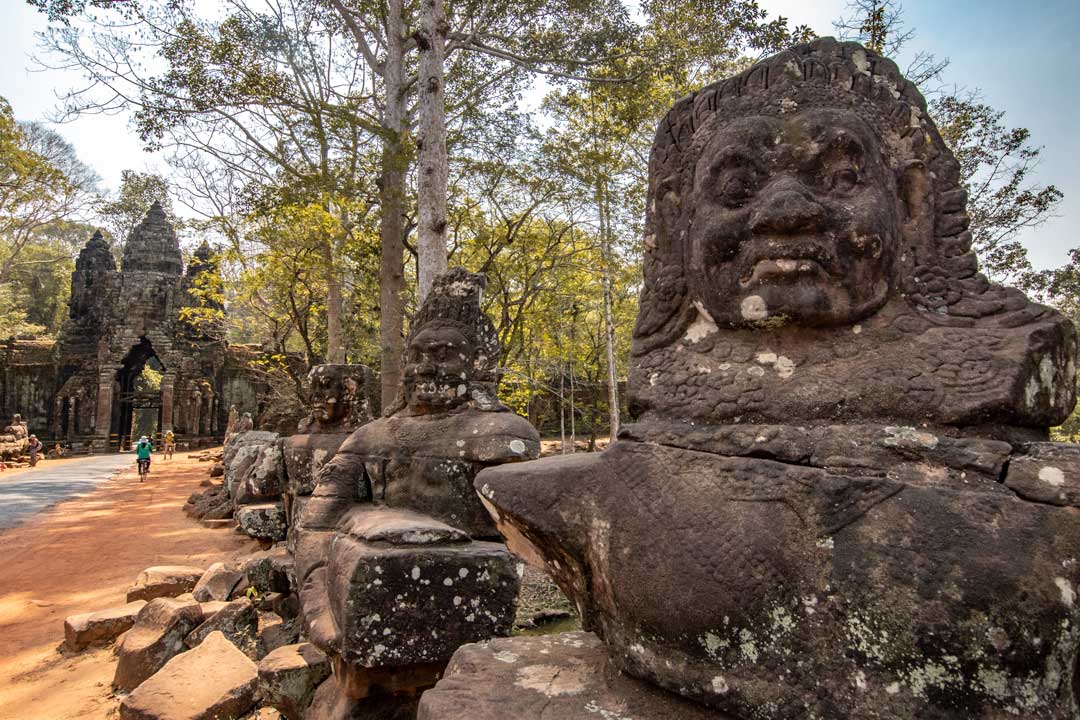
There are around 50 temples inside the Angkor Wat complex, but very few people attempt to see them all. Since some of them are not in perfect condition while others have kind of a similar design, there’s no need to do it. Here are the must-see temples I recommend checking out when visiting Angkor Wat.
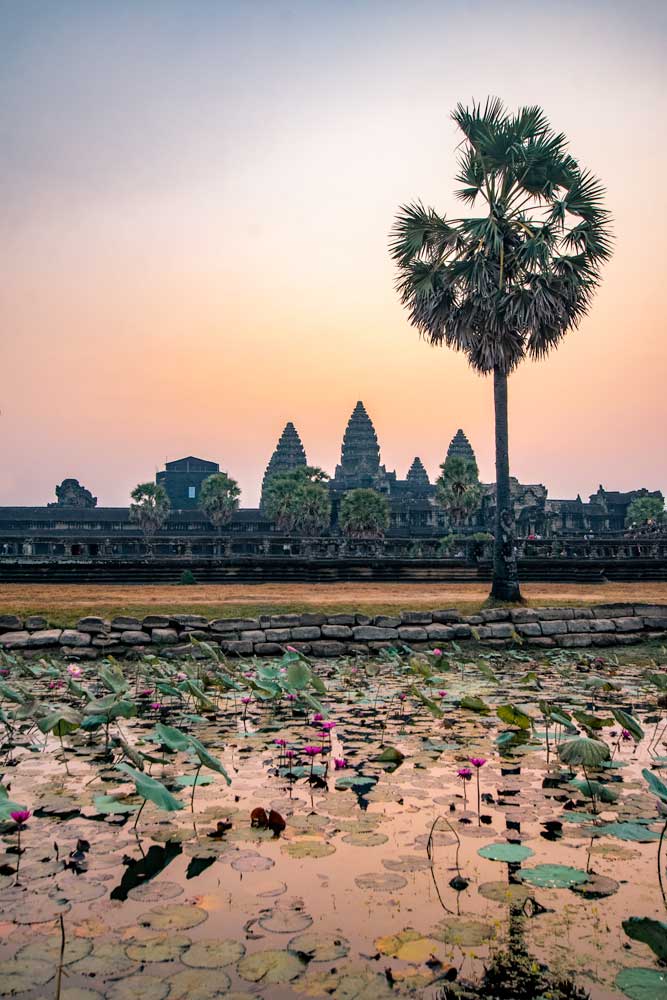
No surprise here. The biggest reason for your Angkor visit is to see the main temple, of course. Built in the 12th century and rediscovered for the world in 1860, Angkor Wat is the largest religious structure on Earth. It’s the symbol of Cambodia and ( probably ) the most recognizable monument in Asia.
Angkor Thom
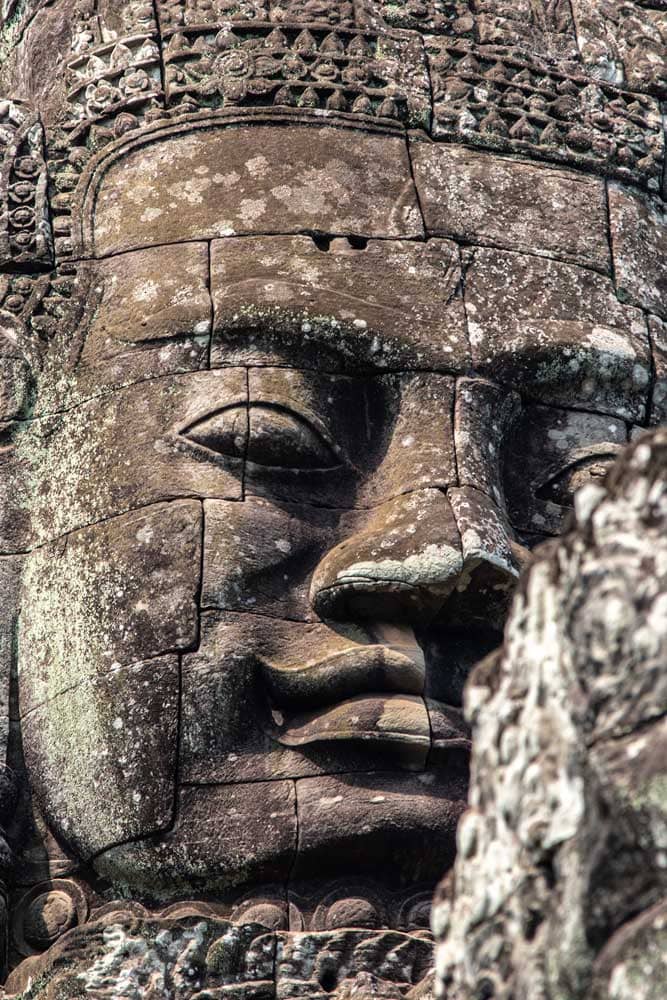
The second most famous sight in the complex, Angkor Thom, is not just another Khmer temple. Angkor Thom is a whole city with its own sanctuaries, gates, terraces, streets, and everything! It was the last great capital city of the Khmer Empire, and it’s absolutely glorious.
If there is only one thing to see in Angkor Thom, it’s the main city temple – Bayon. Decorated with 54 gigantic smiling faces, the temple is one of the most enchanting places on the planet.
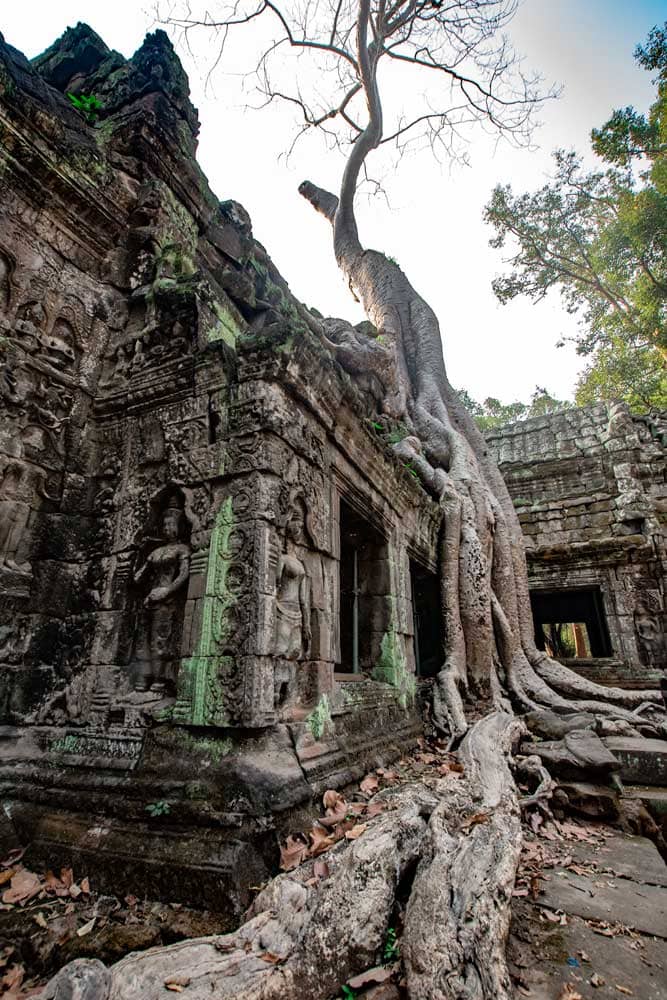
The last of the big three, Ta Prohm is known as the “Tomb Raider Temple”. Once the Angelina Jolie movie hit the cinemas, Ta Prhom became a superstar overnight and is now one of the most visited spots in Cambodia.
The magic of Ta Prohm, however, has nothing to do with the movie. Once abandoned ( around the 15th century ), the jungle quickly consumed the temple. The Silk-cotton and Strangler fig trees made the ruins their new home, creating an incredibly picturesque blend between nature and mankind.

A vast temple that used to be home to 100,000 people, Preah Khan is one of the most underrated highlights in the complex. Visiting Angkor Wat and skipping it is a mistake plenty of tourists do. I’m sure you won’t be one of them.
It’s divided into four enclosures, and all of them are full of beautiful bas-relief carvings. To get there, you need to pass through one of the famous moat bridges that depict a battle between mythical Garudas and the King of Nagas.
Banteay Kdei
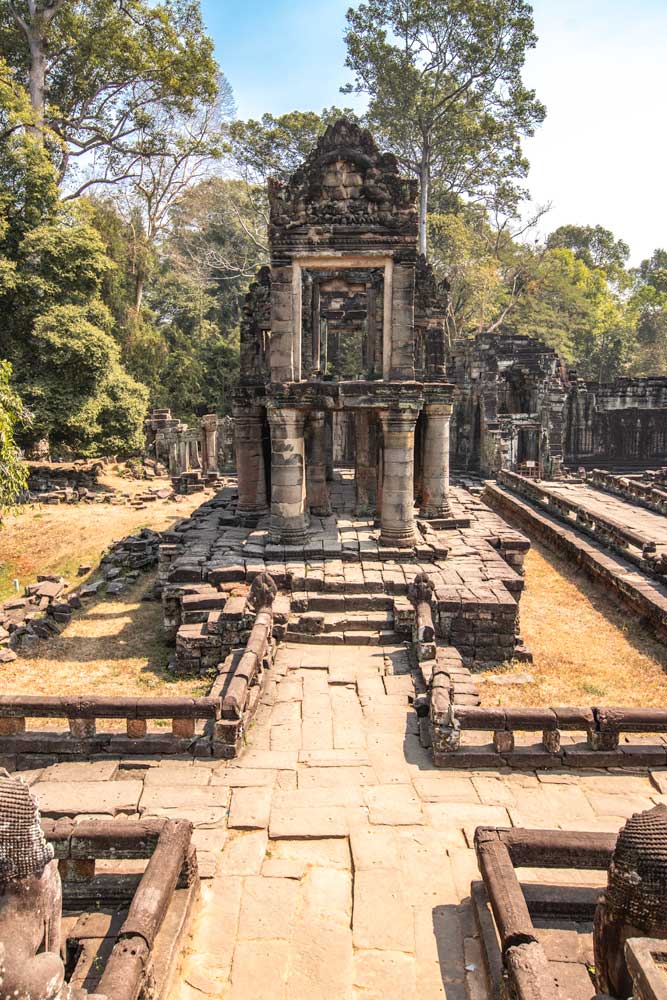
The “Citadel of Chambers” is another hidden gem of Angkor Wat. It’s a labyrinth rich in bas-relief carvings depicting mythical beasts and legends. It’s not on the main path of the tours, so unlike the other temples, you won’t have to battle the tourist hordes to enjoy this sanctuary.
Psst : Wanna know more about the five temples above and see some cool photos? Check out my Top 10 Siem Reap Temples post, and you’ll also learn which are the other five I recommend visiting.
The Best Way to See Angkor Wat
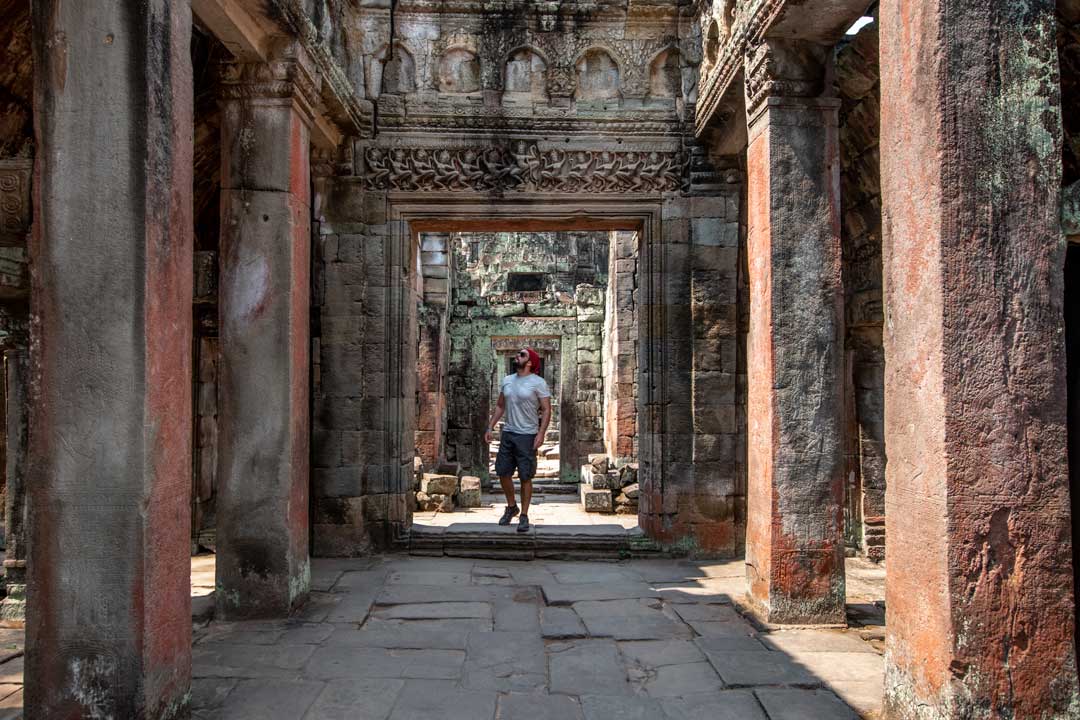
The best way to see Angkor Wat would not lead you around all 50 temples. I mean, if you’re a huge history buff, you can get the 7-day pass and try to do it, but for the regular visitor, so many temples would be too much. I suggest visiting around ten temples in 3 days.
Once you have a tuk-tuk driver, they would offer you three different routes – Small Circle (Angkor Wat, Angkor Thom, Ta Keo and Ta Prohm), Big Circle (Preah Khan, Neak Pean, Ta Som and Pre Rup) and the Long Trip ( Women’s Temple , Landmine Museum and other small temples outside the main park).
For your three days, my best suggestion is skipping the Long Trip and focus on the other two. To escape the crowds and have the best experience possible, we’re going to tweak them a little bit.

If you arrive at Siem Reap at noon – afternoon, Get your ticker at 4:30 – 5:00 PM. Once you have it, go inside the park. Make sure it’s after 5:00 PM though. This late of a visit won’t cost you one of the ticket pass days, and you can watch the sunset for free.
The most famous sunset point in Angkor Wat is the Phnom Bakheng temple. However, the temple only allows 300 people on it, and arriving that late almost guarantees you won’t be able to get in. My recommendation is to go for sunrise over the Srah Srang reservoir.
Best Way to See Angkor Wat – Day 1
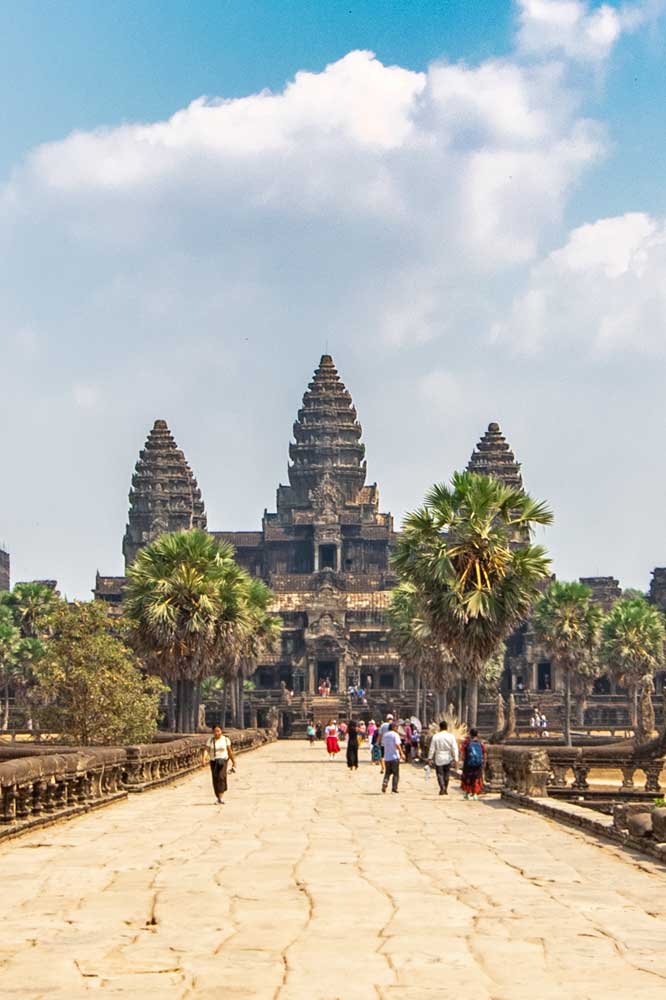
Surprisingly, our first day would start late. Tell your driver to wait for you around 11:00 – 11:30 AM and head straight to Angkor Wat. Note: If you didn’t manage to get your ticket the previous day, your first stop would be the ticket office. Being the main temple, Angkor Wat is impossible to catch free of people, but around noon is your best bet. The first groups are there right after sunrise, while the lazy ones arrive around 10:00 AM. Don’t worry about the sun. It would be hot, but Angkor Wat is mainly covered so you won’t be that bothered.
After lunch, continue to Angkor Thom. The biggest must-see there is the Bayon Temple.
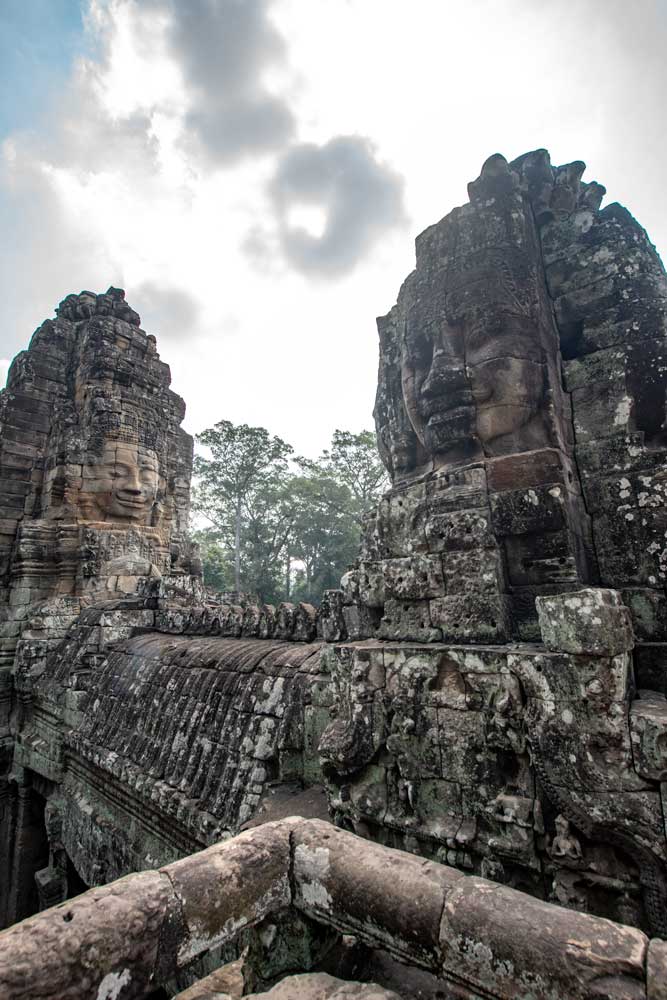
Exploring the two main temples of Angkor should take the better part of the day. If you still have some power left, in the afternoon, you can take a look at the other attractions of Angkor Thom. The Elephant and Leper King terraces are a sight to be seen, while the smaller temples – Baphuon and Phimeanakas – would offer a fascinating non-crowded experience.
Best Way to See Angkor Wat – Day 2
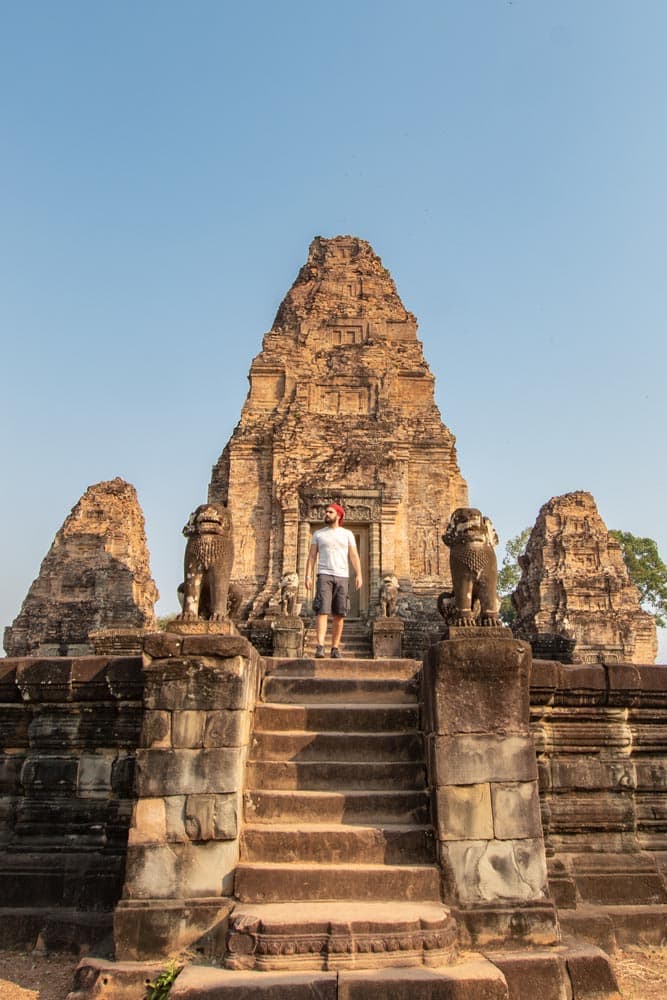
Our second day will start a lot earlier. We’re doing a modified Big Circle today, but to avoid the groups with the same idea, we’ll have to lose some sleep.
Start your trip around 6:30 AM so you can reach the first temple – Pre Rup – before 7:00 AM (groups will arrive around 8:00 – 9:00 AM). Pre Rup is one of the few temples that opens before 7:30 AM, so it’s the perfect place to start your day.
At 7:30 AM, you should be at the second temple – East Mebon. Those two temples may not be as grand as the ones from day one, but they quite different and have their charm.
The third sanctuary for the day is Ta Som. This is the first jungle-consumed temple you’ll visit. Make sure to go to the far end of it to get a picture with the fig tree that hugs the old gate. Ta Som is relatively free of people before 9:00 AM.

Your driver would probably suggest a visit to Neak Pean next, but my advice is to skip it. It’s quite a boring one and will only slow you down. Go straight to the last temple of the day – Preah Khan.
If it’s still early in the morning, there should be no groups hording around. Preah Khan is huge and would easily take you a few hours to explore. Once you get enough ruins for the day ( or the sun becomes too much ), it’s time to go back to Siem Reap and relax. Visiting Angkor Wat sure isn’t an easy task.
On the way back, instruct your driver to go through the North Gate. It’s a very picturesque place, and you won’t be sorry.
Best Way to See Angkor Wat – Day 3
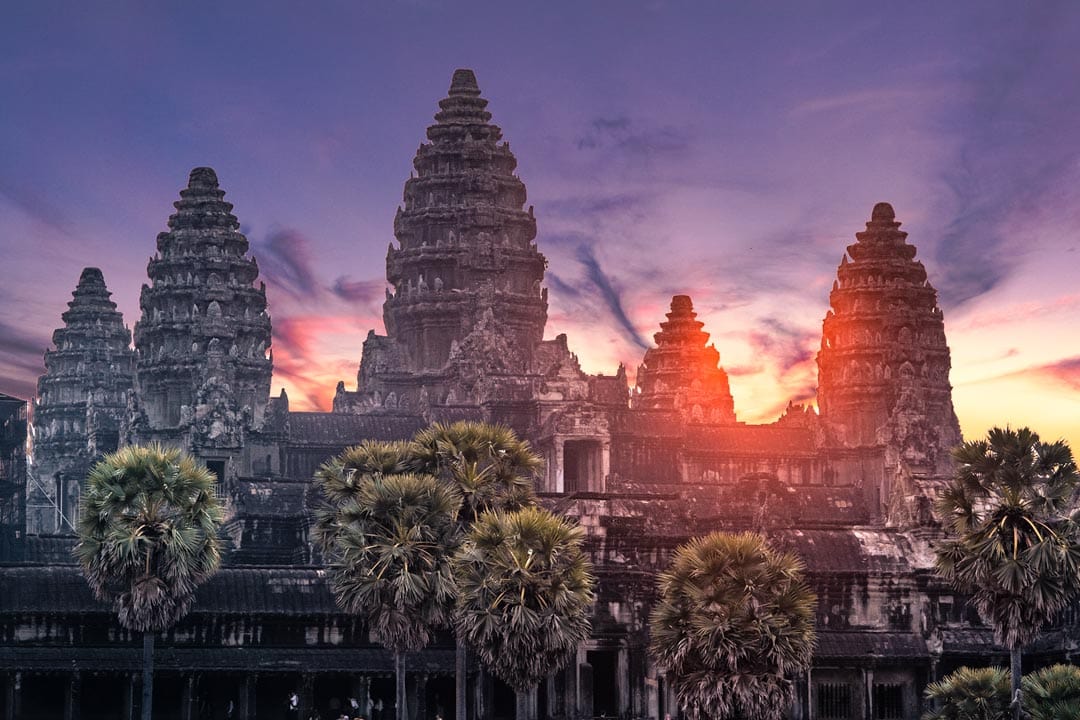
The last day of our Angkor Wat visit will start early. Veeery early. It’s time to witness the most famous sunrise in the world!
If you want to get a good photo, you need to go even extra earlier. Arrange your tuk-tuk for 4:30 AM ( yup, you’ve read that right ) and make sure at 5:00 AM ( when the temple opens ), you are among the first ones to enter. It may sound excessive, but if you want to get a good photo spot, this is the only way. The actual sunrise starts around 6:30 AM, so if you don’t care about the photo, but you’re more into the experience – go an hour later.
Around 7:00 AM, the hordes gathered for the sunrise would either go inside Angkor Wat or go back to the hotel for breakfast. Well, we’ve already seen Angkor Wat, so we make our way to another heavyweight attraction – Ta Prohm.
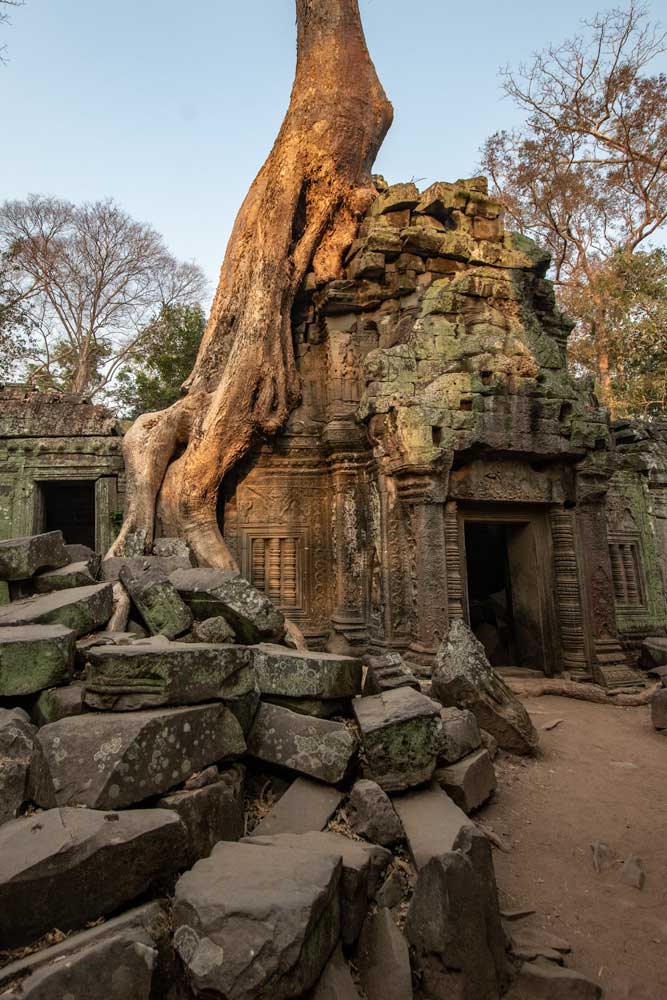
The only time of the day you can catch the Tomb Raider Temple relatively free of people is at its opening times – 7:30 AM. There are several enormous fig trees around the temple, take your time, and see them all. There’s also a very curious attraction named the Dinosaur of Ta Prohm . There is no map, so challenge yourself to find it. Take your time exploring around. This is the last tourist-heavy temple on our visit, so we’re no longer in a hurry.
Our day continues is the underrated Banteay Kdei. No matter the time you make it there, there shouldn’t be a lot of people, so you can enjoy the fantastic bas-relief carvings in peace.
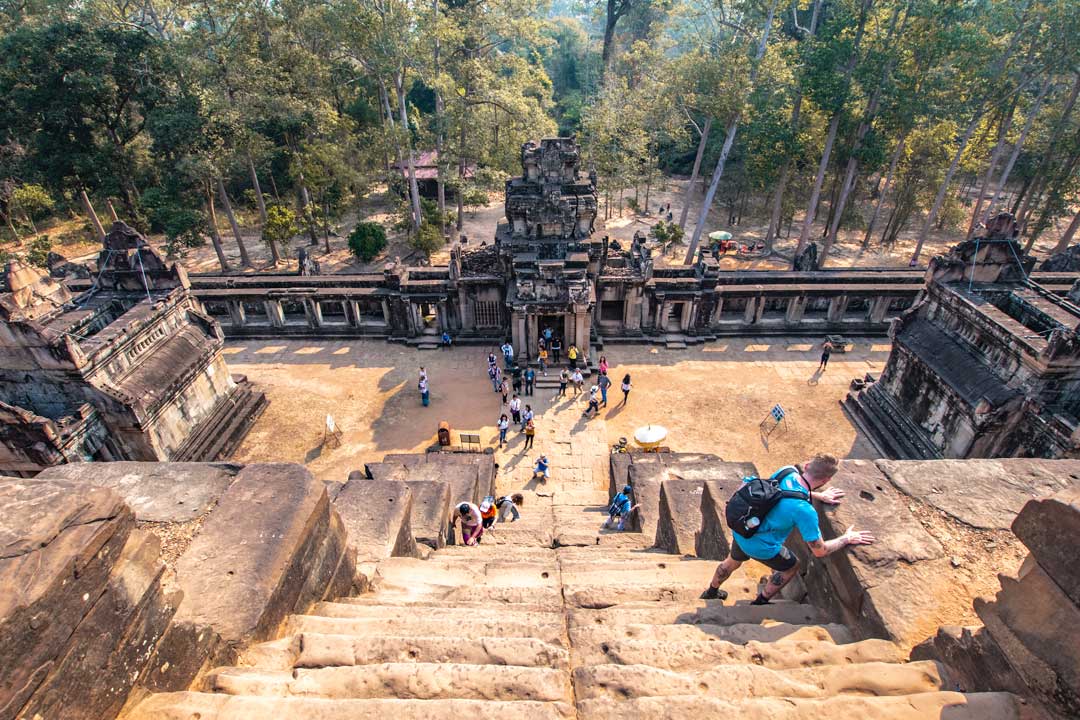
Once you get enough of them, make your way to Ta Keo. This pyramid-shaped temple is not that spectacular, but the climb up ( and down ) makes it an exciting challenge. The top of the pyramid is also a pretty good photo spot, so it’s worth a visit. Other tourists won’t ruin the experience, but there is no shade at this temple, so I wouldn’t recommend a visit at noon.
The last attractions on our Angkor Wat visit are two small temples right next to each other. There’s plenty of shade around Spean Thommanon and Chau Say Tevoda, plus some street vendors selling fruits and drinks. What better place for a picnic and kick-back time.
Your way back to Siem Reap goes through Angkor Thom, so if there’s something you missed on day one, you may stop and check it out now.
Angkor Wat Sunrise
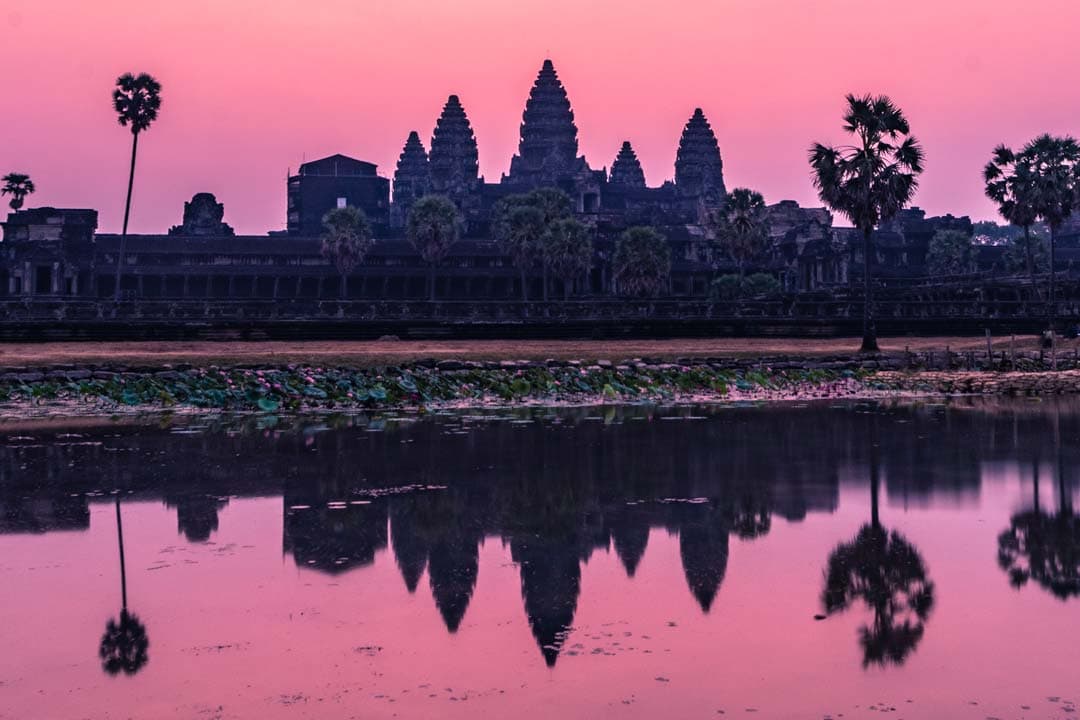
Visiting Angkor Wat is not complete without experiencing the sunrise over the main temple. Let me warn you though, it may sound as a serene activity, but in reality, it is everything but that. Especially if you want to get a good photo.
I like to call Angkor Wat sunrise ‘the most popular sunrise in the world’. There are plenty of places I’ve explored at dawn, but I’ve never witnessed so many people trying to capture the flaming ball of gas. It may be a bit overcrowded, but it’s a definite bucket list experience . And since you’re already in Angkor Wat, it would be a shame to miss it just because you hate getting up early.
Psst: it’s me again! I have another post explaining in detail what to do to have the best Angkor Wat sunrise experience . Check it out!
Some Tuk-tuk Advice
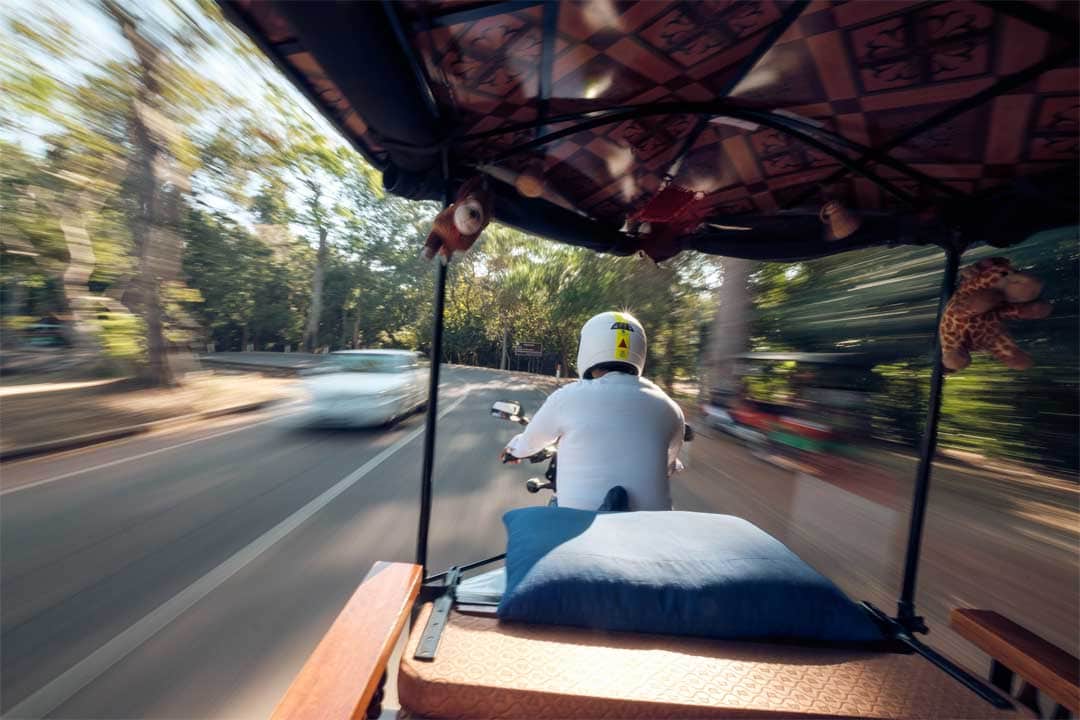
Finding a tuk-tuk driver in Siem Reap is the easiest thing in the world. They would start offering their services at the airport. They would be waiting in front of your hotel. Your hotel would offer you some too. And if you still haven’t got one, just seeing you walking around Siem Reap would attract them like flies. But how to make sure you get an excellent tuk-tuk driver? The answer is – you prepare your transport before you even arrive.
A tuk-tuk driver named Mr.Sok was highly recommended to me, so I gave it a try. Unfortunately, he was already booked, so he arranged one of his friends to show us around.
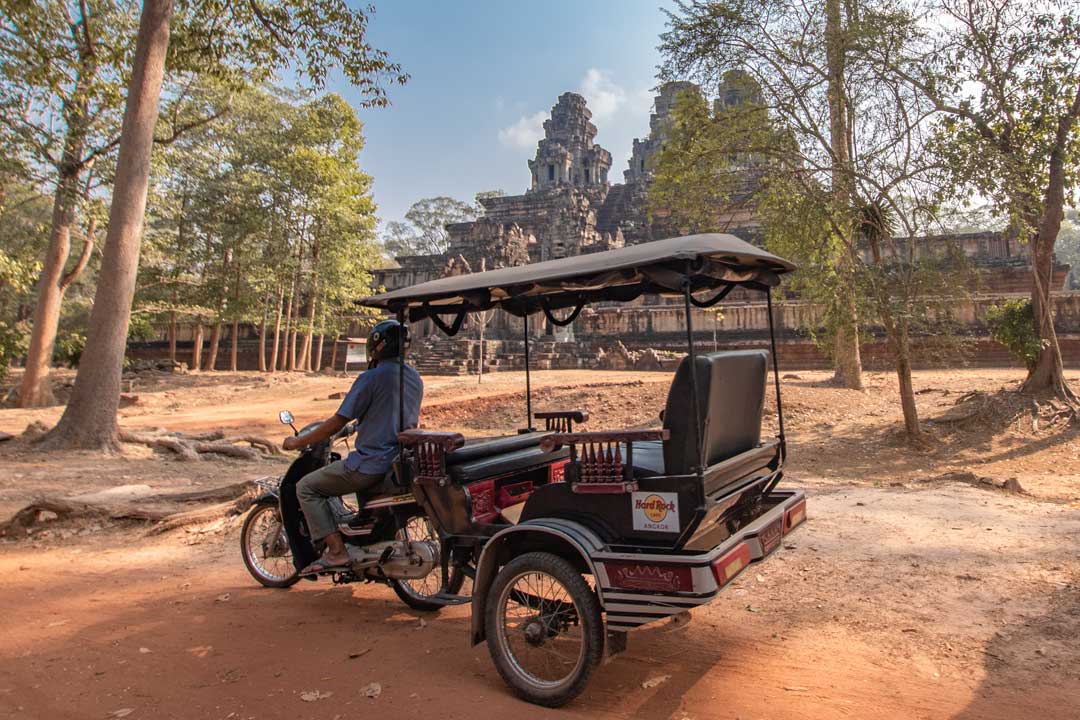
Mr. Thorn ( the friend ) was a cautious driver ( something you would appreciate on the Cambodian roads ). After every temple visit, he was waiting for us with a cold bottle of water and ice-cold wipes. He had some excellent temple advice and was on time every morning, smiling and waiting for us.
To reach Mr.Sok ( or Mr.Thorn ) and guarantee yourself a great tuk-tuk driver, add him as a friend on Facebook first and then write a message ( this way, you can be sure the message will be seen and not sent into the “others” inbox that nobody ever checks ).
Angkor Wat FAQ
What is the angkor wat entrance fee.
There are three types of Angkor Wat tickets: 1-Day pass – 37 USD 3-Day pass ( recommended ) – 62 USD ( The days do not have to be consecutive, this pass can be used on three separate days within one week ) 7-Day pass – 72 USD ( The days do not have to be consecutive, this pass can be used on seven different days within one month ) Tickets are bought only from the official ticket office ( your tuk-tuk driver would lead you there first ), and they have a picture on them. Don’t buy any tickets from the streets or anywhere else. They won’t work.
When is the best time to visit Angkor Wat ?
Ahhh, this is a bit of a tricky one. Angkor Wat is open year-round, but there isn’t really a best time to visit. You’d always have to compromise either with weather or with immense tourist crowds.
For the best weather, December through February is the best time to visit Angkor Wat. Not the hottest of the year but still dry. Those are the tourists months though, so expect to have a large chunk of the 2 million people that visit Angkor Wat every year, there with you.
April and May are hot as hell. Literally…hot…as…hell! The average temperatures are around 35C (95F). Even during the night, it goes a little bit under 30C (37F). If you think you can tolerate such extremes, the tourist crowds would be way more manageable.
From June onwards, the temperatures start to drop, but the rain is becoming more and more often. Cambodia is in the monsoon season. The torrential downpours are usually in the afternoon, leaving the other parts of the day ok for exploring. The showers are quite intense, though. From August through October, Siem Reap receives as much rain as London does for the entire year! If you don’t mind the mud and you’re ready to risk catching a storm or two, the monsoon season would give you pleasant temperatures, low prices, and the smallest amount of tourists possible.
March and November are the shoulder months and maybe (at least on paper ) offer the best balance between weather, tourist crowds, and prices. It’s still a bit of a gamble, though.
Can I use USD in Cambodia ?
The US dollar is an official currency in Cambodia, and it’s accepted everywhere. Just don’t be surprised if you get some change return in the local Cambodian Riel.
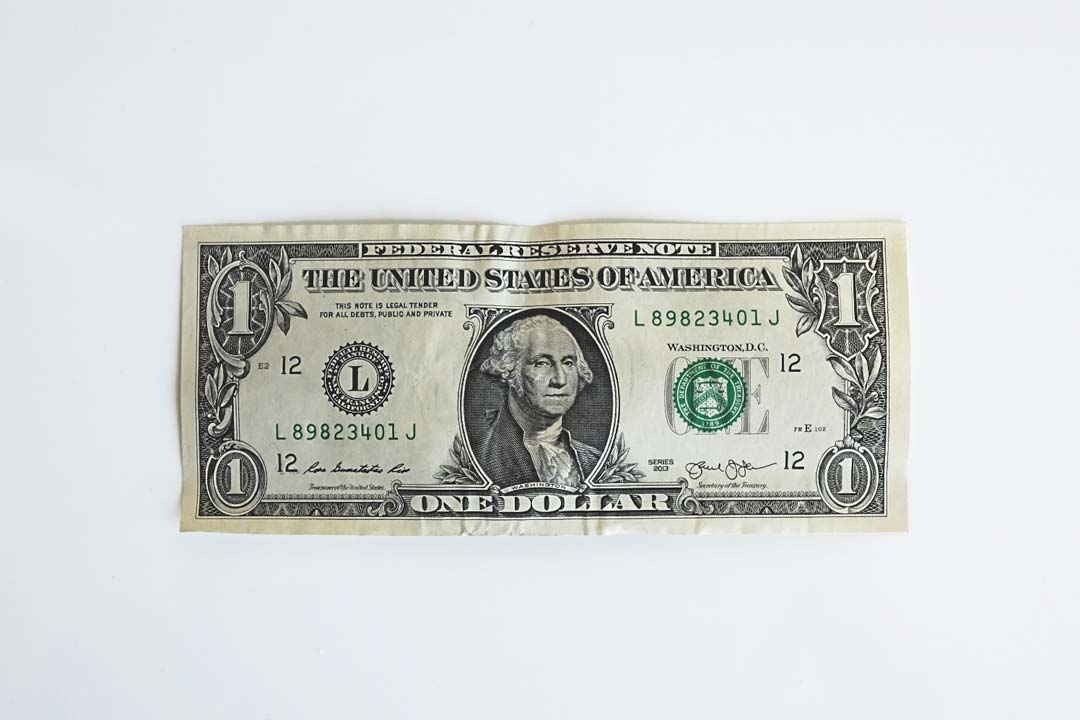
Is one day enough to visit Angkor Wat ?
This one depends on the type of traveler you are and what you expect to see. For me visiting Angkor Wat for just one day is unthinkable. The most popular one-day itinerary is Angkor Wat, Angkor Thom, and Ta Prohm. Going on the most famous Angkor Wat route can guarantee you two things. Huge crowds and a lot of missed things.
The next option is to spend three days exploring the complex. It gives you more flexibility to design your itinerary ( and avoid rush hours ) and also gives you the chance to see more of the wonders of the Khmer. There is a chance that many temples would burn you out, but it’s ( for me ) the best way to see Angkor Wat.
The third option – the weekly pass – is for people who want to explore every detail of the complex and don’t want to rush it. If you have the time and you think seven days of ruins won’t be too much for you, go for it. You’ll explore one of the biggest wonders of the world in a way only a few others have.
What to wear in Angkor Wat ?
Being a religious site, Angkor Wat requires the appropriate attire to visit the temples. Pants should not be above the knee and shirts should cover your shoulders. Tank tops, skirts, shorts, and other revealing clothes are not allowed, and you may be turned away from the temples if you wear one.
Is Angkor Wat open 7 days a week ?
Yes, Angkor Wat is open 7 days a week, 365 days a year.
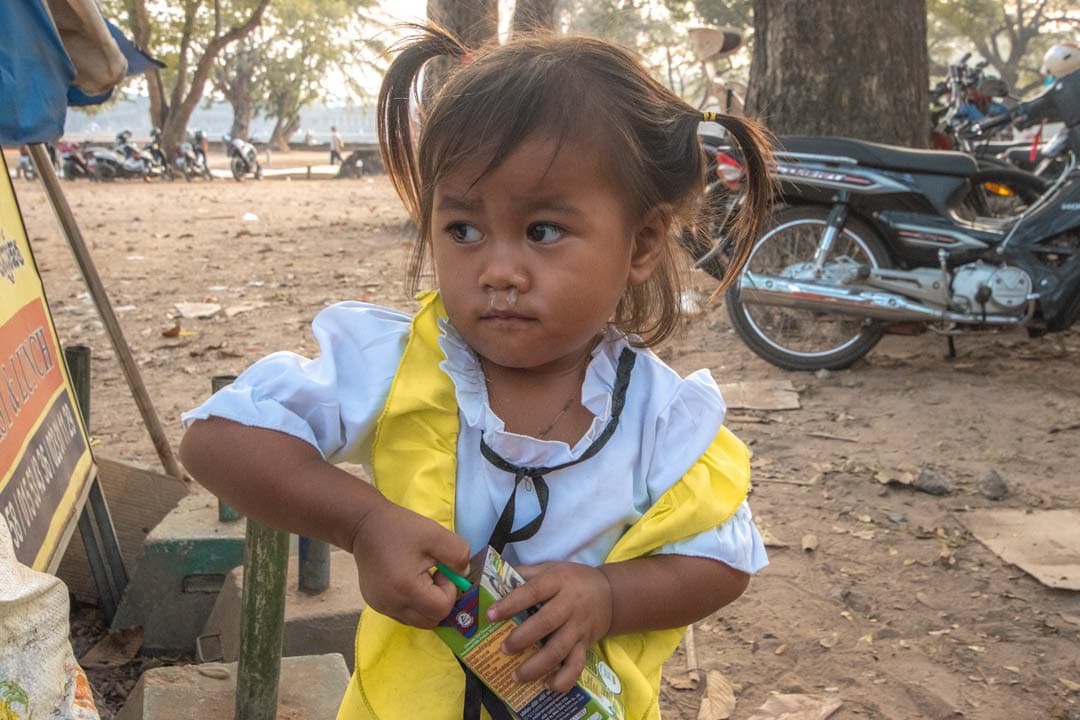
Is Siem Reap safe for tourists ?
It may sound surprising, but Cambodia is an incredibly safe destination to visit. Being the tourist heavyweight of the country, visitors are catered carefully, and crimes are rooted out fast. Just as any tourist place, though, you must always be aware of your surroundings. The violent crimes may be incredibly rare, but petty thefts are not.
A rule of thumb is to not give any money to begging children. As heartless as it sounds, you’d see plenty of kids who would either beg or try to sell you magnets, postcards, and other souvenirs. Buying from them would only encourage this practice to continue, and children to be used as a workforce instead of going to school.
Another rule of thumb is to never travel without travel insurance. I currently use HeyMondo for my travels because they have proven themselves to me more than once over the years. The link above will give you a 5% discount, but If you have another favorite provider, that’s ok. Just make sure you have one because you never know what may happen.
Angkor Wat Itinerary Map
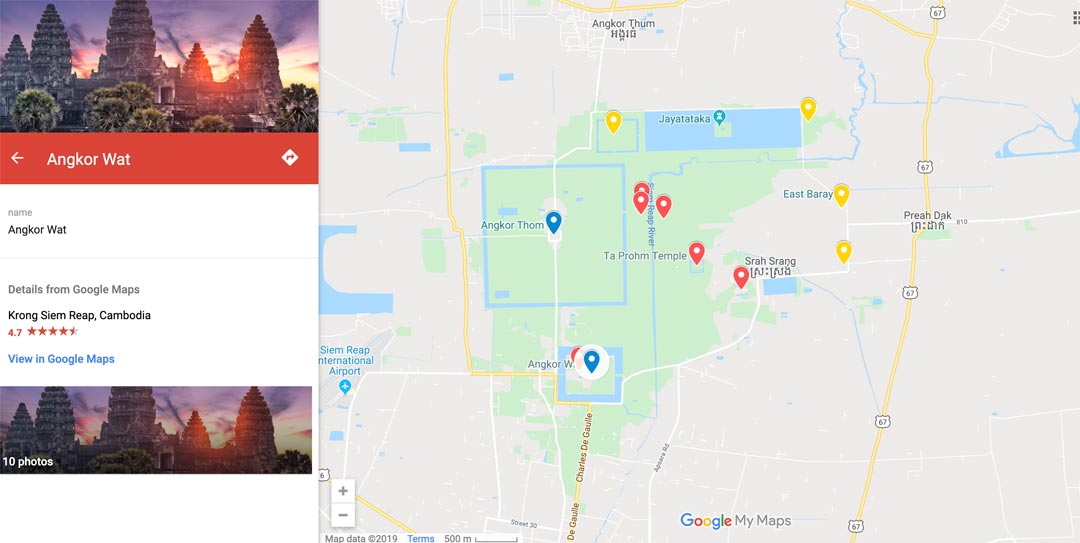
Click to open in google maps
That’s all from me, I hope you enjoy visiting Angkor Wat ! ———————————— If you haven’t planned your trip there yet, find out how I plan my trips! ———————————— I have 11 bucket list ideas for Cambodia. See my impossible bucket list of 1700+ adventures!
Is Angkor Wat on your bucket list?
Some of the above are affiliate links and I will earn a percentage of the sale if you purchase through them at no extra cost to you. This helps keep my site running – so thanks in advance for your support!

Sunday 4th of February 2024
Many thanks for the blog post. We added Mr Sok after reading this and organised two days of driving around the temples of Angkor Wat in February 2024. Great recommendation, he was really great and knowledgeable! Would highly recommend.
Monday 25th of December 2023
Thank you so much for your invaluable info, just back from Cambodia and had an amazing adventure following your advice. I contacted Mr. Sok but didn't get a reply, but found an amazing tuk tuk driver in Mr. Ponleu who was amazing, whatsapp number +855 77 773 425 with excellent English and got me to the temples before the crowds, apart from Angkor Wat of course, like you said that is impossible, but I was on-time and at the front of the lines of folks for the sunrise, and always ready with a cold water once back to the tuk tuk. Thank you again
Sunday 19th of November 2023
Can confirm Mr.Sok is a great choice for a driver :)
Thursday 9th of July 2020
this was a good read for a solo , middle aged traveller hoping to go next year .
Friday 10th of July 2020
Thank you, Jayne! I hope you have the chance to see it, Angkor Wat is truly a remarkable place!
Pin It on Pinterest

- Amazon River
- Galápagos Islands
- Indonesian Archipelago
- Mekong River
- Irrawaddy River
- India Cruises
- Machu Picchu
- Iguazu Falls
- Angkor Wat Travel Guide
What To Do At Angkor Wat: 18 Things You Shouldn't Miss

Cambodia ‘s massive Angkor Archaeological Park deserves its rank at the top of many a world traveler’s bucket list. Located just outside of Siem Reap , the 250-square-mile sandstone complex was constructed between the ninth and 15th centuries by successive “god-kings” of the Khmer Empire. There are dozens of accessible temples and structures to see, but for most visitors, a 2-day or 3-day tour hits the highlights without becoming overwhelming.
At center stage is Angkor Wat, a masterpiece of Khmer architecture with a shimmering reflective pool at its feet and five lotus-shaped towers etching an imposing silhouette against the sky. Here is a list of what to do at Angkor Wat that you really shouldn’t miss:

1. The Churning Of The Ocean Of Milk
An equally important measure of Angkor Wat’s fame lies in its detailed and extraordinary bas-relief friezes, mainly depicting episodes from Hindu epics and historical war scenes. The most famous of these is the Churning of the Ocean of Milk in the southern section of the east gallery. This brilliantly executed carving depicts 88 asuras on the left, and 92 devas, with crested helmets, churning up the sea to extract from it the elixir of immortality.
The demons hold the head of the serpent Vasuki and the gods hold its tail. At the center of the sea, Vasuki is coiled around Mt Mandala, which turns and churns up the water in the tug of war between the demons and the gods.

2. Army Of Suryavarman II
The remarkable western section of Angkor Wat’s south gallery depicts a triumphal battle march of Suryavarman II’s army. Suryavarman II is on an elephant, wearing the royal tiara and armed with a battle-axe; he is shaded by 15 parasols and fanned by legions of servants. Further on is a procession of well-armed soldiers and officers on horseback; among them are bold and warlike chiefs on elephants.
Just before the end of this panel is the rather disorderly Siamese mercenary army, with their long headdresses and ragged marching, at that time allied with the Khmers in their conflict with the Chams. The Khmer troops have square breastplates and are armed with spears; the Thais wear skirts and carry tridents.
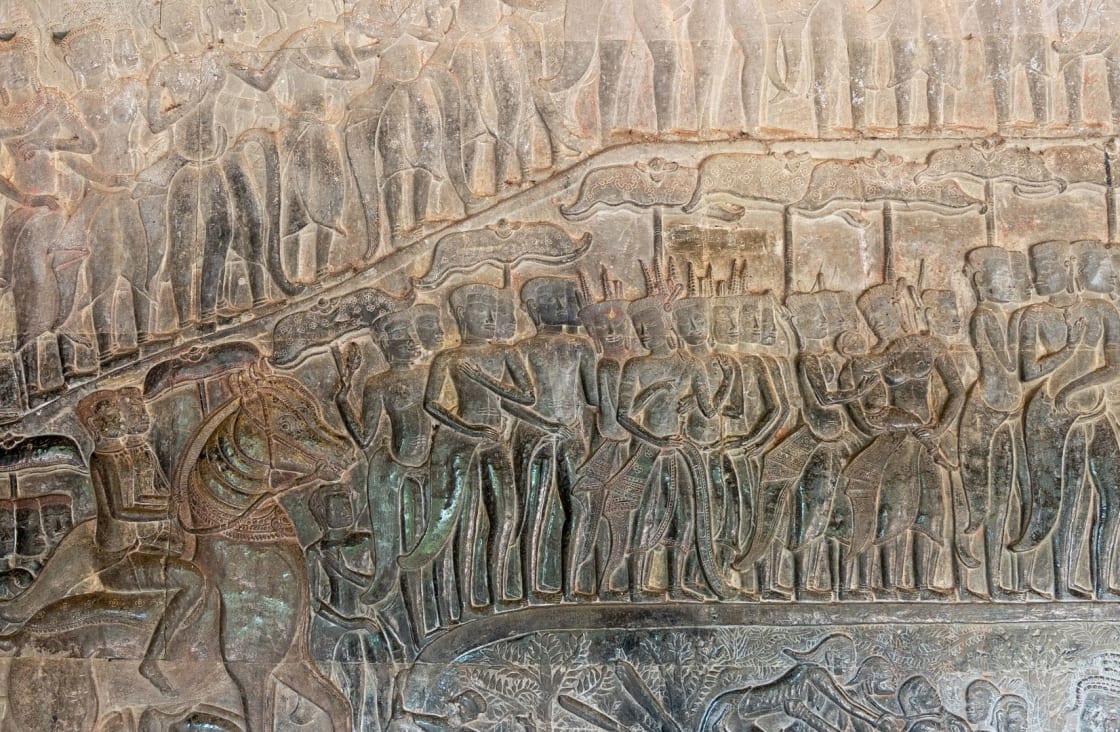
3. Heaven & Hell
The punishments and rewards of the 37 heavens and 32 hells are depicted in the eastern half of the south gallery. On the left, the upper and middle tiers show fine gentlemen and ladies proceeding towards Yama, the 18-armed judge of the dead, seated on a bull; below him are his assistants, Dharma and Sitragupta.
On the lower tier, devils drag the wicked along the road to hell. To Yama’s right, the tableau is divided into two parts by a horizontal line of garudas. The elect dwell in beautiful mansions, served by women and attendants; while the condemned suffer horrible tortures that might have inspired the Khmer Rouge.
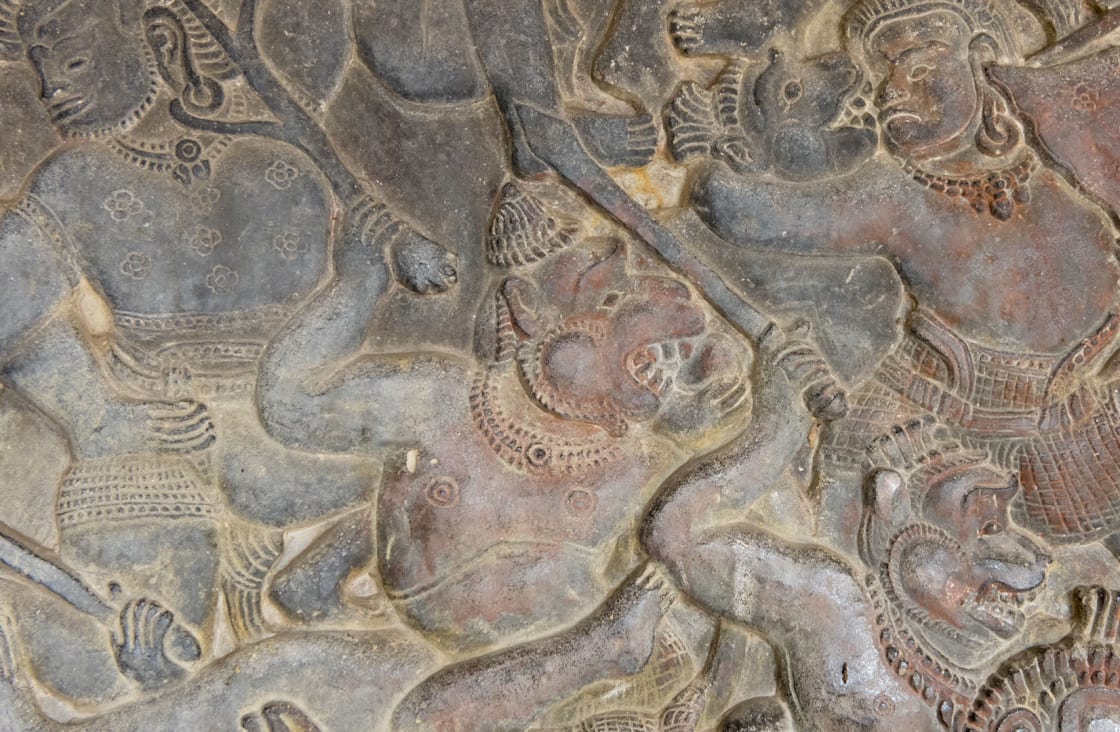
4. Vishnu Conquers The Demons
The northern section of the east gallery at Angkor Wat shows a furious and desperate encounter between Vishnu, riding on Garuda, and innumerable devils. Needless to say, he slays all comers.
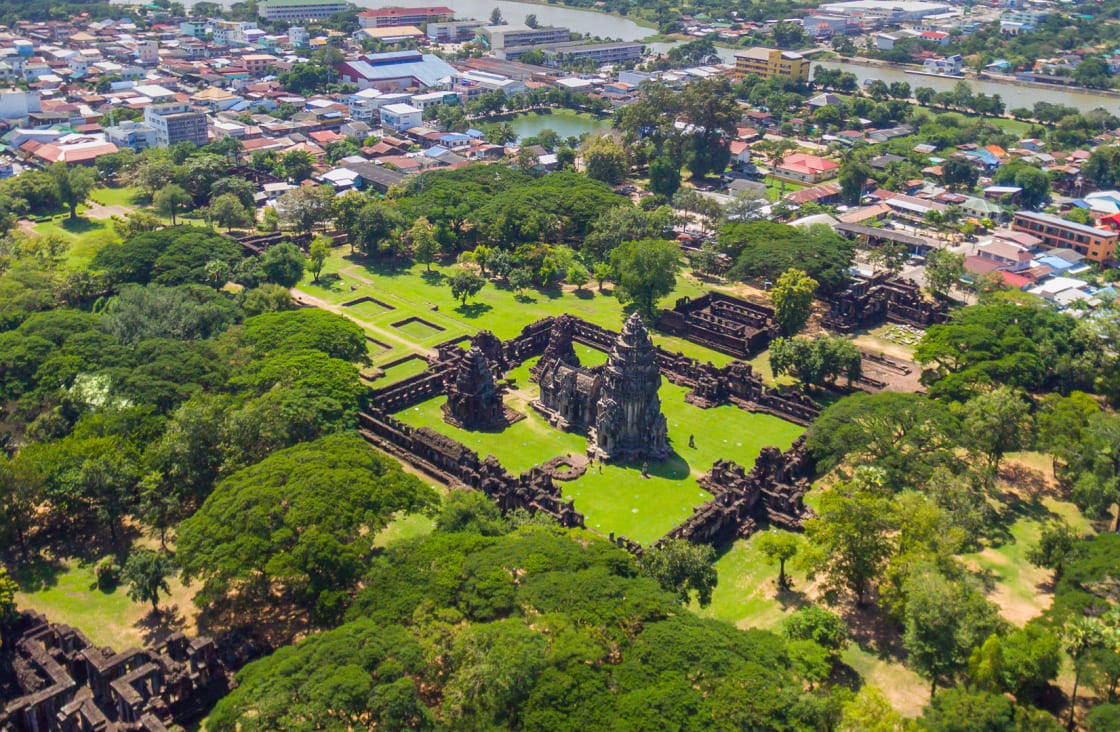
5. Journey To The Center Of The Universe
The spatial dimensions of Angkor Wat coincide with the links of the four ages of classical Hindu thought. Therefore, one of the mystical things to do at Angkor Wat is to walk from its outer causeway through the main entrance and courtyards to its highest tower. This is a symbolic journey to the beginning of the creation of the universe.
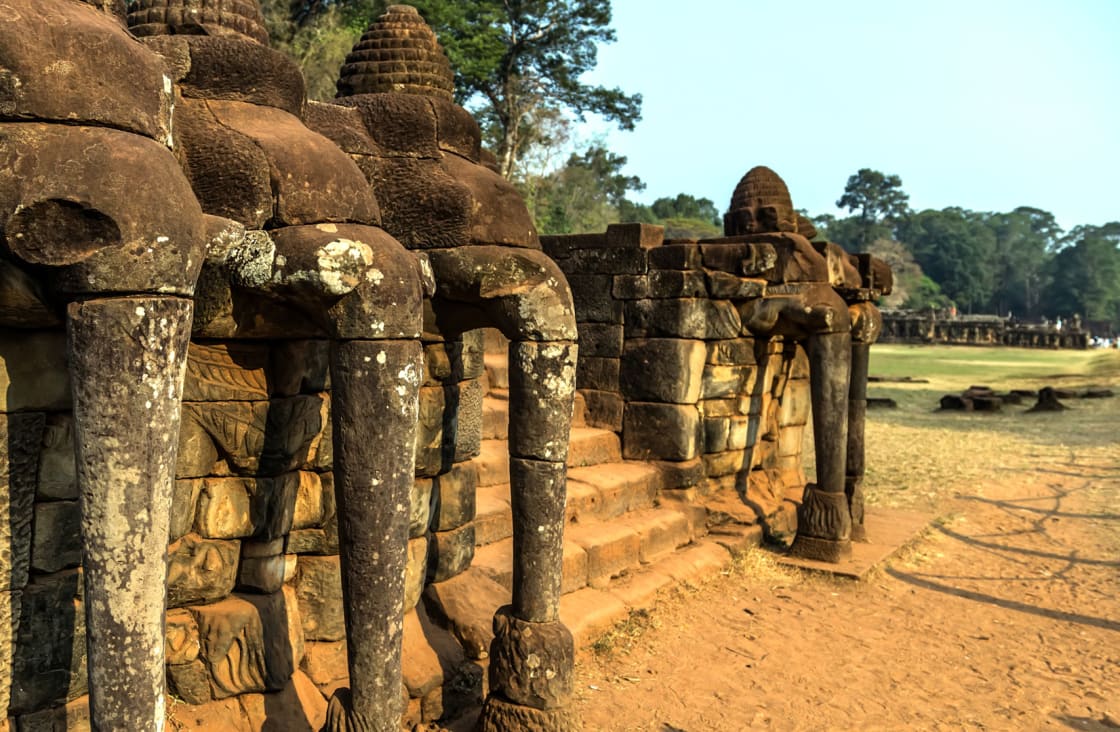
6. Elephant Gate
This gate at Angkor Wat, which has no stairway, was used by the king and others for mounting and dismounting elephants directly from the gallery.
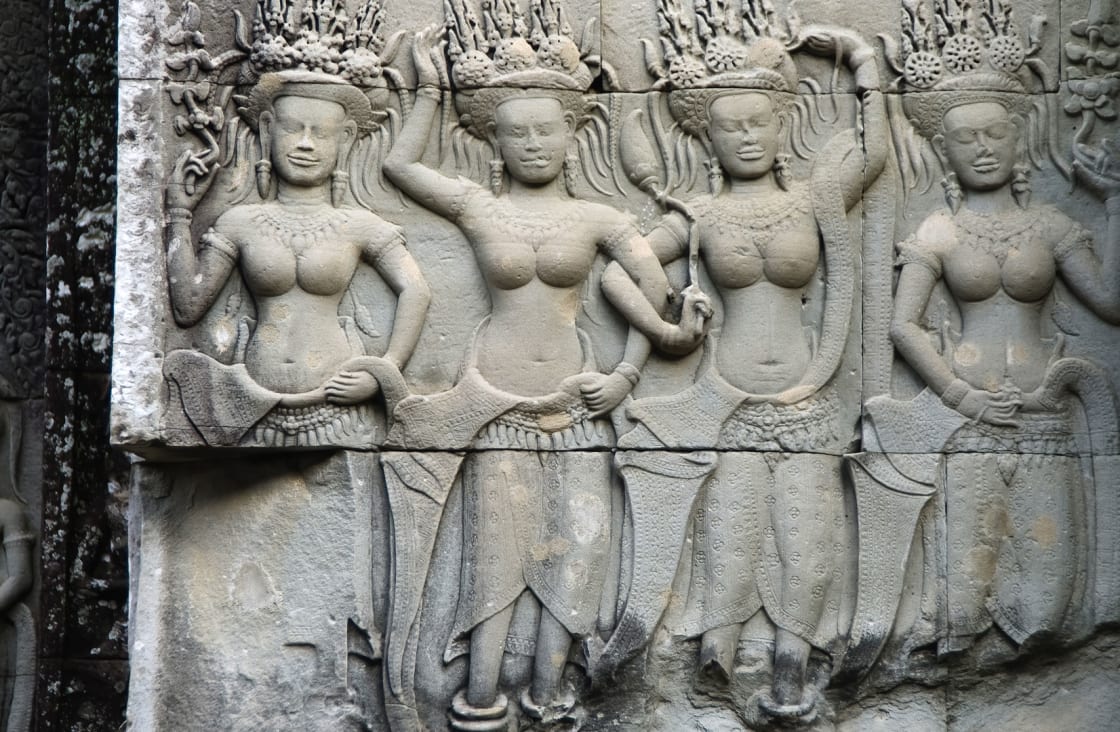
7. The Seductive Nymphs!
Angkor Wat is famous for having over 3000 enchanting apsaras − heavenly nymphs − carved into its doors and walls, each one unique. Thirty-seven different hairstyles are represented in total.
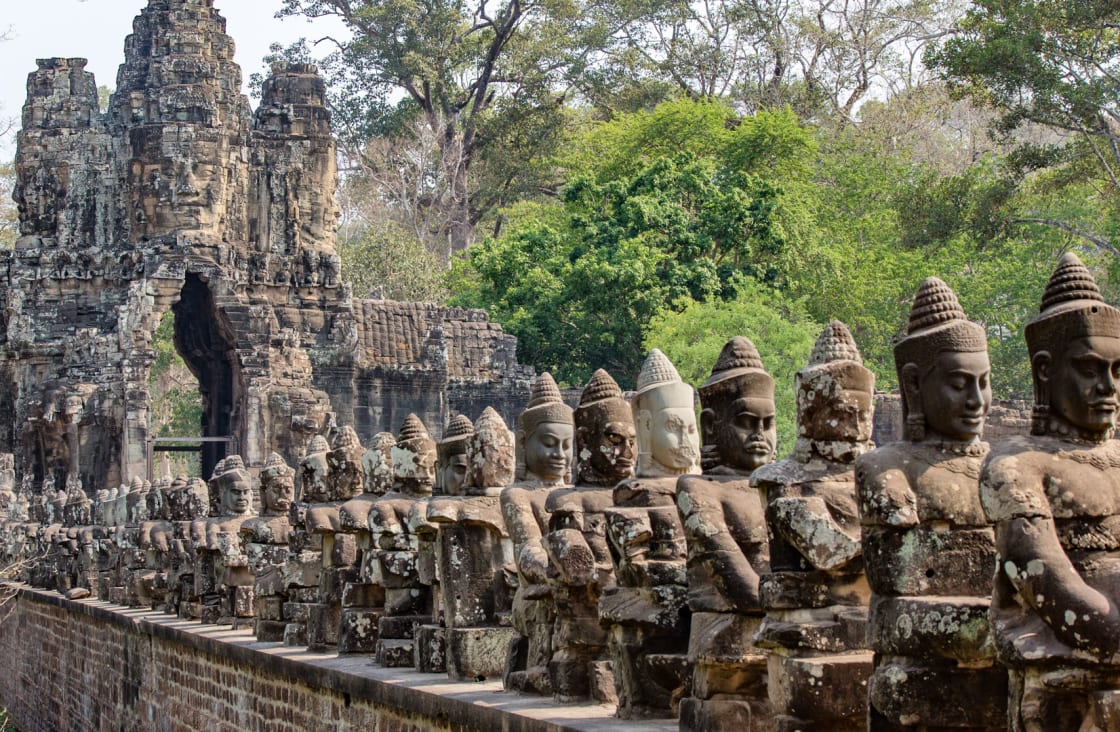
8. Angkor Thom
Make sure you visit the fortified city ruins of Angkor Thom, which is as famous as Angkor Wat. It was built a hundred years after Angkor Wat and is known as the last capital of the Angkor empire , surrounded by stone walls and canals.
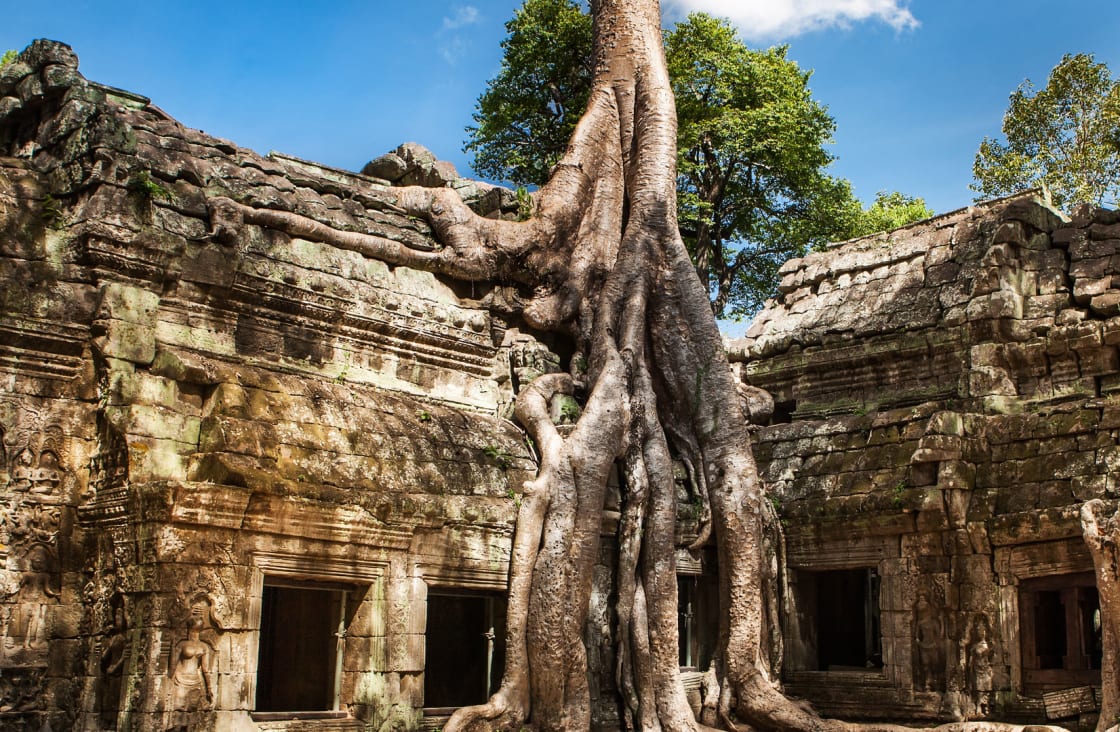
9. Ta Prohm
Stroll around Ta Prohm, where the roots of ancient strangler figs and kapok trees are reclaiming the site by growing into and out of the ruins. It is a mysterious, seductive vision of ancient architecture and nature intertwined. The main tree has become a symbol of love, it is said that couples will love each other forever if they take a photograph together underneath it.

10. The View Of Angkor Wat From Bakheng Hill
Most visitors only come to Bakheng Hill for the view, with the temple’s different levels acting like tiered seating for those enjoying the sunset and, to a lesser extent, the sunrise. It’s quite a climb to get to the top, and the steps near the summit are very narrow. There is a road up the hill to a clearing short of the summit. Angkor Wat can be seen a short distance away in the jungle.
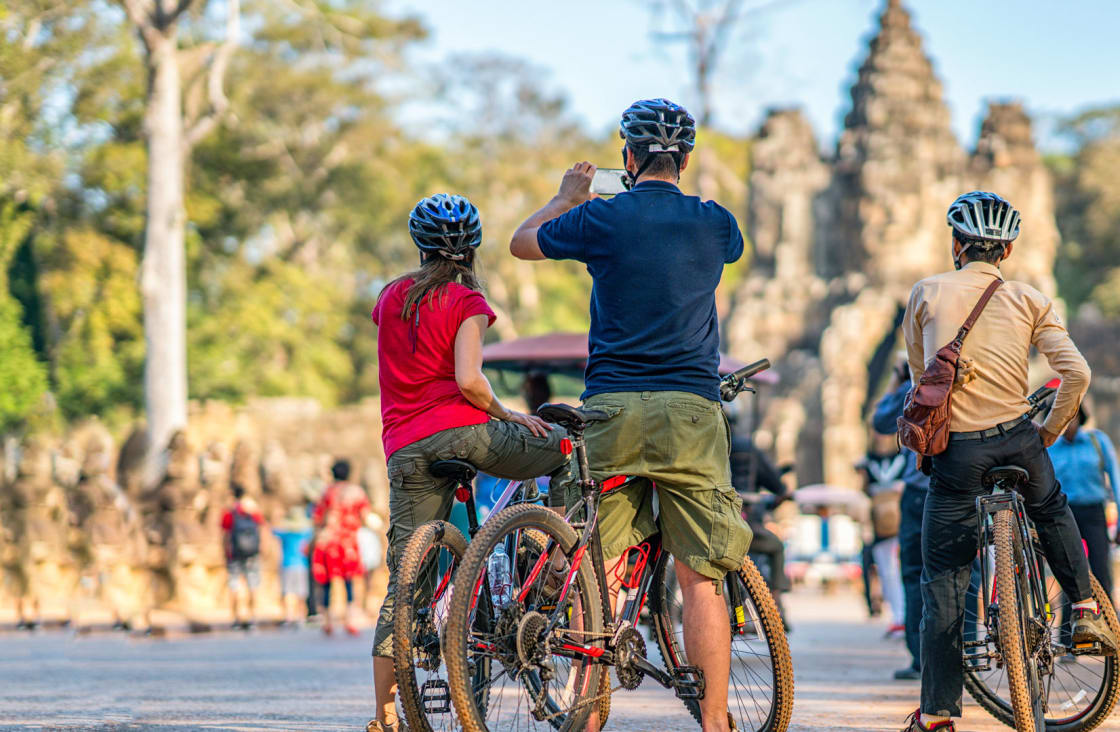
11. Touring Angkor Wat By Bicycle
A guided cycling tour of the Archaeological Park of Angkor will give you a very special insight into the landscape, culture and history of Cambodia, and is an ideal way to embrace responsible tourism. With your bicycle, you will feel so close to the life of the people and the surroundings while cycling on the small dirt roads and jungle paths that bypass the main tourist routes.
Most organized tours will enable you to explore the major temples of Angkor including Angkor Thom, Bayon, and Ta Prohm − where the movie Tomb Raider was filmed, as well as various smaller temples depending upon your preferences. Lunch is usually included. If you choose the sunset option, you will continue to the pyramid of Pre Rup to watch what is usually a majestic view of a red sky with the sun going down in the picturesque environment of the temples and the rice fields of the East Baray.
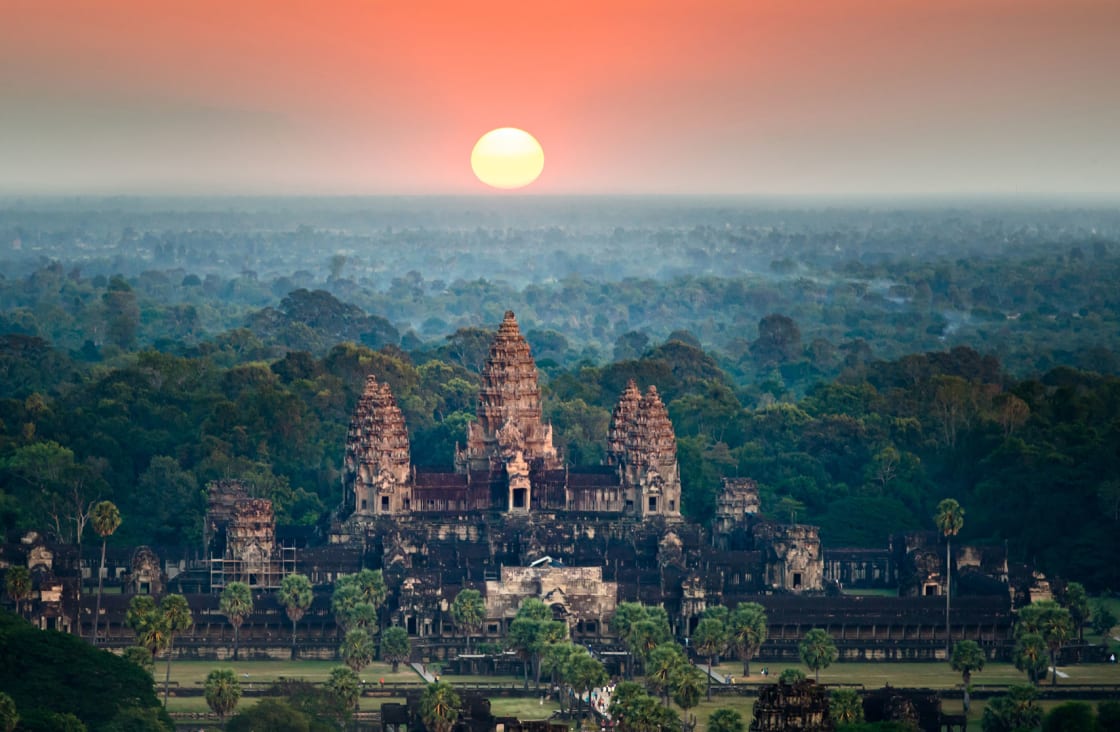
12. Seeing Angkor Wat From A Helicopter
A helicopter ride is a magnificent way to see the grandeur of Angkor Wat and allows you to really appreciate the scale of the temple complex, which is not easy to comprehend from the ground. Naturally, you cannot land at each individual temple to walk around it, so this option is perhaps better combined with a land tour.
Most trips also take you over Tonle Sap Lake – which is also best seen from high up so that you can appreciate its size – making a helicopter journey a good way to get a general overview of Siem Reap’s star attractions.
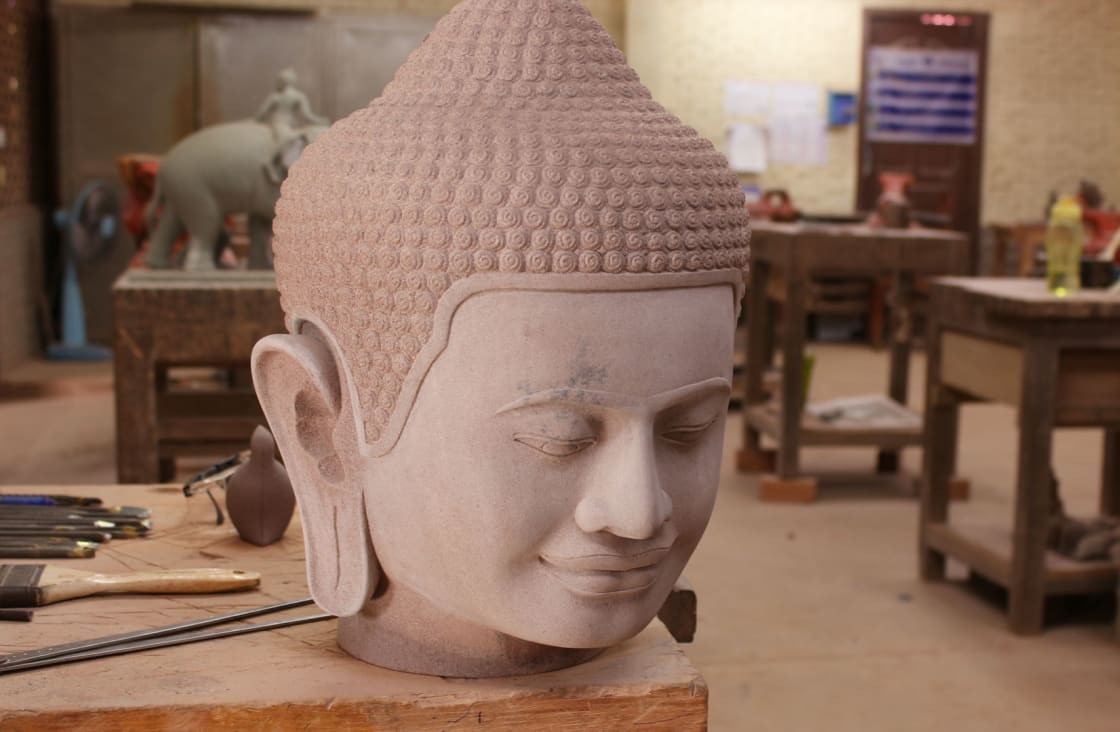
13. Artisans Angkor
This is a small branch of the impressive Artisans Angkor initiative, which aims to revitalize the handicraft industry around Siem Reap and Angkor. Prices are high compared with local markets, but the shop is mercifully air-conditioned, and the quality of workmanship is impressive.

14. Psar Chaa
Get the local experience at Psar Chaa, the Old Market in Siem Reap’s city center. This dense, maze-like indoor market is crammed with stalls selling everything you could possibly imagine. Locals come here to shop for food and household items but there is also a large section where you can find clothes, shoes, jewelry and a lot more. If you’re hungry, head to the center of the market where you can find authentic Cambodian dishes .
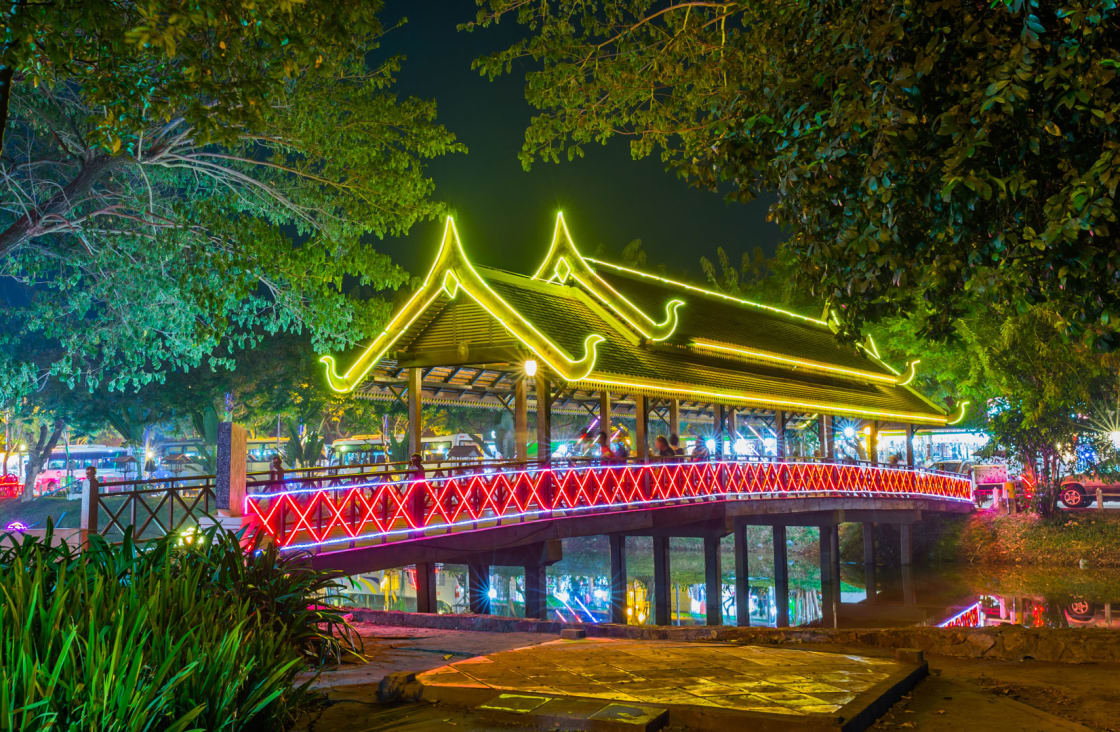
15. Angkor Night Market
Siem Reap’s original night market near Sivatha Street has sprung countless copycats, but it remains the best and is well worth a browse. It is packed with stalls selling a variety of handicrafts, souvenirs, patterned silks and shimmering jewels. Island Bar offers regular live music and Sombai offers infused organic rice wines if you decide to make a night of it.
While Rainforest Cruises aim to provide accurate and up-to-date information, we make no representations as to the accuracy or completeness of any information herein or found by following any link on this site. Rainforest Cruises cannot and will not accept responsibility for any omissions or inaccuracies, or for any consequences arising therefrom, including any losses, injuries, or damages resulting from the display or use of this information.
You may also like
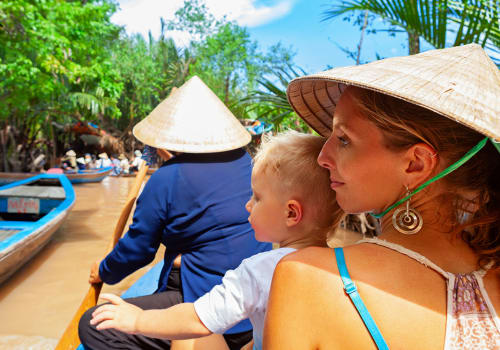
Mekong River With Kids: Top 5 Things To Do With The Family
The contrasting landscapes and cultural complexities of the lush Mekong River Delta in Vietnam layers one iconic scene upon another: rice fields; orchards laden with exotic fruits; farmers and fishermen in classic […]
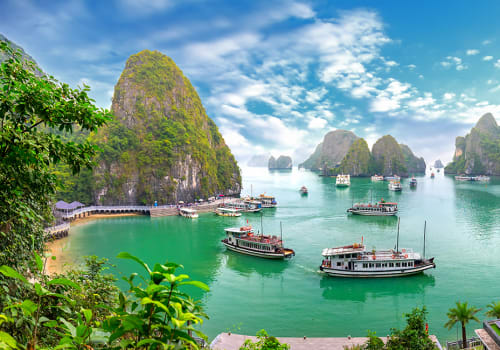
When Is The Best Time To Visit Halong Bay?
With a mind-blowing landscape of limestone karsts emerging from the emerald waters of the Gulf of Tonkin, Halong Bay ranks among the most impressive tourist attractions of Southeast Asia and is guaranteed […]

Cambodia Honeymoon Guide: Dream Destinations & Resorts
Cambodia is one of the world’s most exciting honeymoon destinations; its reputation grew around a breathtaking ancient wonder, but this buzzing country also offers lively cities, lots of incredibly romantic accommodation, adventure-filled […]

Cambodia With Kids: Top 12 Things To Do With Family
Cambodia offers families the perfect blend of rich culture, awe-inspiring ruins, friendly villages, remote jungle and tropical palm-fringed beaches. Here are some of the top things to do and the best places […]
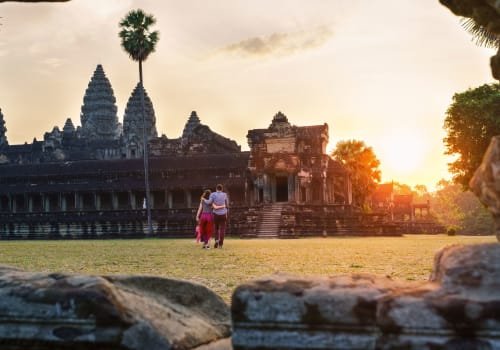
Angkor Wat Honeymoon: Romantic Siem Reap Hotels & Activities
Deciding on a perfect honeymoon destination is one of the most important decisions you will make as an about-to-be-newly-wedded couple. Where will you choose to go if you want to feel like […]
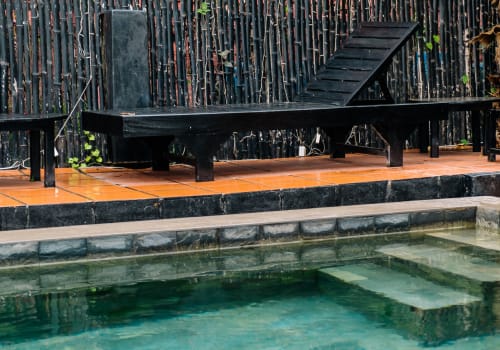
Where To Stay In Siem Reap: The Best Hotels & Areas
Siem Reap is a bustling town in northwest Cambodia on the edge of the Tonle Sap Lake. It acts as the jumping off point to visit the majestic Angkor Archaeological Park, which […]
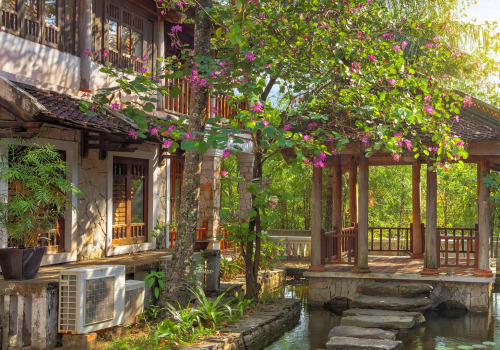
Where To Stay In Cambodia: The Best Hotels & Areas
Rich in both culture and history, Cambodia is a symbol of raw beauty and resilience. Despite the country’s horrific past, tourists are welcomed everywhere. Marvel at the many temples, including the legendary […]

Angkor Wat With Kids: 12 Top Tips And Things To Do With Family
Entering the Angkor Wat complex and seeing the lost city and the temple ruins for the very first time is a magical, awe-inspiring, rewarding experience that you and your children will remember […]
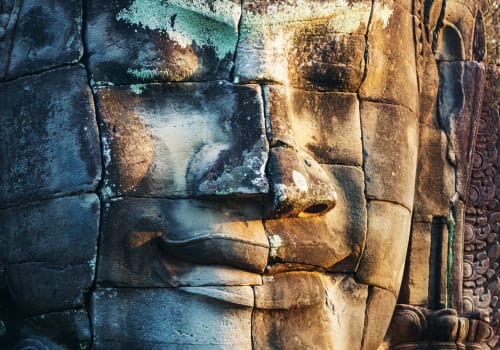
The Top 10 Tourist Attractions In Cambodia That You Have To See
As it slowly recovers from the Khmer Rouge’s reign of terror, Cambodia is becoming a rising tourist destination. The stunning temples of Angkor are the obvious draw for most visitors, but the […]
On the Lookout for Expert Advice & Offers?
Join over 20,000 discerning travelers and be the first to receive our monthly exclusive discounts, inspiring travel content and expert tips, straight to your inbox.

- Charter (Private)

National Geographic content straight to your inbox—sign up for our popular newsletters here
- WORLD HERITAGE
Soar Over Cambodia's Stunning Stone City
The ancient capitals of the Khmer Empire house some of the most remarkable architectural and artistic accomplishments of the ancient world.
Deep in the forests of Cambodia ’s Siem Reap province, the elegant spires of an ancient stone city soar skyward above the sprawling complex of Angkor Archaeological Park .
The Khmer Empire’s various capitals thrived here from the 9th to 15th centuries, while their rulers presided over an empire that stretched from Myanmar (Burma) to Vietnam. Including forested areas and newly discovered “suburbs” Angkor covers more than 400 square kilometers.
Though just one of hundreds of surviving temples and structures, the massive Angkor Wat is the most famed of all Cambodia’s temples—it appears on the nation’s flag—and it is revered for good reason. The 12th century “temple-mountain” was built as a spiritual home for the Hindu god Vishnu. The temple is an architectural triumph laden with artistic treasures like the bas-relief galleries that line many walls and tell enduring tales of Cambodian history and legend.
In other parts of Angkor such art depicts scenes of daily life—offering scholars a precious window into the past.
Related: 12 Beautiful Scenes of Cambodia

One tale Angkor’s artists and scribes did not tell, however, is why the city’s rulers abandoned the site and resettled near modern Phnom Penh. Theories include defeats in battle and shifting religious observances, (because the Khmer’s Hinduism was gradually replaced by Theravada Buddhism during the 13th and 14th centuries), but the mystery has puzzled scientists for centuries.
Angkor is as much about water as it is about stone—the site boasts an enormous system of artificial canals, dikes, and reservoirs, the largest of which (West Baray) is 5 miles (8 kilometers) long and 1.5 miles (2.4 kilometers) wide. These incredible feats of engineering form an integral part of an overall site design that remains faithful to religious symbolism. Moats, for example, simulate the oceans surrounding Mount Meru, the home of Hindu gods.
But these massive works also served a practical purpose by skillfully harnessing river and rainwater to quench the thirst of some 750,000 residents in the world’s largest preindustrial city. That water also irrigated wealth-producing crops like rice, which served the Khmer as currency.
Some scholars speculate that the downfall of this elaborate water system led to the end of Angkor. A series of weak monsoons and/or the collapse of the water works due to environmental issues, like deforestation, which drove destructive floods and choked the system with sediment, might have tipped the movement of power toward Phnom Penh.
Even after its glory days had passed, Angkor remained popular with Buddhist pilgrims who journeyed from across Southeast Asia and beyond. Today the site also draws secular travelers—almost a million a year.
When Angkor was named a World Heritage site in 1992 it was also added to the List of World Heritage in Danger; the incomparable site was threatened by pillaging, plagued by illegal excavations, and even dotted with land mines. In 1993 UNESCO launched a major campaign to restore and safeguard Angkor. Thanks to a textbook case of international cooperation Angkor rebounded so dramatically that it was removed from the List of World Heritage in Danger in 2004. [Related: 25 World Heritage Sites in Danger ]
UNESCO continues to be a part of Angkor’s future, working with the Cambodian authorities to ensure that tourism access and development do not compromise this great cultural treasure.

Strangler fig trees and creeping lichens devour ruins at Ta Prohm at Angkor, once home to hundreds of monks.
How to Get There
The nearby town of Siem Reap can be reached via good roads from Phnom Penh and buses and taxis make the trip regularly. Those preferring to travel by boat can also make the trip from Phnom Penh in some five or six hours—about the same travel time as by road. The airport in Siem Reap has service to Phnom Penh and regular flights abroad to Thailand, Singapore, Vietnam, and Laos.
How to Visit
The fast-growing town of Siem Reap is the gateway to Angkor and is filled with lodging, dining, and tour-package options for all budgets and inclinations. Tour buses are available for those whose itineraries match what’s on offer—typically visits to Angkor’s major sites. Those interested in exploring more remote and off-the-beaten-track structures may hire cars or motorbikes with drivers and/or guides who are also able to suggest itineraries. Tethered balloon rides offer a unique aerial perspective from which to view the grand design of the Angkor complex.
When to Visit
Peak tourist season in Angkor is December and January, when rainfall is less likely and the climate is most kind. Temperatures can soar in spring and typically peak in April before the May/June monsoon season. Travel during the monsoon can be uncomfortable. The post-monsoon rainy season continues until October, but rains are sporadic and shouldn’t deter well-prepared visitors, though some remote roads can wash out late in the rainy season.
- Nat Geo Expeditions
FREE BONUS ISSUE
Related topics.
- WORLD HERITAGE SITES
- ARCHITECTURE
- ANCIENT CIVILIZATIONS
- ARCHAEOLOGY
You May Also Like

20 of the coolest travel adventures for 2024

See these 6 architectural wonders before they disappear

Inside the secret world of the Hopewell Mounds—our newest World Heritage site

See the summer solstice from a Roman emperor’s party cave

Searching for traces of the ancient Chola dynasty
- Environment
- Perpetual Planet
History & Culture
- History & Culture
- History Magazine
- Mind, Body, Wonder
- Paid Content
- Terms of Use
- Privacy Policy
- Your US State Privacy Rights
- Children's Online Privacy Policy
- Interest-Based Ads
- About Nielsen Measurement
- Do Not Sell or Share My Personal Information
- Nat Geo Home
- Attend a Live Event
- Book a Trip
- Inspire Your Kids
- Shop Nat Geo
- Visit the D.C. Museum
- Learn About Our Impact
- Support Our Mission
- Advertise With Us
- Customer Service
- Renew Subscription
- Manage Your Subscription
- Work at Nat Geo
- Sign Up for Our Newsletters
- Contribute to Protect the Planet
Copyright © 1996-2015 National Geographic Society Copyright © 2015-2024 National Geographic Partners, LLC. All rights reserved
Visit Angkor Wat: An Epic Travel Guide (Temples & Map)
A visit to Angkor Wat is something you’ll never forget. It’s massive. It’s impressive. It’s an amazing complex of well-preserved scattered temples and wats that showcase Khmer culture and beauty. The temples of Angkor Wat make up what is referred to as Angkor Archeological Park, which if you don’t know, is an explorer and history buff’s paradise.
From the well-known temples of Bayon (face temple) and Ta Prohm (tomb raider temple) to the lesser-known temples of Angkor Wat, we’ll provide you with a comprehensive travel guide so your visit to Angkor Wat is seamless. Be it information on Angkor Wat tickets, the best time to visit, or how to get there and around Angkor Archeological Park, we’re here to be your Angkor Wat guide.
Visiting Angkor Wat Temple & Travel Guide
Pin & Save For Later!
Jump Ahead To:
Angkor Wat Temple Facts
It’s always nice to understand what you’re about to experience, isn’t it? Below is a short but helpful list of essential Angkor Wat facts so you understand the basics before you arrive. Looky, looky whose coming prepared!
- Constructed in the early 12th century by the Khmer King Suryavarman II, Angkor Wat is one of the largest religious monuments in the world.
- The former Hindu, now Buddhist Wat, sits within a 400 square kilometers (154 square miles) complex that is known as Angkor Archaeological Park.
- Angkor Archaeological Park houses the remains of not only Angkor Wat itself, but the remains of the entire Khmer Empire dating back to the 9th – 15th centuries.
- The name “Angkor Wat” means “Temple City” or “City of Temples”.
- In the 15th century, the Khmer Kings abandoned their sprawling city and Angkor Wat laid forgotten for centuries. It wasn’t until a French explorer by the name of Henri Mouhot, rediscovered the Khmer city in 1860.
- In the early 1900’s the French established a commission to begin restoring Angkor Wat. To this day, restoration efforts are still underway, and a portion of ticket sales go to these restoration efforts.
Check out our Cambodia Travel Itinerary right here!
Where Is Angkor Wat & How To Get To There
The entire Angkor Wat Archeological Park complex is about 162.6 hectares / 401 acres in size and is located about 15 minutes (5.5 km / 3.5 mi) northwest of the city center of Siem Reap in Cambodia.
If you are not in Siem Reap yet, no worries. Siem Reap has an international airport (REP) so you can easily catch a flight into the city. Alternative options are to travel overland by bus . If you’re coming from Phnom Pehn or neighboring Thailand, there are loads of overland bus options for you to reserve and book. Once in Siem Reap, you’ll find no shortage of transportation options and guided tours that will happily whisk you to, from, and around Angkor Wat.
Best Way To Get Around Angkor Wat
If you are not planning on booking a tour of Angkor Wat, you have a handful of options on getting you not only to but around Angkor Wat.
A tuk-tuk from Siem Reap to Angkor Wat is the most popular option to take tourists to, from, and around Angkor Wat. You can easily hire a tuk-tuk for the day (or half-day) directly with a driver on the streets of Siem Reap, through your accommodation or local tour agency. Trust us, once you get into Siem Reap, you’ll see the plethora of Tuk-Tuk drivers offering their services to take you and your companions to visit Angkor Wat.
A round-trip Angkor Wat tuk-tuk price will cost you anywhere from $15 – $20 USD per day. If you pay closer to the $25 range, that is a little on the higher end, but up to you how much you want to haggle.
TIP: If you book a tuk-tuk with a driver on the street (like we did), do not pay him upfront. Wait to pay in full till the end of your trip. Regardless of who you book a tuk-tuk ride through, make sure the temples you want to see and how long you have the tuk-tuk for are clearly communicated and agreed upon upfront.
Private Van
Another option on how to get to and around Angkor Wat is booking a private van. Private vans provide air-conditioning and much more comfort than tuk-tuks. Also, you also have the nicety of having a tour guide accompany you as well.
To book a private van tour from Siem Reap to Angkor Wat, check out this private van tour here .
Bicycle Or eBike
The most cost-effective transportation option from Siem Reap to and around Angkor Wat is renting a bicycle. However, this is also the most labor-intensive. Temperatures in Siem Reap can be very hot and humid so please remember to stay hydrated while you cycle.
Also, to avoid any hiccups along the way, make sure the bike is sturdy. We’d hate for you to lose a tire along the way. Hey, it happens! Bicycle rentals vary but around $5 USD per day is average. A handful of accommodations have free bicycle rentals for guests and bike shops in Siem Reap offer day bike rentals.
Speaking of day rentals! An alternative to bicycling is getting a little assistance while you do it. eBike rentals are also available in Siem Reap. Regardless of how you choose to get to and around Angkor Wat, just know that walking isn’t an option.
Be sure to check out our 22 things to know before you travel to Cambodia here!
Angkor Wat Entrance Fees & Hours
When planning your visit to Angkor Archaeological Park you’ll need to determine how much time you want to spend in the park. You have three ticket options, each offering visitors different lengths of time:
- 1-Day Angkor Pass – $37
- 3-Day Angkor Pass (valid for 1 week) – $62
- 7-Day Angkor Pass (Valid for 1 month) – $72
Angkor Wat is open daily from 5:00am to 6:00pm . Whereas Phnom Bakheng and Pre Rup Temples are open from 5:00 am to 7:00 pm , and all other temples open at 7:30 am and close at 5:30 pm .
Angkor Wat Tickets – Additional Things To Know
- Children 12 and under can enter for free but must show a passport for proof of age
- Park tickets issued after 5 pm are valid for the next day
- The above 1, 3, and 7-day tickets options include entrance to all temples except Kulen Mountain and Bengmealea temple
- There is no ticket discount for groups
- All tickets require a photo of you, this ensures you cannot resell your ticket to another individual
- You can pay for your Angkor Wat ticket in cash or with a credit card (Discover, Visa, Mastercard)
Where To Buy Angkor Wat Tickets
Please understand that you can ONLY buy your Angkor Wat ticket from the Ticket Office Box. The Ticket Box office is not all that convenient to get to – 15 minutes from Siem Reap and 15 minutes from Angkor Wat. Tickets bought elsewhere are considered fraudulent Angkor Passes.
The ticket box office for Angkor Wat opens at 5:00 am and it would be in your best interest to get there before opening – around 4:30 am or 4:45 am. The ticket line can be loooong and if it’s too long, you could miss that beautiful sunrise you’re trying to get to. Luckily, there are about 20 window clerks cranking out tickets for tourists so your wait shouldn’t be too long, especially if you are one of the first in line.
Even though it takes about 15 minutes to get from Siem Reap to Angkor Wat, you need to take into consideration the amount of time it takes to get from Siem Reap to the Ticket Office, and then to Angkor Wat. On average, it takes around 30 minutes to get to and from all three, however, you’ll also need to take into consideration the time it will require you to buy your tickets. This is important when trying to plan for sunrise.
An alternative option is to buy your tickets the night before . Any tickets sold after 5:00 pm are valid for the next day . The ticket office closes at 5:30 pm so be sure to arrive around 4:30 pm to allow yourself the time you need to get in line and buy your ticket. Whatever you do, DO NOT BUY your ticket till after 5:00 pm. If you buy tickets before 5:00 pm, they’ll count for the current day and will not be valid for the next day.
Get our take on a perfect Angkor Wat itinerary right here!
Ticketing Check Points and Angkor Wat Ticket No-No’s
Whatever you do, don’t lose that Angkor Wat ticket of yours, and always make sure to have it on you. Why? It’s common to have your ticket checked by security at the entrance of certain Angkor temples.
If you lose, tear, or damage your ticket in any way, you’ll be required to purchase a new ticket at full price in order to gain access to the temples of Angkor Wat. Angkor Wat tickets are non-transferable and not meant to be resold. If you get caught selling your Angkor Wat ticket to another individual, you’ll pay a hefty fine.
Best Time To Visit Angkor Wat
January to May and then November to December are the best months to visit Angkor Wat. June to October is hit-and-miss months. During the months of June through October, the monsoon season is in full swing making walking around outside or seeing the Angkor Wat sunrise a bit of a challenge.
Regardless of which month you plan to visit, just make sure to start your day early. It gets extremely hot and humid in Cambodia so do your best to avoid sightseeing during mid-day. Plus, the early bird gets the worm as they say. Morning is not only great lighting for photos but tends to be a little lighter on the crowds.
How Long Do You Need To Visit Angkor Wat
How do you know which ticket option is best for you when visiting Angkor Wat? Well, it’s a personal preference. Our recommendation is to buy a one-day or three-day pass. Ask yourself the below questions and we promise, it’ll help you decide.
- Short On Time: Get you that one-day pass to Angkor Wat.
- Have A Few Days: Go on and buy that three-day pass or hell, the week pass if you have the time.
- Tight On Money: The one-day pass is $37 per person so even on a budget, that’s pricy.
- Have Some Funds to Spare : The three-day pass is going to set you back $62 per person but if you have the time, it’s worth it.
- Only The Highlights, Please : One-day pass for sure.
- Let Me See It All: If you are a history buff and seriously love ancient ruins and temples, then there are plenty of sites to keep you occupied. Get that three-day or seven-day pass.
Do You Need A Guide To Visit Angkor Wat?
First, understand that you do not need to book a tour to experience and visit Angkor Wat. Booking your own transportation and determining what Angkor Wat temples you want to see can be completely done by yourself.
However, take it from us, we got SO much more out of our visit by having a guided tour of Angkor Wat. You can reserve a guided tour of just Angkor Wat or look to book a guided tour through the entire park so you can get the history of each Angkor Wat temple you wish to visit.
Angkor Wat Tour Routes – The Grand Circuit and The Small Circuit
Alrighty, so what we’ve come to learn about Angkor Wat is there are established tour routes referred to as The Grand Circuit or The Short Circuit. While these are established routes, they are also totally customizable, especially when you hire your own Tuk-Tuk driver or book a private tour to take you around the park.
Before paying for either the Tuk-Tuk or the private tour , BE SURE to agree on any modifications you’d like to make to the below routes to ensure you see the Angkor temples you want to see. Having these conversations upfront ensures you are not surprised later by either having to pay more or risk not seeing a temple you had your heart on exploring.
The Small Circuit Tour
Great for those who only have one day in the park. The Small Circuit route covers the major highlights of Angkor Wat Archeological Park.
- Bayon Temple
- Baphuon Temple
- Terrace of the Elephants
- Banteay Kdei
Two popular guided tour options are to start the Small Circuit tour with sunrise or to start a little later to experience the Small Circuit with sunset . Whichever you decided, you’ll be whisked around Angkor Wat temples and shown some of the very best Angkor Wat has to offer.
There are two other Angkor temples that sometimes are or are not included in these routes, it just depends on your tour guide or Tuk-Tuk driver. But if of interest, it’s worth seeing if you can add Srah Srang and Phnom Bakheng to your Small Circuit route.
The Grand Circuit Tour
Unlike the Small Circuit route, the Grand Circuit route (also called the Big Circuit) includes a handful of Angkor temples on the outskirts of the complex. The below list of Angkor temples is often less visited by tourists when compared to the temples on the Small Circuit.
- Neak Pean (or Neak Poun)
- Banteay Prei
- Banteay Srei
- Banteay Samre
- Pre Rup
If you are looking to experience the temples on both the Small Circuit and Grand Circuit , you can coordinate with a Tuk-Tuk driver or look into booking a tour like this one , where over two days you’ll be whisked around Angkor Wat and the most popular set of temples. Or, if you’re just wanting to explore the Grand Circuit route, this is a great guided tour to check out.
Angkor Wat Temples Not To Miss
So now, with all the route talk said and done, really and truly the temples you want to see are up to you. We worked with our tuk-tuk driver and pulled from both the Small Circuit and Grand Circuit to see the temples we wanted to see.
Fair warning, there are several hundred temples and ruins that lay within the boundary of Angkor Archeological Park. Yes, that’s indeed a lot and can become a bit overwhelming when looking to find the best temples to visit in Angkor Wat. Below are not only the most popular Angkor Wat temples to visit , but the below also cover the most beautiful park highlights as well.
- Sunrise at Angkor Wat
- Angkor Thom
- Sunset at Pre Rup
Be sure to coordinate with your Tuk-Tuk driver to ensure the temples you want to see are understood and included in the price they give you. Same for a private tour , work with the tour company to ensure you see what you want to see.
Where To Watch Sunrise At Angkor Wat
Alright, being honest, there really is only a handful of places you should consider for sunrise. Also, it’s important to mention that not all Angkor Wat temples are open at the same time. So really, your options are limited as to where you can watch the sunrise.
If you are wanting to catch a sunrise at a temple not listed below, be sure to check its hours to make sure you can access the temple during the early hours of the morning.
- Angkor Wat Reflection Pond (Open at 5 am ): The most popular choice for sunrise in Angkor Wat is to see the sunrise over Angkor Wat and as the sky illuminates, watch the pond in front of Angkor Wat give a wonderful reflection of the scene appearing in front of you. Just know, sunrise here is BEYOND crowded. You will be shoulder to shoulder with people striving to see the same view as you, that famous Angkor Wat reflection pool sunrise. So, if you want to get a good seat, arrive early and hold your own as tourists begin to arrive.
- Pre Rup (Open at 5am): Pre Rup opens early for visitors to climb to the top for sunrise where you can find a spot to perch and watch the sunrise over the ruins and jungle below.
- Phnom Bakheng (Opens at 5am): Another option to watch the sunrise at Angkor Wat is Phnom Bakheng. This temple offers a high vantage point with views of Angkor Wat in the distance.
Get our tips for catching the sunrise at Angkor Wat!
Where To Watch Sunset At Angkor Wat
Like sunrise, only a handful of temples are open late enough in the evening for you to catch a sunset. Three of the most popular places to watch the sunset in Angkor Wat are listed just below.
- Pre Rup (Closed at 7pm): In the direction the sun sets, you’ll be watching it dip below a jungle tree line, but nonetheless, it’s pretty cool to watch the sunset from the top of an Angkor temple. Pre Rup is a close second to the most popular temple for an Angkor Wat sunset.
- Phnom Bakheng (Closes at 7pm): The most popular location in Angkor Archeological Park for sunset is Phnom Bakheng. Fair warning though, there are only 300 people allowed at a time in the temple to watch the sunset. So, if your heart is set to watch the sunset here, arrive a few hours early to not only get temple access but a good spot.
- Srah Srang (Closes at 5:30pm): Popular for sunset as the light and colors of the sky will light up the reservoir or Royal Bath that makes up Srah Srang.
Regardless of if you want to see the sunrise, sunset, or both, BE SURE to check the weather . If the forecast calls for rain or overcast, you might be out of luck. We’d hate for you to wake up early and not get to see the sunrise over Angkor Wat.
Angkor Wat Dress Code
Yes, these temples are ruins but that still doesn’t mean you can dress how you want. These are active religious sites still used by practicing Buddhist and Buddhist monks. So, your behavior and attire should be respectful.
- Knees and shoulders should be covered
- Feel free to wear a tank top but just bring a sarong or scarf to cover your shoulders when entering the temples
- Shoes are accepted, no need to go barefoot
- Shorts are fine
- Keep those shoulders covered aka no tank tops
We know, we know, Cambodia is hot, and shorts and tanks are amazing for that hot weather, but these outfit choices are not appropriate clothing for Angkor Wat. Be respectful and you’ll be just fine.
What To Bring With You To Angkor Wat
- Water : It is hot, and you’ll be doing a lot of walking so make sure you have plenty of water on you.
- Day pack: You’ll definitely want a comfortable backpack to carry your items, food, and water.
- Camera : Definitely do not leave this back at your room. Also, if you have extra batteries, be sure to pack those too.
- Sunscreen : Lather up your face and body. The sun is intense and since you plan on spending a full day exploring outside, make sure you apply several times throughout the day to keep you from looking like a crispy lobster.
- Sunglasses : Again, the sun. Protect those eyes and make it easier to see.
- Hat (if needed) : Yup, the sun again. Hats help block the sun further and provide you a little shade.
- Angkor Wat Ticket : 100% don’t leave this back in your room or you won’t be getting very far.
- Bug Repellent : You’re in the jungle after all, aren’t you? Don’t make yourself a mosquito snack. Pack and apply buy spray.
- Cash: There are food stalls and restaurants in the park, bring some cash for food and tips for your tour guide or driver.
- Wet Wipes or Hand Sanitizer : Meh, it’s dusty and you’re going to touch a lot of things other people have touched. It’s nice to have some clean hands when you take a break for lunch or to eat any snacks.
- Power bank : More than likely you are going to be out all day, and no one likes it when their phone dies. Bring a power bank to keep your phone or any other gadgets charged.
- First Aid Kit : We always have one with us in our day bag. It’s SO nice pull out a Band-Aid to cover up blisters of some Tylenol when you have a headache. We don’t want you to have a cut or headache and have to go searching for relief when you could have something in your pack instead.
- Snacks : Plain and simple, no one likes to explore when they’re hungry.
Tips For Visiting Angkor Wat
- Do not ride the elephants . Just don’t. That’s animal abuse and it’s cruel so please avoid elephant rides and tours at Angkor Wat and everywhere else you travel too.
- Dress appropriately . Be respectful in your attire (cover your chest/cleavage, shoulders, and knees) if you want to gain access to temples in Angkor Wat.
- Stay Hydrated . Ya’ll we can’t stress enough how hot it can get. Just make sure you have plenty of water and more importantly drink the water.
- Plan Ahead . Know which temples or route you want to take, book tours or guides, and have a plan for when you want to buy your tickets. Laying out a plan will take any stress of your visit away.
- Wear comfortable shoes . You are going to be doing LOADS of walking, so be sure those little feet of yours are supported.
- Be Wary of Fake Tour Guide s: You may get approached by kids or adults offering to take you on a personal tour of “x” temple you are currently exploring. Politely, but assertively decline as these are not certified guides.
Angkor Wat Temple Map
Below, you’ll find an interactive map showcasing the temples traditionally shown during the Small Circuit route as well as the temples typically shown on the Grand Circuit route. Click on the map to show what temple is what as well as zoom in and out to get a feel of the space and the complex of Angkor Wat.
Accommodations Near Angkor Wat
Siem Reap offer’s plenty of accommodation choices for those looking to explore Angkor Wat. With the city center of Siem Reap is only 15 minutes away, staying in Siem Reap is a great choice when booking accommodations . However, if you are wanting to stay outside of the city, there are accommodations near Angkor Wat for you to consider.
For The Budget Conscious: Looking for a humble stay? Well, look no further than Sok Phen Homestay or Dany’s Angkor Cottage . Stay in humble abodes situated in the Cambodian countryside. Enjoy cooked meals and sweet serenity at Sok Phen Homestay or Dany’s Angkor Cottage .
For The Luxury Inclined: Templation Hotel , is a luxury getaway close to Angkor Wat. With lovely rooms, an amazing pool, beautiful gardens, and friendly staff you’re in for an unforgettable stay.
For Something In Between : Located a few miles from Angkor Wat, you’ll find the beautiful Grand Venus La Residence . Grand Venus La Residence is a modern hotel featuring a massive pool and beautiful surroundings far from the noise of Siem Reap.
For more places to stay near Angkor Wat, you can check out the latest places and prices here .
WANT MORE INFORMATION ON CAMBODIA?!
Kampot, Cambodia: Your Complete Travel Guide
9 Amazing Things To do in Battambang, Cambodia
6 Tips For Seeing Angkor Wats Sunrise
Cambodia Tips: 22 Things To Know Before You Visit Cambodia
Volunteering at a Cambodian School
PIN IT FOR LATER!
For more travel tips, guides, and awesome travel shots, be sure to poke around our site, follow us on Instagram @wanderingstus, Pinterest on Facebook . Oh and if you have any questions, let us know in the comment section. We’re happy to answer. Or, just leave us a positive note!
Happy Travels,
– Lauren & Jesse Stuart (The Stüs)
We're Lauren & Jesse, the creators behind Wandering Stus! We've been traveling for decades, exploring and experiencing the very best this world has to offer. Whether we're roadtripping the U.S. in our camper, hiking through National Parks, or jet-setting to different countries around the globe, we write detailed travel guides to help you plan one amazing (and unforgettable) adventure!
Questions?! Let us know. Leave us a comment! Cancel reply
This site uses Akismet to reduce spam. Learn how your comment data is processed .
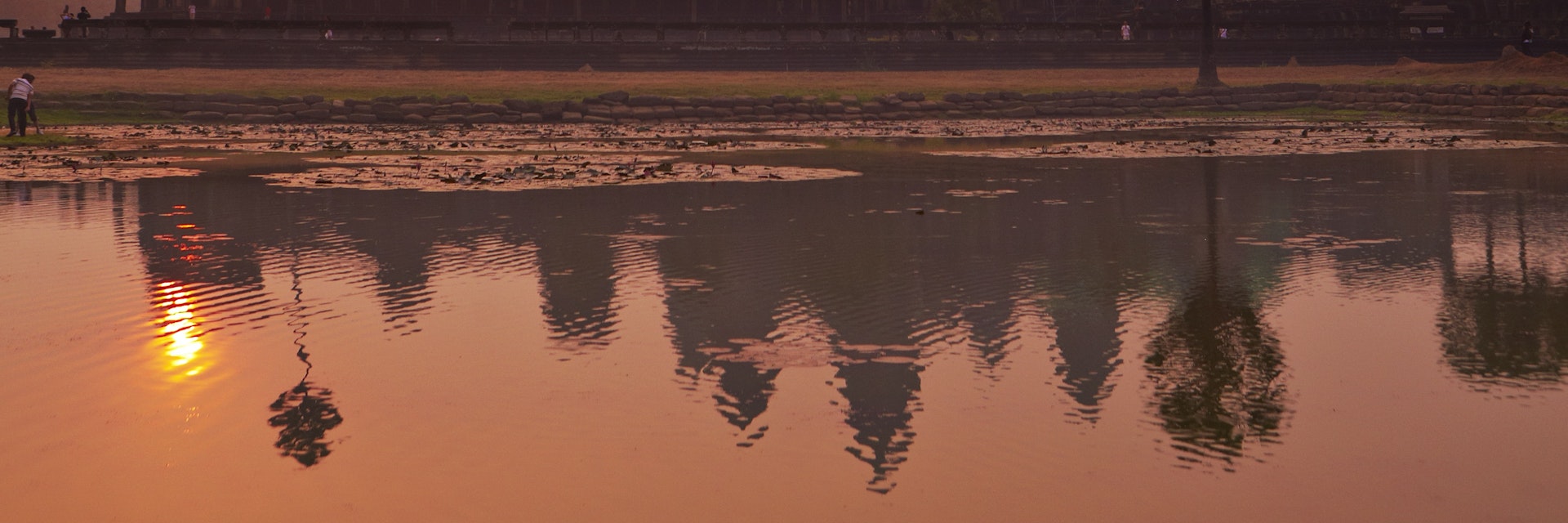
The traveller's first glimpse of Angkor Wat, the ultimate expression of Khmer genius, is matched by only a few select spots on earth. Built by Suryavarman II (r 1112–52) and surrounded by a vast moat, the temple is one of the most inspired monuments ever conceived by the human mind.
Attractions
Must-see attractions.

Churning of the Ocean of Milk
The southern section of the east gallery is decorated by the most famous of the bas-relief scenes at Angkor Wat, the Churning of the Ocean of Milk. This…

Army of Suryavarman II
The remarkable western section of the south gallery depicts a triumphal battle march of Suryavarman II’s army. In the southwestern corner about 2m from…

Battle of Kurukshetra
The southern portion of the west gallery depicts a battle scene from the Hindu Mahabharata epic, in which the Kauravas (coming from the north) and the…

Heaven & Hell
The punishments and rewards of the 37 heavens and 32 hells are depicted in the eastern half of the south gallery. On the left, the upper and middle tiers…

Battle of Lanka
The northern half of the west gallery shows scenes from the Ramayana. In the Battle of Lanka, Rama (on the shoulders of Hanuman), along with his army of…

Battle of the Gods & the Demons
The western section of the north gallery depicts the battle between the 21 gods of the Brahmanic pantheon and various demons. The gods are featured with…

Krishna & the Demon King
The eastern section of the north gallery shows Vishnu incarnated as Krishna riding a garuda. He confronts a burning walled city, the residence of Bana,…

Vishnu Conquers the Demons
The northern section of the east gallery shows a furious and desperate encounter between Vishnu, riding on a garuda, and innumerable devils. Needless to…
Latest stories from Angkor Wat
Filter by interest:
- All Interests
- Adventure Travel
- Art & Culture
- Beaches, Coasts & Islands
- Food & Drink
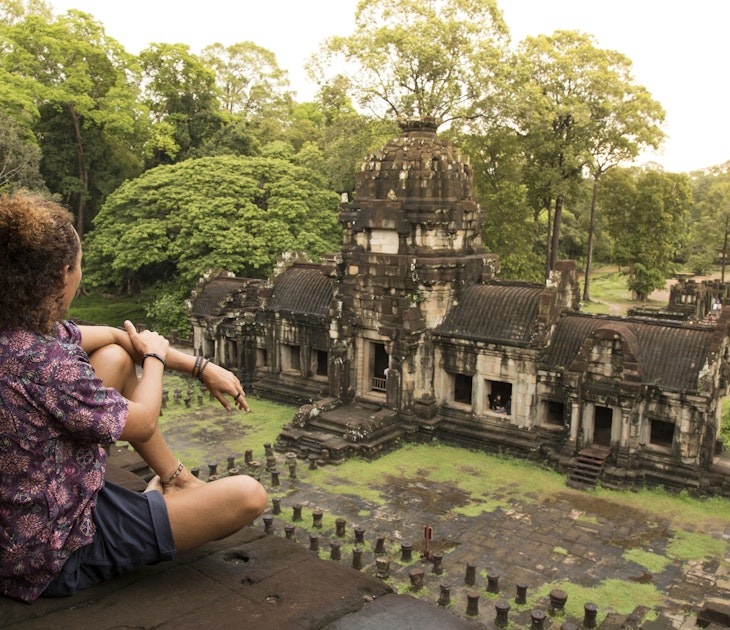
Archaeology
Mar 10, 2022 • 8 min read
A visit to Cambodia’s Angkor Wat is understandably high on the list for many travelers. Use this guide to help plan and make the most of your trip.
Apr 22, 2020 • 4 min read
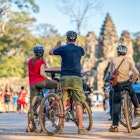
Dec 15, 2019 • 1 min read

Nov 19, 2019 • 2 min read

Nov 13, 2019 • 5 min read
Purchase our award-winning guidebooks
Get to the heart of Angkor Wat with one of our in-depth, award-winning guidebooks, covering maps, itineraries, and expert guidance.
Take advantage of the search to browse through the World Heritage Centre information.
Outstanding Universal Value
Brief synthesis
Angkor, in Cambodia’s northern province of Siem Reap, is one of the most important archaeological sites of Southeast Asia. It extends over approximately 400 square kilometres and consists of scores of temples, hydraulic structures (basins, dykes, reservoirs, canals) as well as communication routes. For several centuries Angkor, was the centre of the Khmer Kingdom. With impressive monuments, several different ancient urban plans and large water reservoirs, the site is a unique concentration of features testifying to an exceptional civilization. Temples such as Angkor Wat, the Bayon, Preah Khan and Ta Prohm, exemplars of Khmer architecture, are closely linked to their geographical context as well as being imbued with symbolic significance. The architecture and layout of the successive capitals bear witness to a high level of social order and ranking within the Khmer Empire. Angkor is therefore a major site exemplifying cultural, religious and symbolic values, as well as containing high architectural, archaeological and artistic significance.
The park is inhabited, and many villages, some of whom the ancestors are dating back to the Angkor period are scattered throughout the park. The population practices agriculture and more specifically rice cultivation.
Criterion (i): The Angkor complex represents the entire range of Khmer art from the 9th to the 14th centuries, and includes a number of indisputable artistic masterpieces (e.g. Angkor Wat, the Bayon, Banteay Srei).
Criterion (ii): The influence of Khmer art as developed at Angkor was a profound one over much of South-east Asia and played a fundamental role in its distinctive evolution.
Criterion (iii): The Khmer Empire of the 9th-14th centuries encompassed much of South-east Asia and played a formative role in the political and cultural development of the region. All that remains of that civilization is its rich heritage of cult structures in brick and stone.
Criterion (iv): Khmer architecture evolved largely from that of the Indian sub-continent, from which it soon became clearly distinct as it developed its own special characteristics, some independently evolved and others acquired from neighboring cultural traditions. The result was a new artistic horizon in oriental art and architecture.
The Angkor complex encompasses all major architectural buildings and hydrological engineering systems from the Khmer period and most of these “barays” and canals still exist today. All the individual aspects illustrate the intactness of the site very much reflecting the splendor of the cities that once were. The site integrity however, is put under dual pressures:
- endogenous: exerted by more than 100,000 inhabitants distributed over 112 historic settlements scattered over the site, who constantly try to expand their dwelling areas;
- exogenous: related to the proximity of the town of Siem Reap, the seat of the province and a tourism hub.
Authenticity
Previous conservation and restoration works at Angkor between 1907 and 1992, especially by the École Française d’Extrême-Orient (EFEO), the Archaeological Survey of India, the Polish conservation body PKZ, and the World Monuments Fund have had no significant impact on the overall authenticity of the monuments that make up the Angkor complex and do not obtrude upon the overall impression gained from individual monuments.
Protection and management requirements
The property is legally protected by the Royal Decree on the Zoning of the Region of Siem Reap/Angkor adopted on 28 May 1994 and the Law on the protection of the natural and cultural heritage promulgated on 25 January 1996, the Royal Decree on the creation of the APSARA National Authority (Authority for the protection of the site and the management of the Angkor Region) adopted on 19 February 1995, the No. 70 SSR government Decision, dated 16 September 2004 providing for land‐use in the Angkor Park: “All lands located in zone 1 and 2 of the Angkor site are State properties”, and the sub-decree No. 50 ANK/BK on the organisation and functioning of the APSARA National Authority adopted on 9 May 2008, specifically provided for the establishment of a Department of Land‐use and Habitat Management in the Angkor Park.
In order to strengthen and to clarify the ownership and building codes in the protected zones 1 and 2, boundary posts have been put in 2004 and 2009 and the action was completed in 2012.
As off 1993, the ICC-Angkor (International Coordinating Committee for the Safeguarding and Development of the historic site of Angkor) created on 13 October 1993, ensures the coordination of the successive scientific, restoration and conservation related projects, executed by the Royal Cambodian Government and its international partners. It ensures the consistency of the various projects, and defines, when necessary, technical and financial standards and calls the attention of all the concerned parties when required. It also contributes to the overall management of the property and its sustainable development.
The successful conservation of the property by the APSARA National Authority, monitored by the ICC-Angkor, was crowned by the removal of the property from the World Heritage List in danger in 2004.
Angkor is one of the largest archaeological sites in operation in the world. Tourism represents an enormous economic potential but it can also generate irreparable destructions of the tangible as well as intangible cultural heritage. Many research projects have been undertaken, since the international safeguarding program was first launched in 1993.The scientific objectives of the research (e.g. anthropological studies on socio-economic conditions) result in a better knowledge and understanding of the history of the site, and its inhabitants that constitute a rich exceptional legacy of the intangible heritage. The purpose is to associate the “intangible culture” to the enhancement of the monuments in order to sensitize the local population to the importance and necessity of its protection and preservation and assist in the development of the site as Angkor is a living heritage site where Khmer people in general, but especially the local population, are known to be particularly conservative with respect to ancestral traditions and where they adhere to a great number of archaic cultural practices that have disappeared elsewhere. The inhabitants venerate the temple deities and organize ceremonies and rituals in their honor, involving prayers, traditional music and dance. Moreover, the Angkor Archaeological Park is very rich in medicinal plants, used by the local population for treatment of diseases. The plants are prepared and then brought to different temple sites for blessing by the gods. The Preah Khan temple is considered to have been a university of medicine and the NeakPoan an ancient hospital. These aspects of intangible heritage are further enriched by the traditional textile and basket weaving practices and palm sugar production, which all result in products that are being sold on local markets and to the tourists, thus contributing to the sustainable development and livelihood of the population living in and around the World Heritage site.
A Public Investigation Unit was created as « measure instrument » for identifying the needs, expectations and behaviors of visitors in order to set policies, monitor its evolution, prepare a flux management policy and promote the unknown sites.
The management of the Angkor Site, which is inhabited, also takes into consideration the population living in the property by associating them to the tourist economic growth in order to strive for sustainable development and poverty reduction.
Two major contributions supporting the APSARA National Authority in this matter are:
- The Angkor Management Plan (AMP) and Community Development Participation Project (CDPP), a bilateral cooperation with the Government of New Zealand. The AMP helps the APSARA National Authority to reorganize and strengthen the institutional aspects, and the CDPP prepares the land use map with an experimental participation of the communities and supports small projects related to tourist development in order to improve the income of villagers living in the protected zones;
- The Heritage Management Framework composed of a Tourism Management Plan and a Risk map on monuments and natural resources; a multilateral cooperation with the Government of Australia and UNESCO. Preliminary analytical and planning work for the management strategy will take into account the necessity to preserve the special atmosphere of Angkor. All decisions must guarantee physical, spiritual, and emotional accessibility to the site for the visitors.
- Authority for the Protection and Management of Angkor and the Region of Siem Reap APSARA

List of World Heritage in Danger
Inscription Year on the List of World Heritage in Danger
State of Conservation (SOC)
Protections by other conservation instruments.
1 protection / 1 element
- Royal ballet of Cambodia
Read more about synergies
Nomadic Matt's Travel Site
Travel Better, Cheaper, Longer
Angkor Wat Travel Guide
Last Updated: August 30, 2023
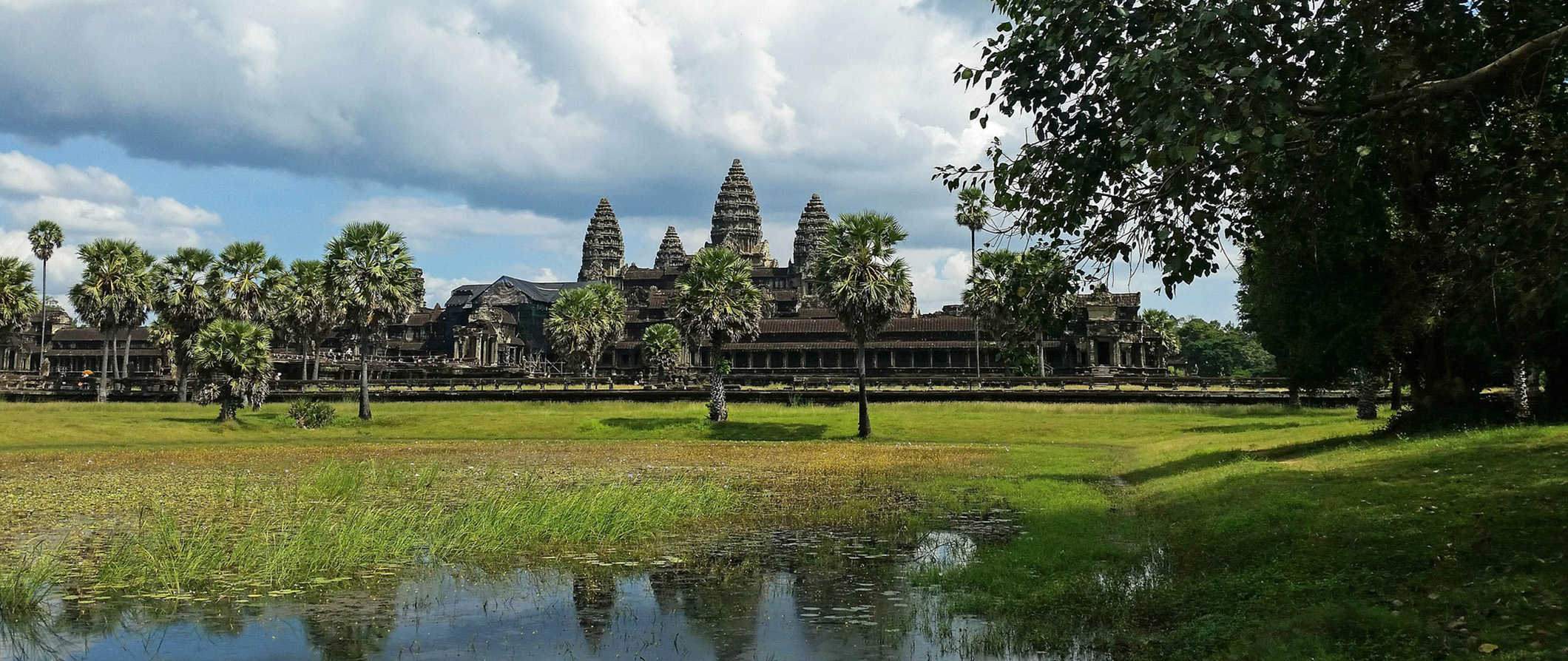
Angkor Wat is an ancient city in Cambodia that was the center of the Khmer Empire that once ruled much of Southeast Asia. This civilization went extinct, but not before building amazing temples and buildings that were reclaimed by the jungle for hundreds of years.
Angkor Wat was built in the 12th century, the surrounding complex spanning over 400 acres. It was the state temple for the empire, an empire larger than the Byzantine Empire, stretching from Thailand to Vietnam and all the way into Southern China. The temples were “rediscovered” in the 1840s and have been a popular tourist attraction ever since.
Today, the temple complex is a UNESCO World Heritage Site and though it’s always packed with tourists, the area and ruins are still breathtaking to see.
The most popular temples are Angkor Wat, Bayon, Ta Phrom, and Angkor Thom. But there are over 70 temples here so I recommend getting a multi-day pass so you can visit some of the outer temples where there are fewer visitors. There’s a lot to see!
The closest major city and launching pad for tours here is Siem Reap and the temple complex an easy day trip from the city either by bike or by tuk-tuk.
This travel guide to Angkor Wat will help you plan your visit, save money, and ensure you have the best time possible one of the greatest wonders in the world.
Table of Contents
- Things to See and Do
- Typical Costs
- Suggested Budget
- Money-Saving Tips
- Where to Stay
- How to Get Around
- How to Stay Safe
- Best Places to Book Your Trip
- Related Blogs on Angkor Wat
Top 5 Things to See and Do in Angkor Wat

1. Explore Angkor Wat
This temple was built by Suryavarman II, who ruled from 1113-1150. It’s considered the biggest Asian pyramid, standing over 61 meters (200 feet) high and divided into several layers. This temple is the largest in the whole complex and is where the historic site gets its name. The central temple complex has 792 meters (2,600 feet) of bas-reliefs.
2. See The Bayon
Built by Jayavarman VII, the temple stands in the center of Angkor Thom. With its 54 towers and 216 faces of Avalokiteshvara (a manifestation of Buddha), this temple looks best in the morning just after sunrise or at the end of the afternoon. The temple was built in three levels: the first two are rectangular, while the third is circular.
3. Step back in time at Ta Prohm
Still covered by the jungle, this place is exactly as they found it when it was rediscovered. Ta Prohm makes it easy to imagine how the whole complex looked when it was re-discovered in the 19th-century. If you come early, you can avoid the crowds that arrive mid-day. It’s the second-best complex behind Bayon in my opinion.
4. Visit Banteay Srei
This temple is located 19 kilometers (12 miles) north of Angkor. The name means “Citadel of the Women” and refers to the size and delicacy of the decoration. Unlike the major sites at Angkor, this was not a royal temple. The temple boasts exquisite decorative carvings in pink sandstone with miniature proportions.
5. Admire Ta Som
This temple has the same style, structure, and founder as Ta Phrom. It is almost like its little brother. The major feature that sets it apart is a huge tree that grows atop the eastern Gopura. It is slowly destroying the building, but it makes for amazing photo opportunities.
Other Things to See and Do in Angkor Wat
1. stroll the terrace of the elephants.
This 350-meter (1,150-foot) long terrace of elephants was used as a giant viewing stand during public ceremonies, royal ceremonies, and other events (such as viewing the returning army when they returned from war). Numerous life-size lions decorate this enormous path as well. Today, it’s surrounded by camera-wielding tourists and I found it to be one of the busiest sites here. I suggest visiting late or early to avoid the crowds, which can be overwhelming.
2. See East Mebon
Built in the 10th-century by King Rajendravarman, a huge baray (reservoir) surrounded this temple complex during its prime. Because it was encircled by water, there was no need for enclosures or moats that became customary for temples in Angkor. East Mebon has five towers — make sure to climb the central platform to the towers and check out the intricate stonework.
3. Explore Preah Khan
Preah Khan is one of the largest sites in the Angkor temple complex. Not only was this site an important temple, but it also appears to have been a large Buddhist university with over 1,000 teachers and upwards of 100,000 servants and attendants. It remains largely unrestored, as evidenced by the many trees growing around the ruins and mossy stones left laying everywhere. The site was a previous palace of Yasovarman II and Tribhuvanadityavarman, and historians believe a famous battle was fought here. There are shrines to over 430 deities here as well.
4. Climb Pre Rup
About 600 meters (2,000 feet) south of the East Baray lies Pre Rup. It was built by Rajendravarman II, who reigned from 944-968, and was his capital after re-establishing Angkor once he took over as king. Pre Rup was at the center of a city that has long since vanished. Many believe this was the place where funerals were held and was dedicated to the god Shiva. You can climb the steep steps up to the three tiers of the pyramid.
5. Go to Preah Ko
King Indravarman I built this temple, called Sacred Bull, in 879 CE, making it the first temple to be built in the ancient (and now defunct) city of Hariharalaya. The temple lies about 16 kilometers (10 miles) southeast of the main temples at Angkor and was dedicated to the king’s family as well as the god Shiva. Today, there are six small brick towers that sit atop a sandstone base. The temple derives its name from the three sandstone statues representing Nandi, the white bull of the Hindu deity Shiva.
6. Catch the sunrise at Srah Srang
Commonly known as “The Royal Baths,” this spot was once a major bathing spot for the area. The reservoir was first created in the mid-10th century by a Buddhist minister of King Rajendravarman II. It was expanded in 1200 by Jayavarman VII. It’s especially picturesque in the mornings as the sun rises over the tranquil water. Excavations have found a cemetery and necropolis nearby as well.
7. See Baksei Chamkrong
On the road between Angkor Wat and Angkor Thom is a single tower that was built by Harshavarman I (he reigned from 910-923). It’s one of the few ruins accredited to him. He had it built to honor his father who was responsible for the construction of Phnom Bakheng. The temple’s name means “The Bird Who Shelters Under Its Wings.” It’s one of the first temples in the complex built with more durable materials (bricks and laterite), with sandstone decorative elements.
8. Find the secret passage at the Terrace of the Leper King
This seven-layer terrace, built in the 13th century, is dedicated to the god of death, Yama. It earned its name as the moss growing on the statues left them discolored and looking as if they had leprosy. Keep an eye out for the secret passageway that runs from the southwest to the northwest side of the structure.
9. See the sunset at Phnom Bakheng
Built in the late 9th century (two centuries before Angkor Wat itself), this is the oldest temple here. It is both a Hindu and Buddhist temple and bears statues and symbolic elements from both religions. It was built as a representation of Mount Meru, home of the Hindu gods. Located on a hill, it’s a popular place to watch the sunset (so popular in fact, that visitor numbers are now limited during this time).
10. Stroll through Banteay Kdei
Located opposite the Srah Srang reservoir, Banteay Kdei was built in 1181 by Jayavarman VII. Its name means “Citadel of Chambers” as this used to be where Buddhist monks lived (monks lived here all the way up until the 1960s). There are three cloisters in the complex and the walls are carved with Buddhas, though unfortunately many have been defaced or have degraded over time. This complex is currently undergoing renovations, though you can still visit. This temple sees fewer crowds so it’s a good place to go to experience some tranquility.
For more information on other destinations in Cambodia, check out these guides:
- Phnom Penh Travel Guide
- Siem Reap Travel Guide
- Sihanoukville Travel Guide
Angkor Wat Travel Costs
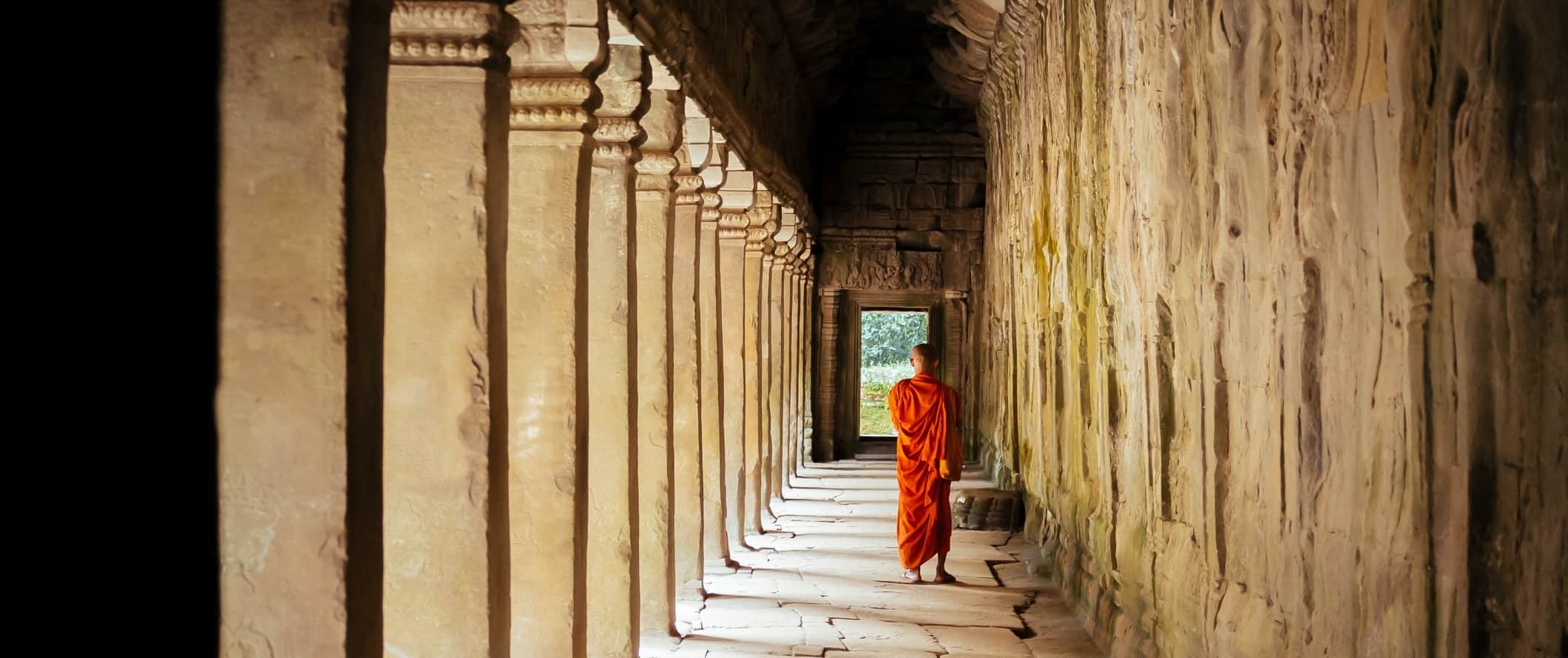
Note: Cambodia uses USD. There’s no real need to carry the local currency, Cambodian Riels (KHR), unless you’re paying for really small things on the street. In many places, especially in the countryside, you might start getting riels back when paying in USD but you can essentially get by using mostly USD here.
Siem Reap is the nearest city to Angkor Wat. That’s where you’ll be staying during your visit.
Hostel prices – A bed in a dorm with 4-6 beds costs $6-10 USD per night. Larger dorms with 10-12 beds can be found for as little as $3-4 USD per night. For a private room with an ensuite bathroom, expect to pay closer to $15-25 USD per night.
Free Wi-Fi is standard and most hostels have a swimming pool (some have multiple). None of the hostels include free breakfast or self-catering facilities, but many have a café/restaurant on-site with food available.
Budget hotel prices – A room in a guesthouse with air-conditioning, hot water, a private bathroom, and TV costs around $13-15 USD per night. For a hotel/guesthouse with a pool and a restaurant, expect to pay closer to $20 USD.
Airbnb is also available in Siem Reap. Expect to pay at least $25 USD per night for an entire home/apartment.
Average cost of food – Cambodian food is similar to Thai and Vietnamese cuisine. Vietnam and Cambodia especially have many dishes in common due to the countries’ shared history of French colonization. For example, the baguette sandwich known as bánh mì in Vietnam is called num pang pâté in Cambodia. Other popular Cambodian dishes include num banhchok , a lightly fermented rice noodle dish served for breakfast; amok trei , a fish curry dish; and samlar kako , a hearty soup filled with vegetables, roasted ground rice, and catfish or pork. In general, Cambodian cuisine includes a huge variety of noodle soups, stir-fries, curries, fried rice, and sweets.
Rice and freshwater fish are present in nearly every Cambodian meal. Lemongrass, galangal, turmeric, tamarind, ginger, chili pepper, and kaffir lime are all commonly used spices. Fermented fish paste is another widely used ingredient that adds saltiness and flavor.
Common vegetables include leaf and root vegetables as well as melon, long beans, snow peas, bean sprouts, and eggplant. Dozens of types of fruit are native to Cambodia, with durian being the most infamous. However, there are plenty of less pungent fruits to try, including mangosteen, passionfruit, dragonfruit, and mangoes. Fruit is a popular dessert and snack, either eaten alone or made into a variety of sweets.
There are tons of food options within the temple complex (though prices are higher than in the city). You can easily find restaurant meals in the $5-7 USD price range.
Around the temples are little stands with cheap meals for about $2-3 USD. There are also lots of vendors selling fresh fruit and juices for as little as $1.50 USD. They are a great choice to stay hydrated and cool down as you explore.
Angkor Wat Suggested Budgets
On a backpacking budget, you can expect to pay $60 USD per day to visit Angkor Wat. On this budget, you’re staying in a hostel dorm, eating cheap street food, limiting your drinking, and using a bike to get around the complex. This also includes a day entry to the Angkor Wat site.
On a mid-range budget of $97 USD per day, you can eat at restaurants in the complex, stay in a private room at a hostel or budget hotel, enjoy a few drinks, and hire a shared tuk-tuk driver to take you around Angkor Wat.
On a luxury budget of $247 USD per day, you can stay in a hotel or at a resort with a pool, eat out for every meal anywhere you want, drink more, and opt for a private guided tour of the site over multiple days.
You can use the chart below to get an idea of how much you need to budget daily, depending on your travel style. Keep in mind these are daily averages – some days you’ll spend more, some days you’ll spend less (you might spend less every day). We just want to give you a general idea of how to make your budget. Prices are in USD.
Angkor Wat Travel Guide: Money-Saving Tips
There aren’t a ton of ways to save money here since it’s a huge tourist attraction that draws millions of people each year. Nevertheless, here are a few of my top money-saving tips for Angkor Wat:
- Get a multi-day pass – Everyone needs a permit to enter the Angkor temples unless you are Cambodian or related to a Cambodian. A 1-day pass is $37 USD, a 3-day pass is $62 USD, and a 7-day pass is $72 USD. There’s so much to see that it’s worth getting a multi-day pass so you don’t have to rush your time.
- Rent a tuk-tuk – It’s best to rent a tuk-tuk for an entire day to get around. They know how to get you in and out of each temple as well as the best routes for the complex. You’ll be able to see more places in a day and it’s very affordable, generally around $25 USD for the day. If you split this between a group of 3-4 it becomes quite affordable. Getting a driver in Siem Reap is cheaper than inside the park. (Most hostels can help you with this).
- See the sunset the night before – If you buy your ticket after 5pm you can legally enter the park without using up your allotted days. This means you can technically enter the park and explore before it closes, and still have your 1, 3, or 7 days remaining. The best way to spend this extra time is to watch the sunset, saving the temples for the following day(s).
- Bring a water bottle – The tap water in Siem Reap isn’t safe to drink so bring a reusable water bottle with a filter to save money and reduce your plastic use. LifeStraw is my go-to brand for bottles with built-in filters to ensure your water is always clean and safe.
Where to Stay in Angkor Wat
Travelers stay in Siem Reap when they’re visiting Angkor Wat. My suggested budget-friendly places to stay are:
- The Siem Reap Pub Hostel
- Onederz Hostel Siem Reap
- Mad Monkey Siem Reap
How to Get Around Angkor Wat
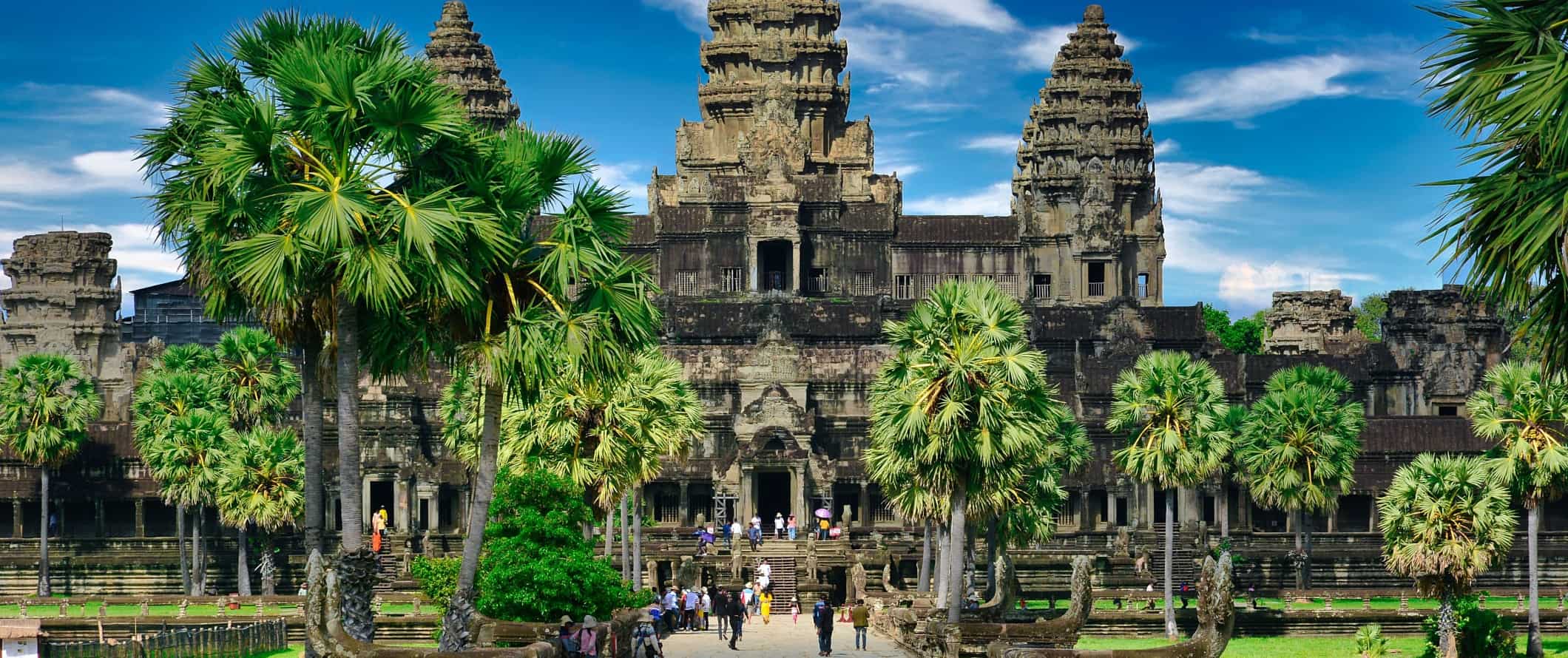
There are two ways for you to get to and from Angkor Wat (and around the complex):
Bicycle Rental – Bicycles are a great way to explore the complex, and you can find rentals for about $5 USD per day. If you choose this method, be prepared for long hours cycling in the heat.
When to Go to Angkor Wat
Angkor Wat is open year-round but no matter when you visit Angkor Wat, it’s a toss-up: either you’ll have a rainy, muddy visit with fewer people around, or great weather and crazy tourist hordes. But if you’re concerned mainly with the weather, the best time to visit is during the dry season (from late November to early April).
December and January are best for weather, but they’re also busiest months. April and May can be unbearably hot, with tons of humidity. The average daily temperature in April is 31°C (88°F).
The monsoon season lasts from late May/June to the end of October, with September and October being the hottest months. If you can time your visit to one of the shoulder months, do so.
Having a multi-day pass will give you the opportunity to plan around the weather — another reason why going for multiple days is worth it!
How to Stay Safe in Angkor Wat
Angkor Wat is an incredibly safe place to backpack and travel, even if you’re a solo traveler, and even as a solo female traveler. Petty theft (including bag snatching) is the most common type of crime here so always keep an eye on your valuables (especially bags, purses, and phones).
You may encounter persistent children trying to sell you stuff and they may even become more aggressive if you don’t shop with them. There are also many people offering to take you on a personal tour or show you the best photo spots, but these are not licensed guides. Just walk away from them saying “no thank you,” and eventually they will give up.
These are the most common scams and situations you might encounter, but if you’re concerned about others, read about these common travel travel scams to avoid here .
Avoid dehydration in the heat by making sure you bring lots of water to keep hydrated. Remember that tap water isn’t safe to drink, so bring a water bottle with a built-in filter. Wear a hat as well to keep the sun off of you. You’ll be here for hours and it can be very easy to overheat or get a sunburn.
If you experience an emergency, dial 119 for assistance.
Always trust your gut instinct. Make copies of your personal documents, including your passport and ID. Forward your itinerary along to loved ones so they’ll know where you are.
The most important piece of advice I can offer is to purchase good travel insurance. Travel insurance will protect you against illness, injury, theft, and cancellations. It’s comprehensive protection in case anything goes wrong. I never go on a trip without it as I’ve had to use it many times in the past. You can use the widget below to find the policy right for you:
Angkor Wat Travel Guide: The Best Booking Resources
These are my favorite companies to use when I travel. They consistently have the best deals, offer world-class customer service and great value, and overall, are better than their competitors. They are the companies I use the most and are always the starting point in my search for travel deals.
- Skyscanner – Skyscanner is my favorite flight search engine. They search small websites and budget airlines that larger search sites tend to miss. They are hands down the number one place to start.
- Hostelworld – This is the best hostel accommodation site out there with the largest inventory, best search interface, and widest availability.
- Agoda – Other than Hostelworld, Agoda is the best hotel accommodation site for Asia.
- Booking.com – The best all around booking site that constantly provides the cheapest and lowest rates. They have the widest selection of budget accommodation. In all my tests, they’ve always had the cheapest rates out of all the booking websites.
- Get Your Guide – Get Your Guide is a huge online marketplace for tours and excursions. They have tons of tour options available in cities all around the world, including everything from cooking classes, walking tours, street art lessons, and more!
- SafetyWing – Safety Wing offers convenient and affordable plans tailored to digital nomads and long-term travelers. They have cheap monthly plans, great customer service, and an easy-to-use claims process that makes it perfect for those on the road.
- LifeStraw – My go-to company for reusable water bottles with built-in filters so you can ensure your drinking water is always clean and safe.
- Unbound Merino – They make lightweight, durable, easy-to-clean travel clothing.
Angkor Wat Travel Guide: Related Articles
Want more tips for your trip? Check out all the articles I’ve written on Cambodia travel and continue planning your trip:

Is Southeast Asia Safe for Travelers?
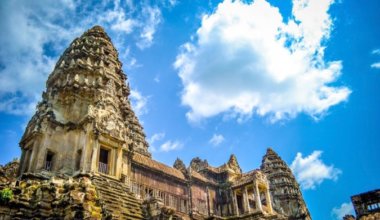
Backpacking Cambodia: 3 Suggested Itineraries for Your Trip
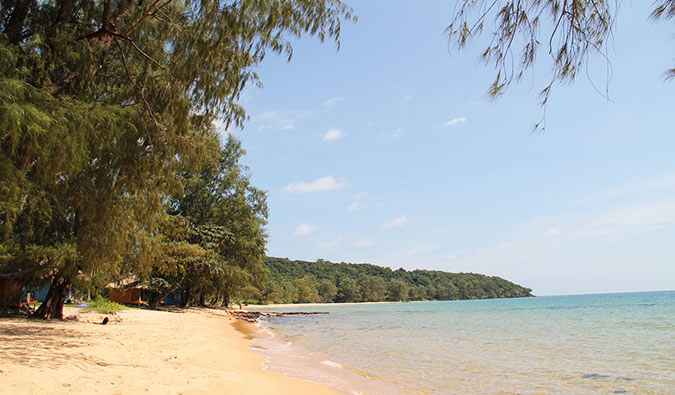
Experiencing Local Cambodian Culture on Bamboo Island
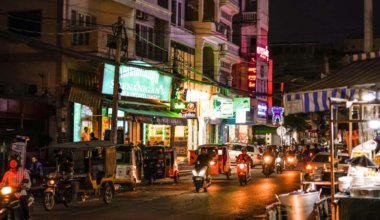
Phnom Penh, I Love You!
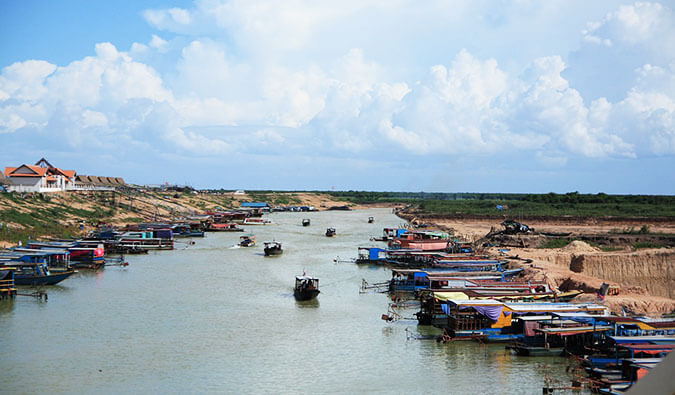
The Tragic Death of Phnom Penh’s Lake Area
Get my best stuff sent straight to you, pin it on pinterest.
- Where To Stay
- Transportation
- Booking Resources
- Related Blogs

Plan Your Trip
- 01 Fill in details ranging from your desired experience to the amount of people you are traveling with.
- 02 Based on your answers, discover destinations and experiences tailored to you.
- 03 Explore each suggestion
Follow the step by step with what you would like to experience for your next trip through the following 4 questions.

Quick Links
- Intra-ASEAN Tourism Toolkit Download
- Tourism Packages
- Guidelines on Self-Drive
- Facts & Planning
- Visa & Immigration
- Suggested Itineraries
- Download Video
- Download Logo
- A Destination For Every Dream
Stay updated on Covid-19 in Southeast Asia. For more information, click here .
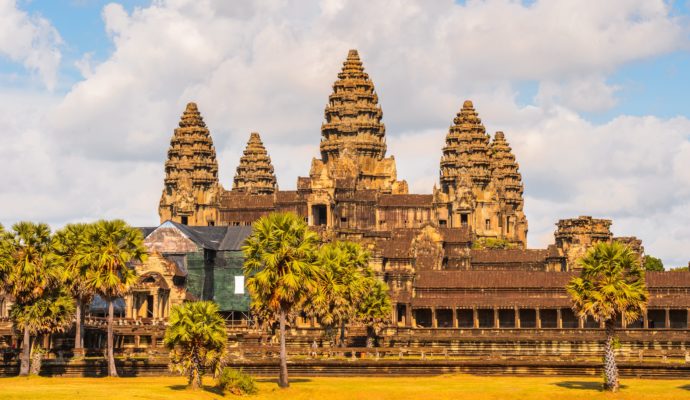
Top Sights Cambodia Angkor Wat Temple
Angkor Wat Temple
Siem Reap, Cambodia
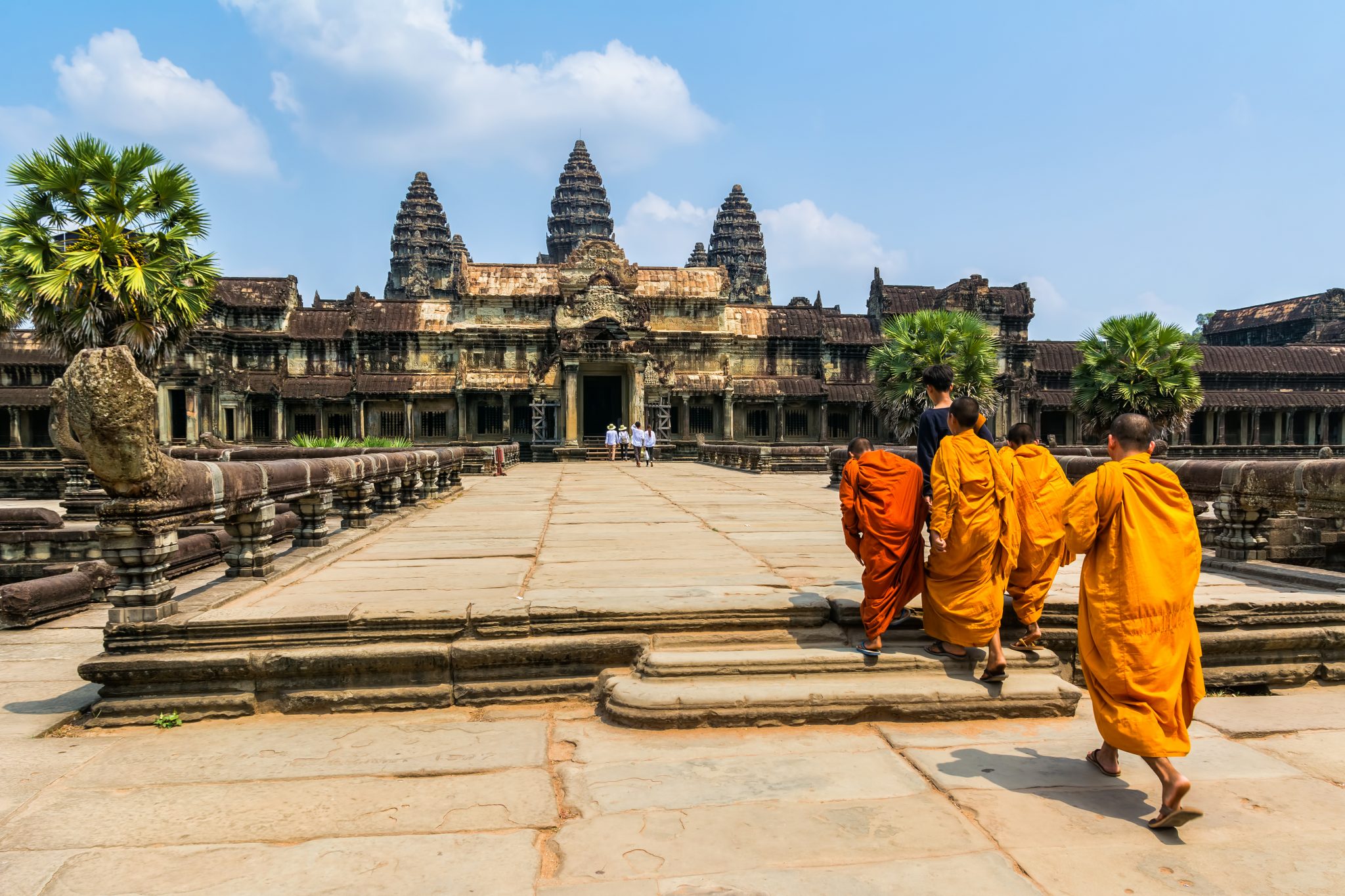
It’s the biggest faith-based structure in the world—appropriately scaled for something meant to symbolize the Universe.
Occupying a 208-hectare rectangle, surrounded by a 200-meter-wide moat and centered around five towers whose central spire rises some 55 meters above the ground, the massive temple complex of Angkor Wat inspires awe in anyone who sees it.
It’s not just its size, it’s the intricate detail: galleries upon galleries of carved scenes from Hindu mythology and depictions of the King and his entourage; over 3,000 dancing apsaras, or female deities; and statuary of the Hindu god Vishnu, to whom the temple is dedicated. The five towers are supposed to symbolize Mount Meru, the sacred mountain in the middle of the cosmos.
Angkor Wat was listed as a UNESCO World Heritage Site in 1992. The entire park is open year-round; most tourists visit arrive as soon as the temple opens at 5am to catch the sun rising over the towers and the reflecting pool.
Related Top Sights
Sopheakmit waterfall, lake yeak laom, related activities, nine vegetarians worth saving in southeast asia, trekking daze: asean’s multi-day treks.

Angkor Wat: Guide to the Grand Circuit Tour
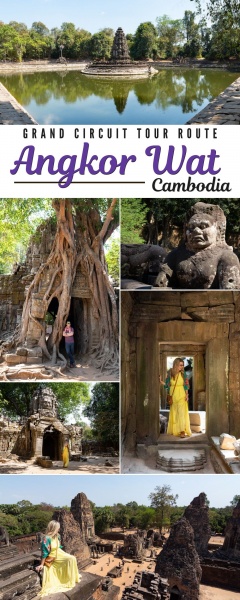
The Angkor Archaeological Park is massive – 400 square kilometers to be exact. And figuring out what temples to visit, how to get there, and how to avoid the crowds and the heat can be a daunting task. We purchased the 7-day pass so that we could explore all of it in order to bring you a complete guide to the Grand Circuit Tour, as well as a few other things you should know before you visit.
After you finish reading this post, be sure to check out our Complete Guide to Angkor Wat and our post about the Small Circuit Tour. And, of course, you’ll want to read all about the best places to eat, sleep, and drink in the nearby town of Siem Reap!
Disclaimer: This post may contain affiliate links. If you make a purchase or booking through one of our links we may earn a small commission (don’t worry, it’s at no extra cost to you).
Angkor Wat: Grand Circuit Tour
Entrance prices and hours, angkor archaeological park entrance fees.
- 1-day ticket – $37 USD
- 3-day ticket (valid for 1 week) – $62 USD
- 7-day ticket (valid for 1 month) – $72 USD
Angkor Archaeological Park Hours
- Angkor Wat Temple and Srah Srang: 5 am – 5:30 pm (open for sunrise)
- Phnom Bakheng and Pre Rup Temples: 5 am – 7 pm (open for sunrise and sunset)
- All other temples: 7:30 am – 5:30 pm
Ticket Office
The ticket office is technically open from 5 am – 5:30 pm daily. However, ticket agents usually begin selling tickets at 4:30 am so you can arrive even earlier if you want to get a prime sunrise-viewing spot. Or better yet, purchase your ticket between 5 pm and 5:30 pm the evening before so you don’t have to worry about waiting in line!
Choosing a Tuk-Tuk Driver
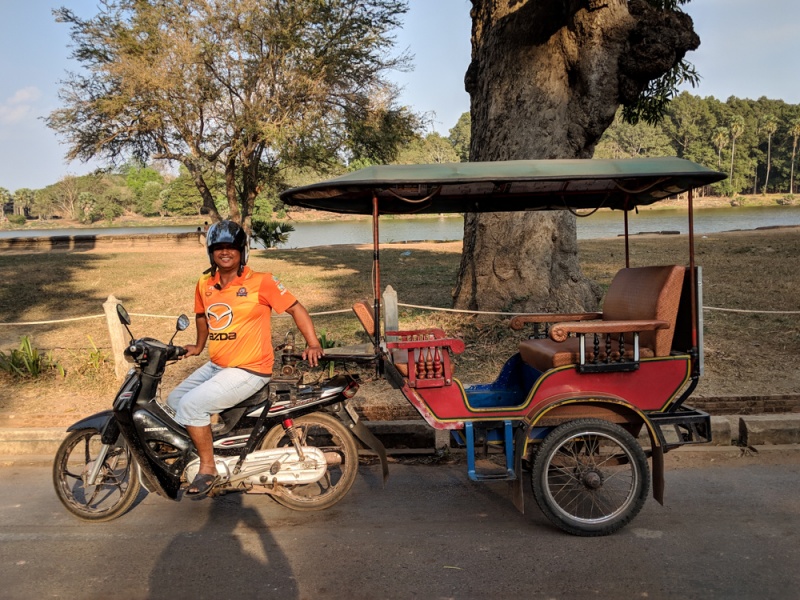
There are tuk-tuk drivers all over Siem Reap, vying for the chance to be your tour guide of Angkor Wat. They are especially congregated around the entrances of Pub Street, the popular backpacker area.
If you want to take a run-of-the-mill-tour, you can simply choose any driver that seems nice, no matter their level of English. They will point to their handy laminated map to show you the two options and quote you a price.
If you want to deviate from the normal route or watch sunrise somewhere other than Angkor Wat, you’ll need to find a driver that speaks decent English. Which may cost up to $30 USD for a trip. You can always rent a motorbike or bicycle and explore on your own.
The Best Tuk-tuk Driver in Siem Reap
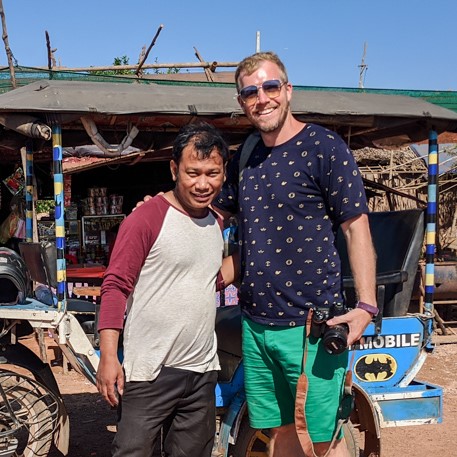
After several trips to Siem Reap we have worked with quite a few local drivers and our favorite Siem Reap tuk-tuk driver is Nakry Mean who drives a batmobile-themed tuk-tuk. You can reach him on WhatsApp at +855 17 761 110 or on his Facebook page, Siem Reap Batmobile Tuk Tuk .
Book a Tour of Angkor Wat
If you’d prefer to prearrange a tour of the temples, check out Get Your Guide. They offer a full-day Grand Circuit photo tour that starts with sunrise. You’ll have a knowledgeable English-speaking guide and learn all about the history of the park and the temples that you visit.
Book a Grand Circuit Full-Day Photo Tour
Grand Circuit Tour Route
The Grand Circuit Tour route (also called “Big Circuit”) is generally done clockwise and includes the temples that are outside of the Small Circuit Tour . These are on the outskirts of the complex so it’s a bit more expensive as your tuk-tuk driver will use more petrol. Read more about those temples in our post about the Small Circuit Tour .
We chose to modify our Grand Circuit tour. We started with sunrise at Srah Srang, a small temple that sits on the banks of a big man-made lake. Then we added Ta Prohm to our list of temples that we would be visiting. And we did the tour in counterclockwise order.
The temples below are listed in order of how you would visit them if you started with sunrise at Angkor Wat and toured in clockwise order.
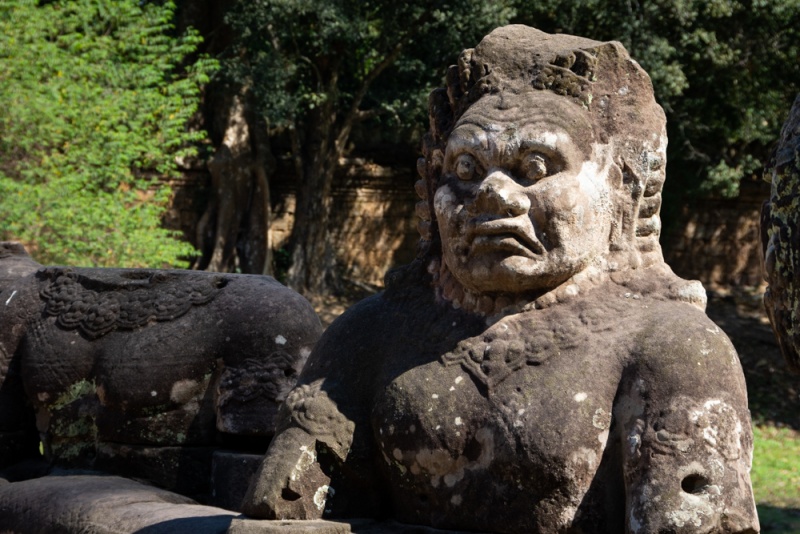
Preah Khan is definitely one of the highlights of the Grand Circuit Tour. The walkway leading up to Preah Khan temple is lined by statues that appear to play tug-of-war with a snake; they are actually depicting the churning of the ocean of milk. It is a grand entrance to a very grand temple.
As you walk through the central hallway through Preah Khan, it seems to go on and on forever. But soon enough it opens up and you’ll find little pockets of areas to explore here. The carvings are still in very good condition and much of the temple is just a free-for-all to explore. These carvings of women goddesses in dancing poses are known as Apsara.
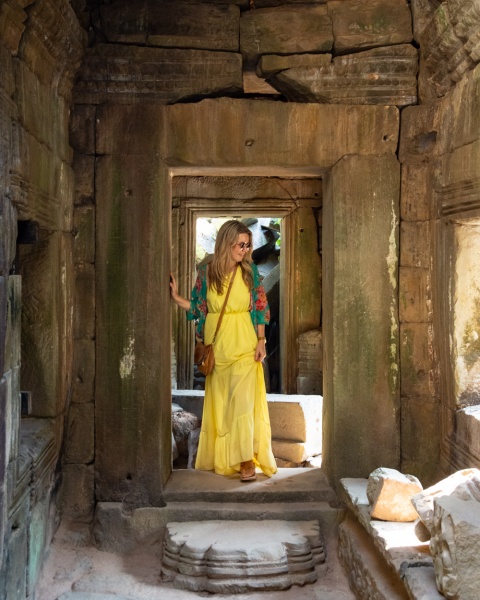
It was one of my favorite temples in the complex because there seemed to be a surprise around every corner. It’s a good one to check out in the morning before you are sweaty and exhausted and can only think about air conditioning and a cold beer.
Opening Hours: 7:30am – 5:30pm
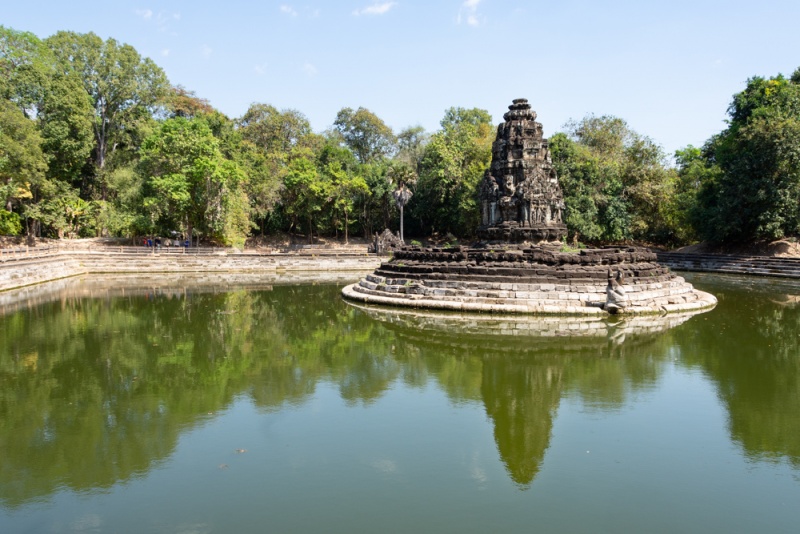
You’ll walk along a long walkway to reach Neak Pean. There is a big lake and some swampy areas below. Vendors selling fruit, cold drinks, and souvenirs are lined up near the entrance. And a few men who have lost limbs from land mines will serenade you while you walk (a small tip is appreciated).
The Neak Pean temple sits in the middle of a large man-made body of water. So you can’t enter it or even get very close. But the view of the temple with its reflection on the still water is a beautiful sight. You probably won’t need more than 30 minutes here.
Opening Hours: 7:30 am – 5:30 pm
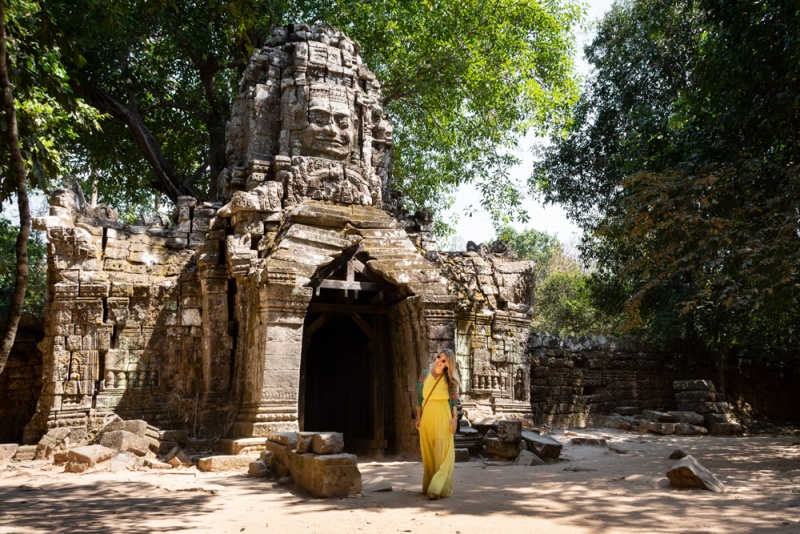
The Ta Som temple complex contains some of the most vibrantly colored, intricate stonework in the Angkor Complex. Bright green and red coloring add an interesting contrast to the grey stone structures. And you can really see how much detail was put into carving these amazing temples.
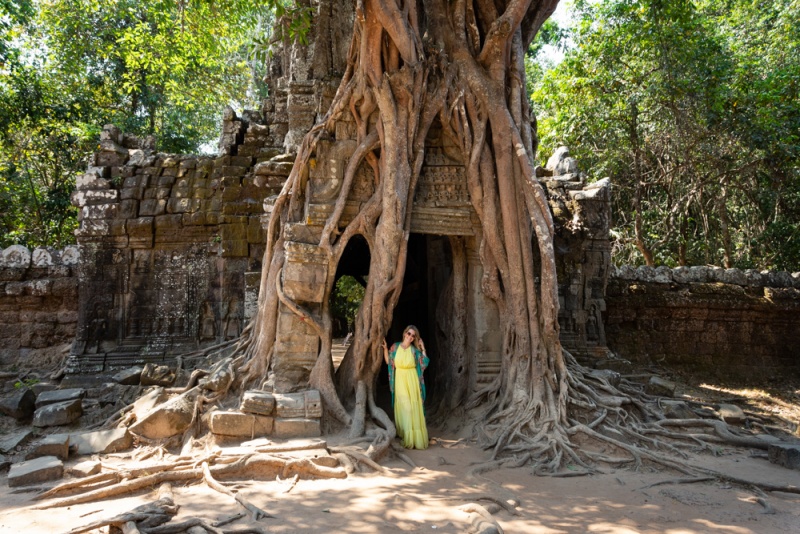
When you walk out of the back of Ta Som temple you’ll see several locals selling souvenirs here. Past them is an impressive gate with a large head standing watch from the top. Pass through the gate and look at it from the other side – it’s another example of the power of Mother Nature.
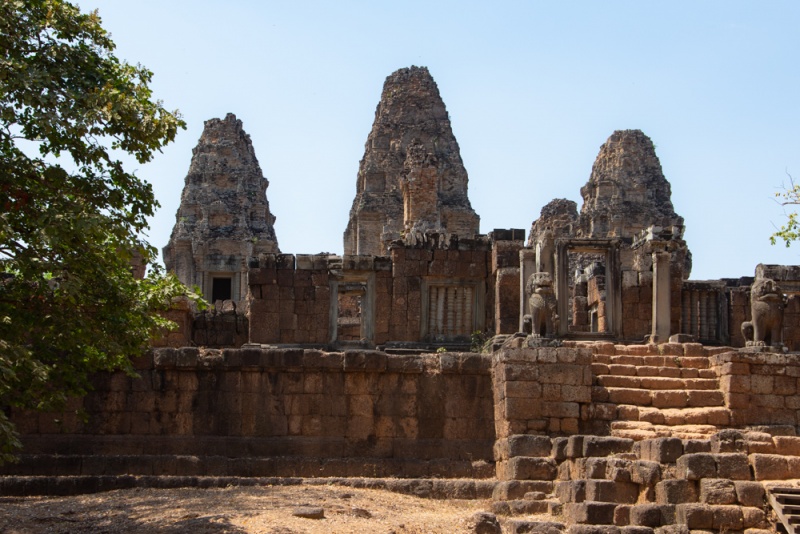
The East Mebon temple is quite similar to the Pre Rup temple (below), only with less stairs and no view. As you enter this temple you’ll pass through a small gate. Many tourists like to stop here as it is an ideal spot to see the temple in all of its glory. But be aware that this causes a bit of a traffic jam.
It won’t take long to see this small temple complex, 20 minutes should be plenty. There are some very nice women across the road selling fruit shakes and ice coffee if you find yourself here in the heat of the day and need some respite.
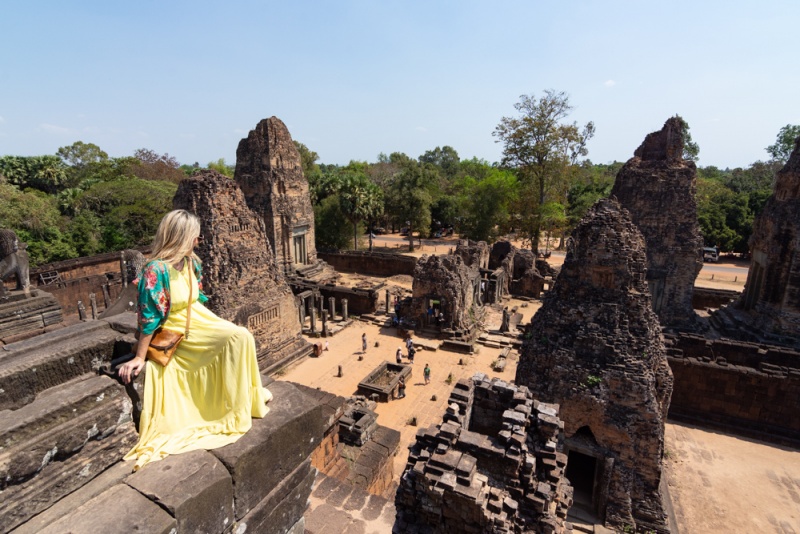
You’ll have to climb a set of very steep stairs to reach the top of the Pre Rup temple. The stairs are also very tall so it feels more like climbing a ladder. And with no handrails to speak of, this temple may be difficult for anyone with mobility issues or a fear of heights.
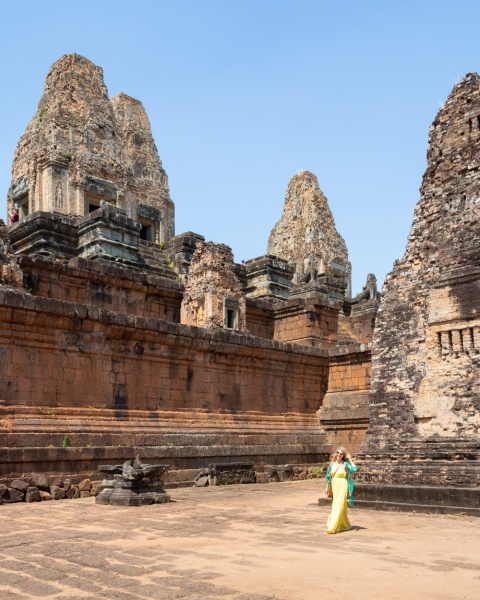
Once at the top, you’ll be rewarded with lovely views of the ruins below. There is one temple at the center, surrounded by four temples in the corners below, all in a similar pagoda style.
This temple is open early and stays open late so it’s a good option for sunrise and sunset if you are looking for an option other than the Angkor Wat temple.
Opening Hours: 5:00am – 7:00pm
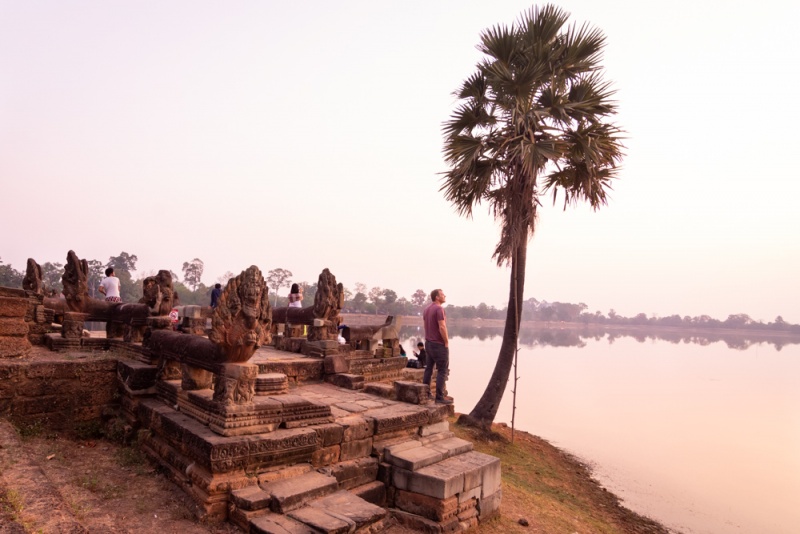
Srah Srang is technically part of the Small Circuit tour route , but you’ll also pass it at the end of the Grand Circuit. And you can probably convince your driver to make one last stop. The large man-made lake is a nice place to sit and relax before heading back to Siem Reap .
Some people choose to do the Grand Circuit in reverse order to try and avoid crowds at the temples. If this is your strategy, Srah Srang is a great place to watch sunrise away from the crowds of Angkor Wat. You’ll sit on the small stone platform at the west end of the lake and watch the sunrise across the water.
Opening Hours: 5:00am – 5:30pm
Enjoy the Grand Circuit Tour of Angkor Wat!
Want more information on the temples of Angkor? Check out our favorite guidebooks!
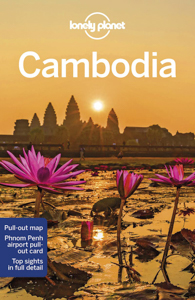
SHARE THIS ON PINTEREST
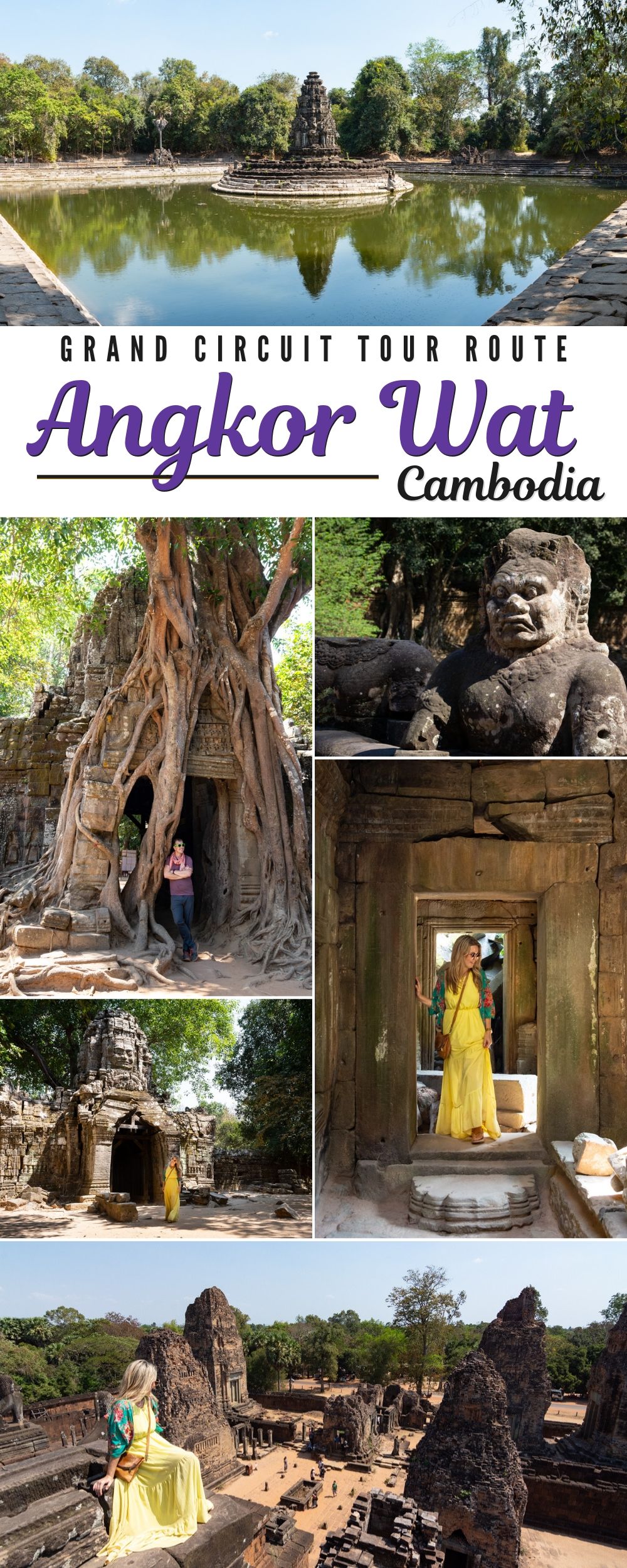
About the Author:

Val grew up in Portland, Oregon but moved to Oahu on a whim back in 2013. She sold her house and all of her belongings and bought a one-way ticket. Since then she’s taken two around-the-world trips and has visited 60-ish countries while living out of a duffel bag. Val started documenting the Wandering Wheatleys travels back in 2013 as a way to update friends and family about her whereabouts and to relay humorous daily interactions. The only readers were her mom and her mother-in-law but that didn’t stop her! These days you’ll find Val dreaming up future trips, creating new travel content, managing a team of amazing travel enthusiasts, and chasing around her two adorable but naughty kids.
View all posts
Related Posts
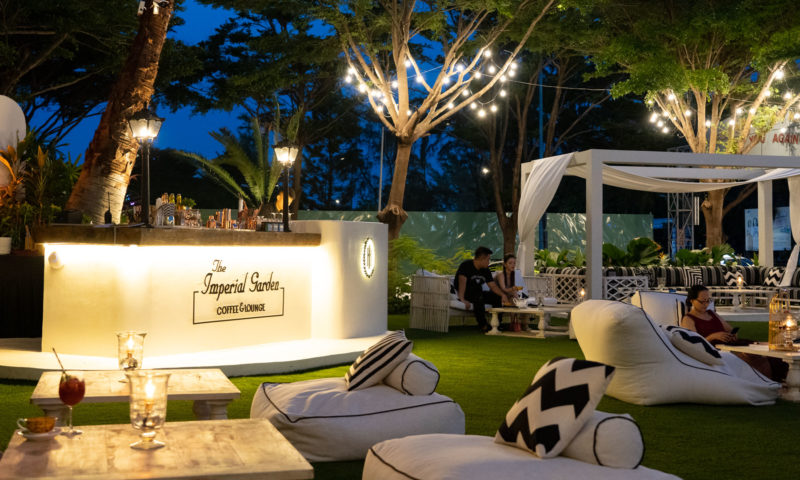
Where to Stay in Vung Tau: 6 Beautiful Hotels and Resorts
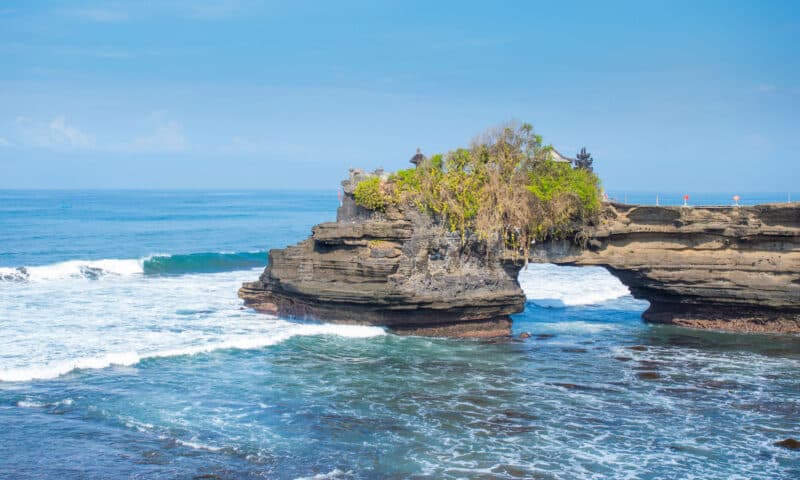
3 Days in Canggu: The Perfect Weekend Itinerary
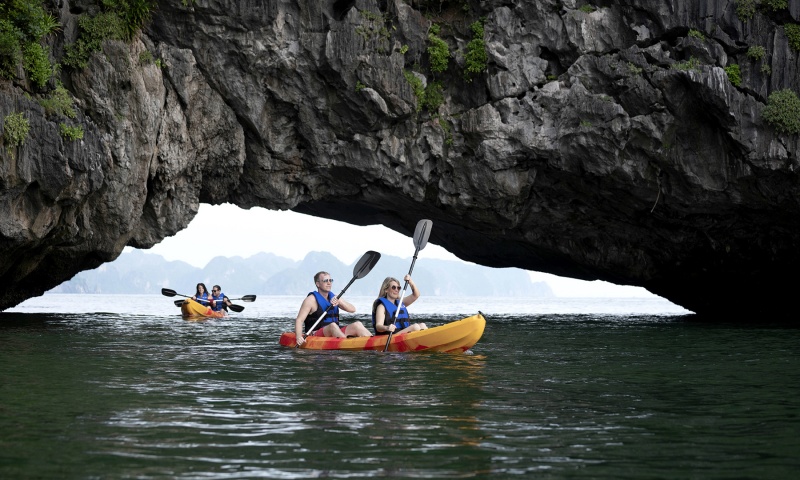
How We Became Models on a Vietnamese Cruise Ship
1 thought on “angkor wat: guide to the grand circuit tour”.
I used Nakry for my trip to Siem Reap and got his details via your blog. Thanks for that! He is awesome.
Leave a Comment Cancel Reply
Your email address will not be published. Required fields are marked *
The Best Time to Visit Angkor Wat
:max_bytes(150000):strip_icc():format(webp)/greg-rodgers-adventure-ed92646b25f247049e53af6d36f6c15f.jpg)
TripSavvy / Paula Galindo Valle
Choosing the best time to visit Angkor Wat can be a little tricky. You almost have to choose between rain and muddy temple sites or good weather with hordes of people who always seem to be in the way of photographs. Following the typical weather patterns for much of Southeast Asia, the best time to visit Angkor Wat in Cambodia is during the dry season from late November to early April.
Fortunately, with a little timing, you can take advantage of the best times to visit Angkor Wat. Even better, travelers who hire drivers to visit ruins farther afield get rewarded with those Tomb-Raider-Indiana-Jones photos with no other tourists in the backdrop.
Peak Season at Angkor Wat
Cambodia’s crown jewel, the ruins of Angkor Wat and the surrounding Khmer temples, lure more than two million foreign visitors per year. Sometimes you'll feel as though at least a million chose the same day as you to visit!
While rain can detract from the experience during the monsoon season, heavy crowds—also a nuisance—descend on the ruins during the peak of the dry season. Although Angkor Wat is open all year, getting good photos of the vine-strangled temples without scores of tourists clamoring around on them requires a bit of good timing. Even arriving very early in the morning is no guarantee you will enjoy tranquility at the primary temple sites.
December and January are the best-weather months, but they are also the busiest as hordes of visitors and tour buses flock to see the monuments. Peak season runs roughly from December to the end of February.
The Weather at Angkor Wat
April and May are unbearably hot months in Cambodia. Avoid them unless you can handle heat and suffocating humidity as you explore the ancient temples. During these peak-heat months, you can enjoy more personal space at temples—assuming you don't mind a heat stroke or three.
To really get the most out of your three-day-pass to Angkor Wat, consider timing your visit to coincide with one of the shoulder months between the monsoon season and dry season. November and March are often good compromise months for Angkor Wat. With a little luck, you'll still have sunny days that aren't scorching hot but fewer crowds with which to contend for photos.
Monsoon rains move in around late May or June and persist until the end of October. September and October are typically the wettest months, with more than 15 inches of rainfall, while January receives the most sunshine .
December through February are dry but are among the busiest months with tourists clamoring for photos.
Other Factors to Consider
The Lunar New Year festival (which includes Chinese New Year and Tet in nearby Vietnam) causes nearly every popular place in Southeast Asia to become extremely busy for a couple of weeks as millions of people travel during days off. Accommodation prices go up, and negotiating a better deal at hotels becomes difficult. Dates change annually , but the Lunar New Year holiday hits in January or February.
Angkor Wat is open 365 days a year, from 5 a.m. until 6 p.m. (closing time is only loosely enforced, so you can exit at your leisure until darkness falls).
Although the Angkor complex is open 365 days a year, it may be busier than usual on Cambodian public holidays. Many holidays are based on the lunar-solar calendar; dates change from year to year.
The Khmer New Year (coincides with Songkran in Thailand ; always mid-April) may not be the best time to visit Angkor Wat. Instead, enjoy the unique festivities.
More backpackers traveling along the Banana Pancake Trail in Southeast Asia tend to visit during the summer months while taking a break from school. You may not notice; Siem Reap is often in perpetual party mode.
Monsoon Season at Angkor Wat
Visiting during Cambodia's monsoon season presents several new challenges . Aside from the distinct disadvantage of having to explore the many outdoor temples in the drenching rain, roads can become rutted, muddy, and impassable during heavy downpours.
Remote temple sites may become difficult, if not impossible, to reach. Low areas turn into muddy pits, eliminating options such as biking leisurely around the area. Despite best efforts, getting photos of the memorable temples will be more difficult during torrential rains.
On the plus side, visiting Angkor Wat during the monsoon season means less competition for stairs and photos. You can still luck out with spurts of sunshine, sometimes consecutive days at a time, even during the monsoon season. Intense showers may only pop up in the afternoons, leaving you with plenty of time to explore each morning.
Additionally, mosquitoes are more of a problem during the wet season. Know how to avoid mosquito bites while traveling. Dengue fever is a problem in the area.
Events to check out:
- The Khmer New Year, also called Chaul Chnam Thmey, spans three days in mid-April. This is the most popular and festive holiday across Cambodia; celebrations include parades, festivals, fireworks, and more.
- October 15 is a national holiday commemorating the memory of His Majesty Preah Bat Samdech Preah Norodom Sihanouk. He was the ruler of Cambodia immediately after the country gained its independence from France.
Dry Season at Angkor Wat
The most popular time to visit Angkor Wat is during the dry season, which typically runs from November through March. These days are cooler and dry, but this is also the most popular time to visit, which means crowds.
Even though these months are technically "winter," temperatures are still quite warm. January, which is the coldest month in Cambodia, only sees lows of 70 F (21 C). However, despite the more mild temperatures, weather during this season can still be somewhat unpredictable. You should be prepared for unexpected rain showers or the occasional heatwave to roll through.
If you're planning a visit during the dry season, book your hotels and restaurants early. If you don't plan ahead, you might set yourself up for disappointment.
- Cambodia celebrates its Independence Day on November 9. This holiday was established to celebrate the country's independence from France in 1953.
- January 7 is another important day in Cambodian history. This day, Victory Day commemorates the end of the Khmer Rouge regime in 1979.
How Long to Spend at Angkor Wat
To visit Angkor Wat, you’ll have to purchase either a one-day, three-day or week-long pass.
Although travelers with tight itineraries in Southeast Asia try to squeeze in as many sights as they can in a day, remember that the Angkor complex is actually the largest religious monument in the world. It's spread over 402 hectares of jungle. You’re going to need more time than you think to not end up rushing around.
The temples are scattered all over Cambodia . If you're serious about exploring ancient Khmer ruins, plan on purchasing at least the three-day pass. Doing so is less expensive and troublesome than buying two one-day passes; you will end up wanting more than one day there.
The best time to visit Angkor Wat in Cambodia is during the dry season (late November to early April), however, you may encounter hordes of tourists at this popular destination.
It's best to spend at least three days exploring Angkor Wat in Cambodia. Visiting the intricate temple buildings involves climbing many stairs and trekking into the forest. You'll have the best experience if you take your time.
Plan to wear appropriate attire when visiting the sacred temples. Clothing items include long pants that cover the knee and shirts that cover the shoulders. Skirts, short shorts, tank tops, and other revealing clothing items are not permitted on temple grounds.
Radio Free Asia. "Tourist Numbers Fall at Cambodia's Historic Angkor Wat." Retrieved February 2, 2021.
Tourism Cambodia. "Angkor Archeological Park - Angkor Wat Guide." Retrieved February 2, 2021.
IAMAT. "Cambodia: Dengue." Retrieved February 2, 2021.
History.com. "Angkor Wat." Retrieved February 2, 2021.
Angkor Wat in Cambodia
February in Asia: Weather, What to Pack, and What to See
Where Is Angkor Wat?
Traveling to Cambodia: Essentials to Know
The Best Time to Visit the Maldives
A Beginner's Guide to Siem Reap, Cambodia
Cambodia Guide: Planning Your Trip
Top UNESCO World Heritage Sites in Southeast Asia
The 13 Best Things to Do in Siem Reap
Cambodia's Biggest Festivals
January in Asia: Weather, What to Pack, and What to See
What $100 Can Get You in Southeast Asia
Phnom Penh, Cambodia Guide: Planning Your Trip
The Best Time to Visit Japan
Vital Information for the First-Time Visitor to Thailand
Winter in Asia: Weather, What to Pack, and What to See
- History Classics
- Your Profile
- Find History on Facebook (Opens in a new window)
- Find History on Twitter (Opens in a new window)
- Find History on YouTube (Opens in a new window)
- Find History on Instagram (Opens in a new window)
- Find History on TikTok (Opens in a new window)
- This Day In History
- History Podcasts
- History Vault
By: History.com Editors
Updated: June 22, 2023 | Original: February 28, 2018

Angkor Wat is an enormous Buddhist temple complex located in northern Cambodia. It was originally built in the first half of the 12th century as a Hindu temple. Spread across more than 400 acres, Angkor Wat is said to be the largest religious monument in the world. Its name, which translates to “temple city” in the Khmer language of the region, references the fact it was built by Emperor Suryavarman II, who ruled the region from 1113 to 1150, as the state temple and political center of his empire.
Originally dedicated to the Hindu god Vishnu, Angkor Wat became a Buddhist temple by the end of the 12th century.
Although it is no longer an active temple, it serves as an important tourist attraction in Cambodia, despite the fact it sustained significant damage during the autocratic rule of the Khmer Rouge regime in the 1970s and in earlier regional conflicts.
Where Is Angkor Wat?
Angkor Wat is located roughly five miles north of the modern Cambodian city of Siem Reap, which has a population of more than 200,000 people.
However, when it was built, it served as the capital of the Khmer empire, which ruled the region at the time. The word “Angkor” means “capital city” in the Khmer language, while the word “Wat” means “temple.”
Initially, Angkor Wat was designed as a Hindu temple, as that was the religion of the region’s ruler at the time, Suryavarman II. However, by the end of the 12th century, it was considered a Buddhist site.
Unfortunately, by then, Angkor Wat had been sacked by a rival tribe to the Khmer, who in turn, at the direction of the new emperor, Jayavarman VII, moved their capital to Angkor Thom and their state temple to Bayon, both of which are a few miles to the north of the historic site.
As Angkor Wat’s significance within the Buddhist religion of the region increased, so too did the legend surrounding the site. Many Buddhists believe the temple’s construction was ordered by the god Indra, and that the work was accomplished in one night.
However, scholars now know it took several decades to build Angkor Wat, from the design phase to completion.
Angkor Wat’s Design
Although Angkor Wat was no longer a site of political, cultural or commercial significance by the 13th century, it remained an important monument for the Buddhist religion into the 1800s.
Indeed, unlike many historical sites, Angkor Wat was never truly abandoned. Rather, it fell gradually into disuse and disrepair.
Nonetheless, it remained an architectural marvel unlike anything else. It was “rediscovered” in 1840s by the French explorer Henri Mouhot, who wrote that the site was “grander than anything left to us by Greece or Rome.”
The compliment can likely be attributed to the temple’s design, which is supposed to represent Mount Meru, the home of the gods, according to tenets of both the Hindu and Buddhist faiths. Its five towers are intended to recreate the five peaks of Mount Meru, while the walls and moat below honor the surrounding mountain ranges and the sea.
By the time of the site’s construction, the Khmer had developed and refined their own architectural style, which relied on sandstone. As a result, Angkor Wat was constructed with blocks of sandstone.
A 15-foot high wall, surrounded by a wide moat, protected the city, the temple and residents from invasion, and much of that fortification is still standing. A sandstone causeway served as the main access point for the temple.
Inside these walls, Angkor Wat stretches across more than 200 acres. It’s believed that this area included the city, the temple structure and the emperor’s palace, which was just north of the temple.
However, in keeping with tradition at the time, only the city’s outer walls and the temple were made of sandstone, with the rest of the structures built from wood and other, less durable materials. Hence, only portions of the temple and city wall remain.
Even so, the temple is still a majestic structure: At its highest point—the tower above the main shrine—it reaches nearly 70 feet into the air.
The temple walls are decorated with thousands of bas-reliefs representing important deities and figures in the Hindu and Buddhist religions as well as key events in its narrative tradition. There is also a bas-relief depicting Emperor Suryavarman II entering the city, perhaps for the first time following its construction.
Angkor Wat Today
Unfortunately, although Angkor Wat remained in use until fairly recently—into the 1800s—the site has sustained significant damage, from forest overgrowth to earthquakes to war.
The French, who ruled what is now known as Cambodia for much of the 20th century, established a commission to restore the site for tourism purposes in the early 1900s. This group also oversaw ongoing archeological projects there.
While restoration work was accomplished in bits and pieces under French rule, major efforts didn’t begin in earnest until the 1960s. By then, Cambodia was a country transitioning from colonial rule to a limited form of constitutional monarchy.
When Cambodia fell into a brutal civil war in the 1970s, Angkor Wat, somewhat miraculously, sustained relatively minimal damage. The autocratic and barbarous Khmer Rouge regime did battle troops from neighboring Vietnam in the area near the ancient city, and there are bullet holes marking its outer walls as a result.
Since then, with the Cambodian government undergoing numerous changes, the international community, including representatives of India, Germany and France, among others, have contributed to the ongoing restoration efforts.
The site remains an important source of national pride for Cambodians.
In 1992, it was named a UNESCO World Heritage site. Although visitors to Angkor Wat numbered in just the few thousands at the time, the landmark now welcomes some 500,000 visitors each year—many of whom arrive early in the morning to capture images of the sunrise over what still is a very magical, spiritual place.
Angkor. World Heritage Convention. UNESCO . Ray, Nick. “Angkor what? Getting to know Cambodia’s most iconic temple.” LonelyPlanet.com . Glancey, J. “The surprising discovery at Angkor Wat.” BBC.com . Hoeller, S-C. (2015). “Here’s why Angkor Wat was just named the best tourist attraction in the world.” BusinessInsider.com . Cripps, K. (2017). “Angkor Wat travel tips: Expert advice on visiting Cambodia’s ancient ruins.” CNN.com .

HISTORY Vault
Stream thousands of hours of acclaimed series, probing documentaries and captivating specials commercial-free in HISTORY Vault

Sign up for Inside History
Get HISTORY’s most fascinating stories delivered to your inbox three times a week.
By submitting your information, you agree to receive emails from HISTORY and A+E Networks. You can opt out at any time. You must be 16 years or older and a resident of the United States.
More details : Privacy Notice | Terms of Use | Contact Us
Useful Resources
- Tourist Information Center
- CBET Destinations
- Advice for Travelers
- Where to Shop
- Public Holidays
- Currency Exchange
- Video & Tourism Spot
- Weather & Forecast
- Tourism Law

Angkor Wat - Heritage of Humanity and World Wonder
Unlike most Angkorian temples, Angkor Wat is built facing to the west and this has scholars divided as to its significance.
This magnificent temple combines two basic plans of Khmer temple architecture; the temple mountain and the later galleried temple, based on early South Indian Hindu architecture. Surrounded by a moat, an outer wall with three rectangular galleries, and a quincunx of towers in the center, clearly indicates that the Angkor Wat temple was designed to represent Mount Meru, home of the devas in Hindu mythology. The extensive bas-reliefs and the numerous guardian spirits adorning its walls serve as evidence of the strong Khmer religious beliefs.
The position of the temple is orientated to connect the earth with the sky. The sun raises exactly on the peak of the main Angkor Temple twice a year, at the so-called equinox – time of the year when the sun crosses the plane of the earth’s equator and day and night are of equal length.
Researchers also discovered that the main route to Angkor Wat temple differs by three quarters of a degree from the east-west axis to the north. According to the precession of the earth’s axis, the North Pole is not fixed but moves like a spiral. This happens extremely slowly at around 72 years for each degree. It takes about 26,000 years for a complete revolution.
Multiplying the precession of the earth’s axis – the aforementioned three quarters of a degree – with the number 72 results in the number 54. The number 54 is frequently observed in Angkor Park. For example, the four-faced towers at the Bayon Temple or the guards in front of the South Gate of the city of Angkor Thom.
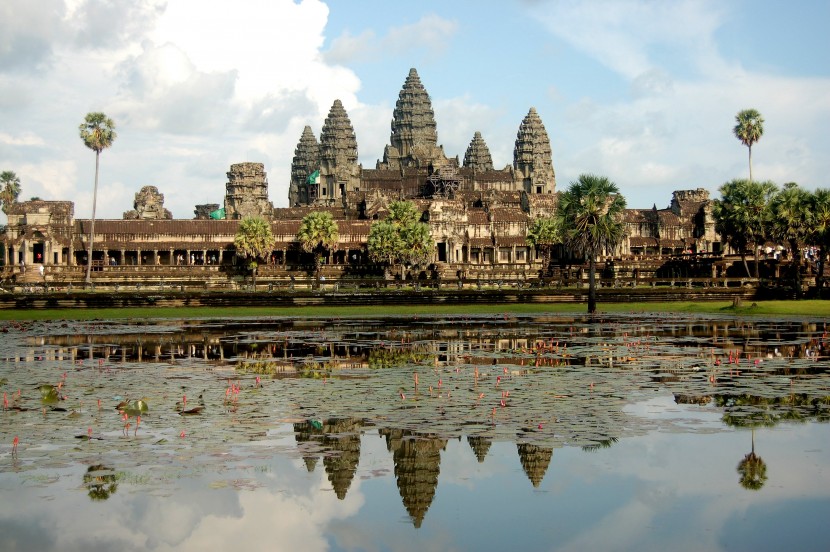
Angkor Thom Temple
Built between the late 12th and early 13th century by Jayavarman VII, the greatest king of Angkor, the 9 sq km fortified city of Angkor Thom, was the...
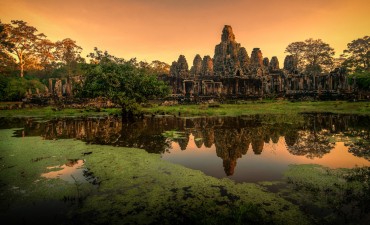
Bayon Temple
The Bayon is a richly decorated Khmer temple built in the late twelfth or early thirteenth century.
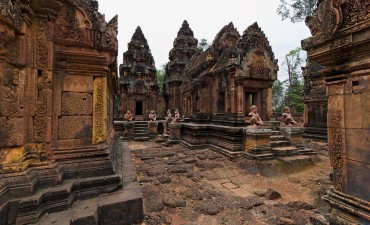
Banteay Srei Temple
Consecrated in 967 A.D, Banteay Srei was speculated to have been known earlier as Banteay Serai, which
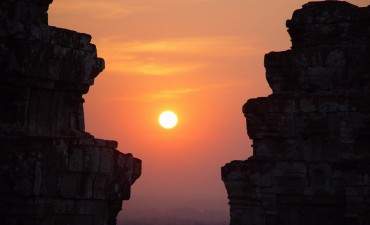
Phnom Bakheng
Phnom Bakheng was constructed more than two centuries before the Angkor Wat. It is a Hindu temple
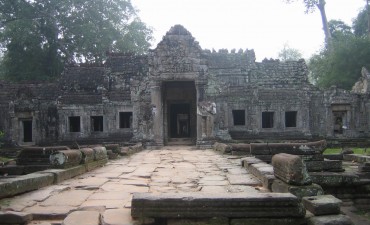
Preah Khan Temple
Preah Khan was built on the site of Jayavarman VII’s victory over the invading Chams in 1191.
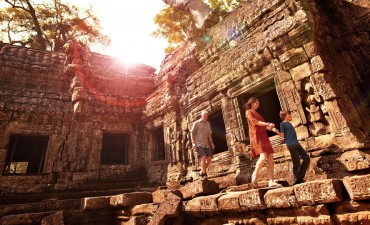
Ta Prohm Temple
Ta Prohm, known for the huge trees and the massive roots growing out of its wall, is believed to have been built in the late twelfth and early thirtee...
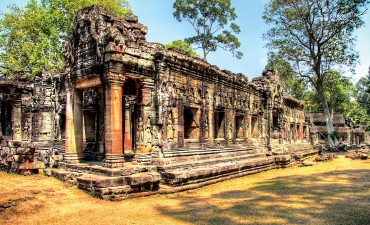
Banteay Kdei Temple
Built in the late twelfth to early thirteenth century during the reign of Jayavarman VII, Banteay Kdei is known
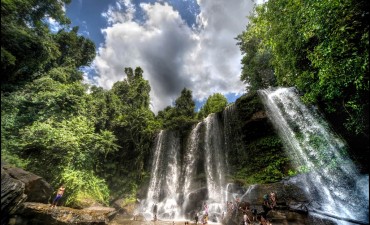
Kulen Mountain National Park
The Kulen Mountain or Phnom Kulen is declared as a National Park. It is an isolated mountain massif located
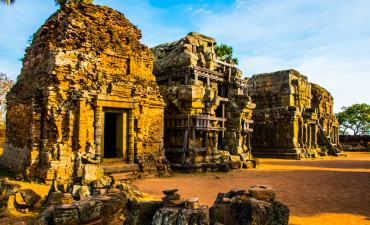
Tonle Sap, the largest freshwater lake in Southeast Asia, is itself a natural wonder and has for centuries been at the core of Cambodian life. This g...
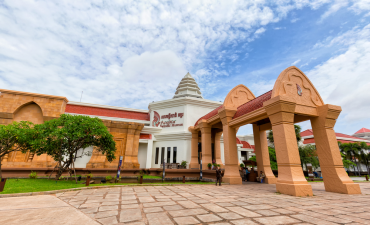
Angkor National Museum
The Angkor National Museum is classified as one of Cambodia’s premier museum sites. On display are
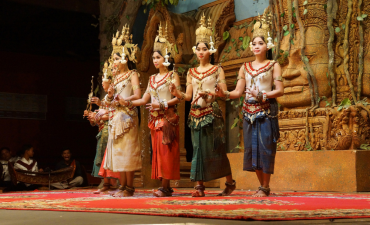
Cultural Village
The Cambodian Cultural Village is designed to provide tourists with an excellent insight into the life and
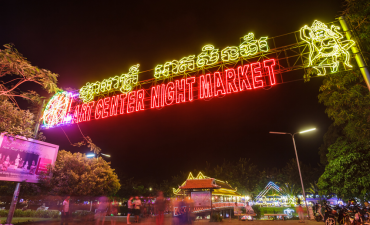
Siem Reap Night Market
No holiday experience is complete without the thrills of shopping at a local night market; In Phnom Penh, the night market opens only on weekends unli...
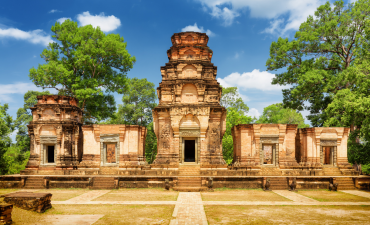
Kravan Temple
Built by King Harshavarman I in the early 10th century and dedicated to Hindusim.
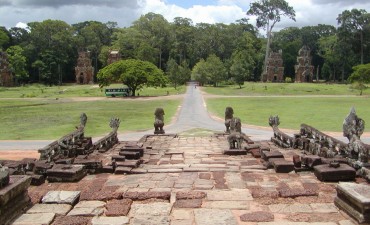
Terrace of the Elephants
The Terrace of the Elephants is part of the walled city of Angkor Thom. The terrace was used by king
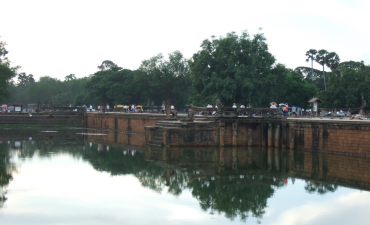
Srah Srang ‘the royal bath’
It was perhaps a chapel to Kama, God of Love. The spot would suit the temper of the strange power, terribly
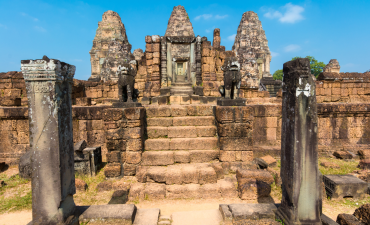
East Mebon Temple
East Mebon temple is a large temple-mountain-like ruin, rising three levels and crowned by five towers.
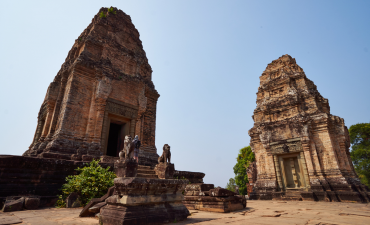
Pre Roup Temple
Architecturally and artistically superior temple-mountain. Beautifully carved false doors on upper level, as well
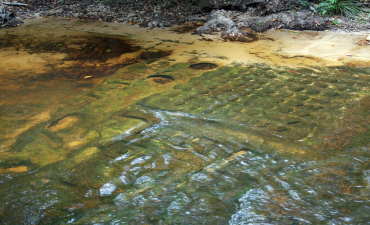
River of One-Thousand Lingas
It is located at the foot of the mountain. Along the river of Siem Reap, there are a lot of figures of Yoni and
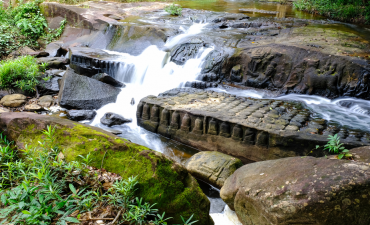
This holy place must have been favored during the great Angkorean epoch when its waters, after having
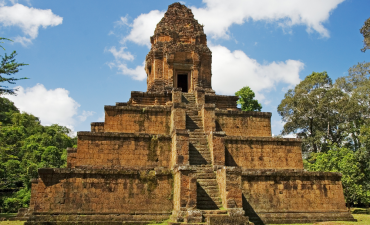
Baksei Chamkrong
A towering 12-meter tall brick and laterite step-pyramid. Harshavarman I began construction or perhaps
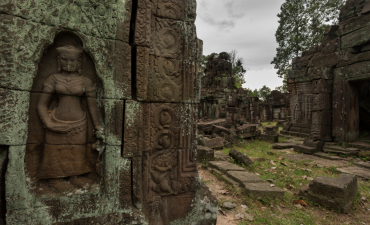
Banteay Prei
Small, untouristed temple near Neak Pean. Similar to Ta Som in architectural/artistic style and scale. Some of
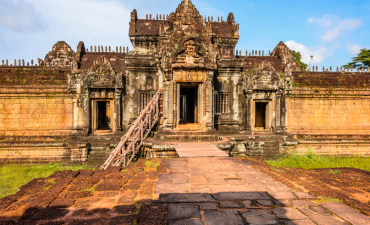
Banteay Samre
Large, comparatively flat temple displaying distinctively Angkor Wat-style architecture and artistry. The temple
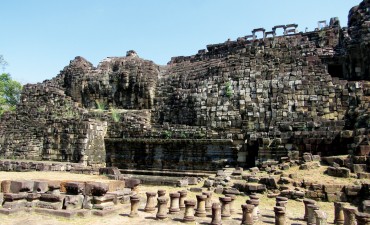
Baphuon : Huge temple-mountain in the heart of Angkor Thom. Largely collapsed and in ruined condition, the
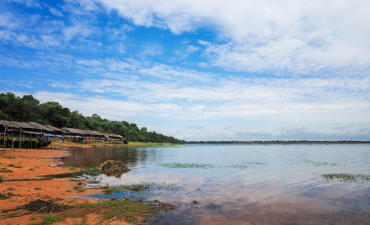
A ´baray´ is a water reservoir – an area of land where dikes have been raised to catch and hold water.
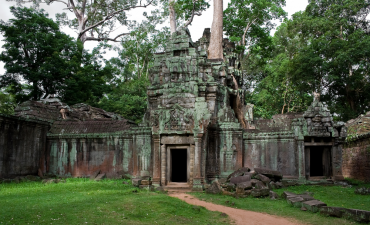
Trio of small brick towers on a platform with two surviving lintels in pretty good condition. Bat Chum is a
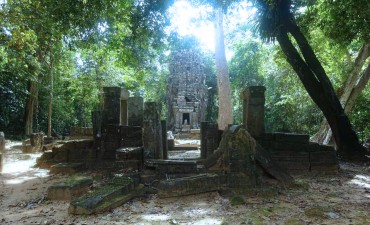
Chapel of the Hospital
102 hospitals were built throughout the empire under Jayavarman VII. The hospital itself was probably
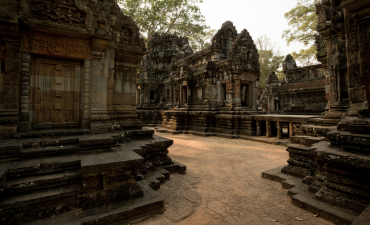
Chau Say Tevoda
Chau Say Tevoda is a small temple of similar design and floor plan to that of Thommanon located across the
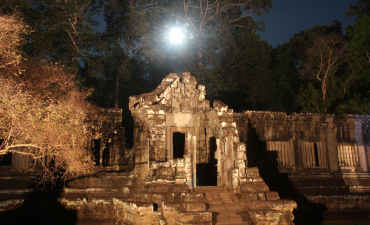
Kleangs (North and South)
Rectangular sandstone building set opposite the Terrace of Elephants, behind the Prasat Suor Prat. ‘Kleang’
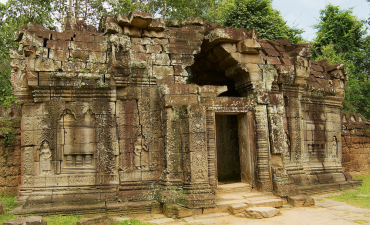
A small temple with a single central tower surrounded by two laterite walls. Pediments displaying the most
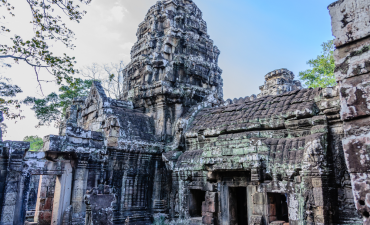
Kutisvara temple
Prasats in a severe state of ruin. Some carving visible. Kutisvara was mentioned in an inscription in connection
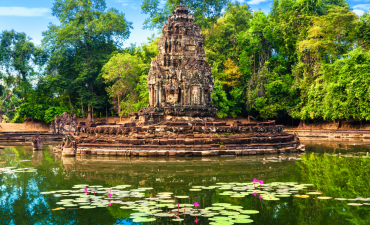
A small island temple located in the middle of the last baray (the Preah Khan Baray or Jayatataka) to be
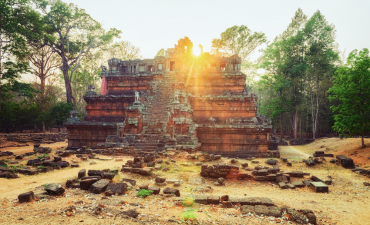
Phimeanakas temple
Impressive laterite and sandstone pyramid. The lack surviving carvingleaves it artistically uninteresting. But it
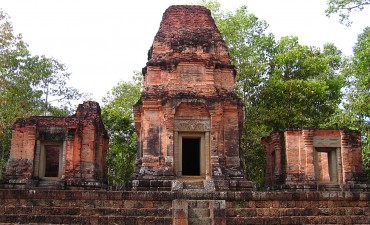
Prasat Bei temple
A set of three brick towers between Baksei Chamkrong and the moat of Angkor Thom near the South Gate.
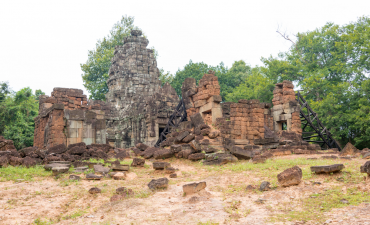
Prasat Prei temple
Prasat Prei temple is small, untouristed temple ruins in a forest near Neak Pean. Remains of a gopura, the
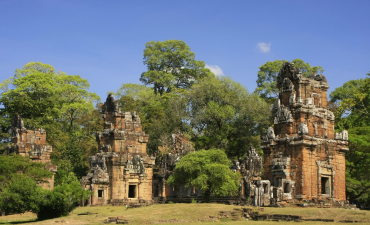
Prasat Suor Prat
Twelve nearly identical laterite and sandstone towers that stand opposite and parallel to the Terrace of the
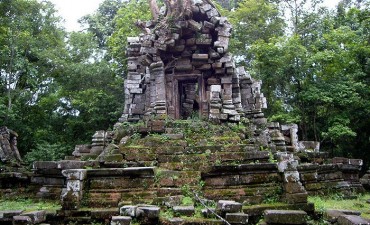
Prasat Top (East)
Angkor Thom: Architecturally unimpressive but historically important small tower. Also known as ‘Monument
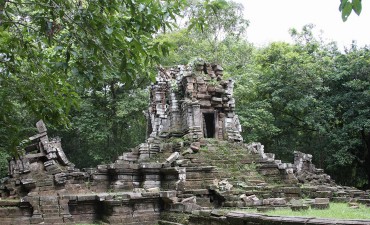
Prasat Top (West)
Small, ruined towers standing in a quiet section of Angkor Thom. Inscriptions indicate that the site was used
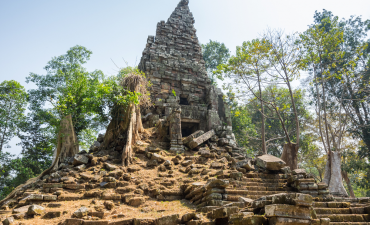
Preah Palilay
Picturesque sandstone and laterite tower in a cool, shaded forest setting, in the area behind the Terrace of
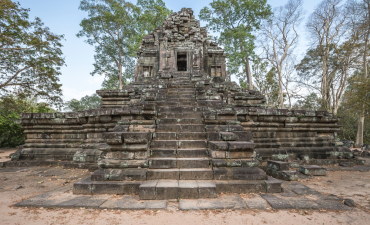
Preah Pithu Group
Five small temples set in a quiet area opposite the Terrace of the Leper King. Most of the construction is from
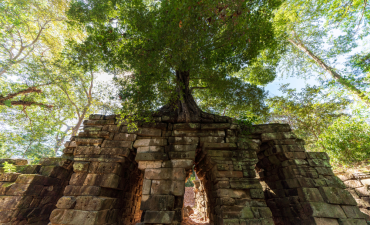
‘Spean Thma’ literally translates to ‘Stone Bridge’. Remnants of an ancient bridge over the Siem Reap River.
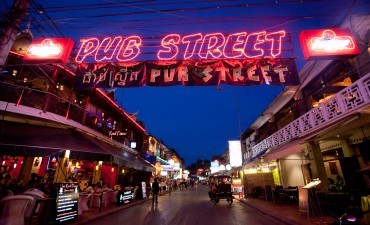
In Siem Reap, after returning from the temple tours in the evening, many tourists are taken to the Pub Street
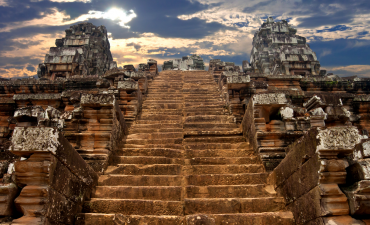
Towering but plainly decorated temple-mountain dedicated to Shiva. Known in its time as ‘the mountain with
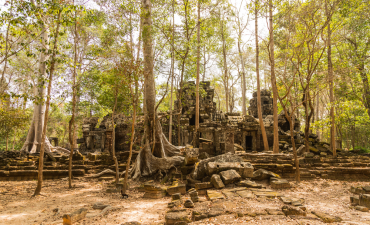
Ta Nei temple
Small (55m x 47m), semi-ruined, untouristed jungle temple reminiscent of Ta Som, displaying classic
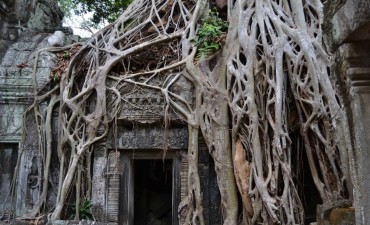
Ta Prohm Kel
A single small sandstone tower located opposite Angkor Wat, Ta Prohm Kel is the ruin of the temple or
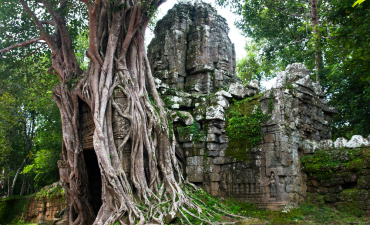
Small, classic Bayon-style monastic complex consisting of a relatively flat enclosure, face tower gopuras and
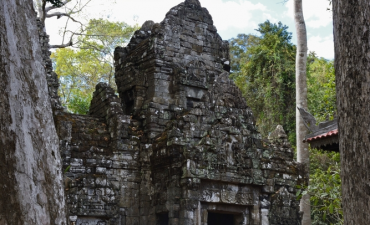
A long walkway with a Buddha figure at the far end. Tep Pranam was originally a Buddhist shrine in the 9th
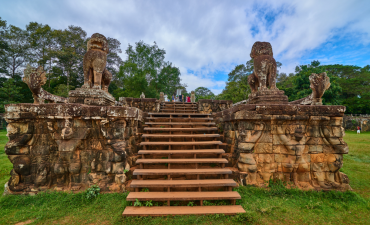
Terrace of the Leper King
A double terrace wall at the north end of the Terrace of Elephants with deeply carved nagas, demons and
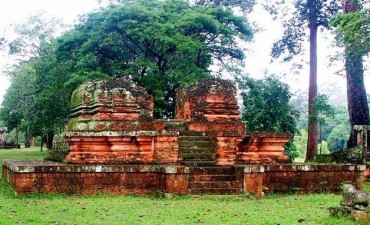
Thma Bay Kaek temple
The spare remains of a brick prasat, now disappeared, leaving only a doorframe, lintel and a bit of the terrace.
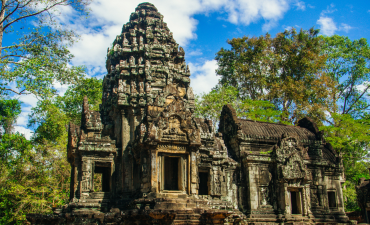
Small, attractive temple in very good condition, built at the same time as Angkor Wat. The Angkor Wat style
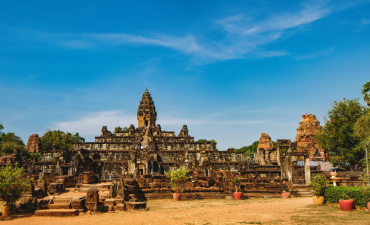
Roluos Group: The most impressive member of the Roluos Group, sitting at the center of the first Angkorian
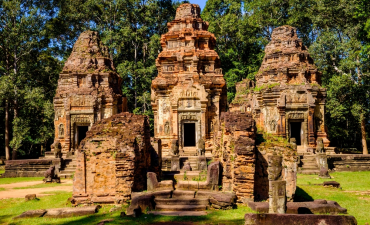
Roluos Group: Six towers displaying set on a platform, all beautifully preserved carvings. Originally
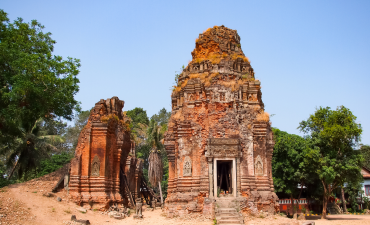
Roluos Group: Ruins of an island-temple built in the middle of a now dry baray, Indratataka, the first large-
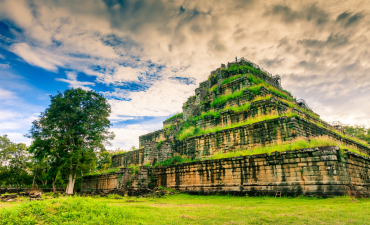
The temple complex at Koh Ker, northeast of Siem Reap, represents the remnants of the capital of the
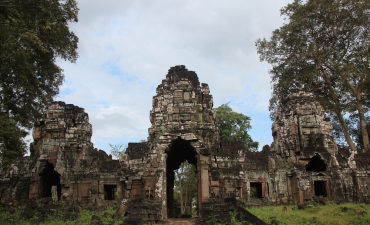
Preah Khan of Kampong Svay
A jungle temple of many names: Preah Khan of Kampong Svay, Preah Khan of Kampong Thom and Prasat
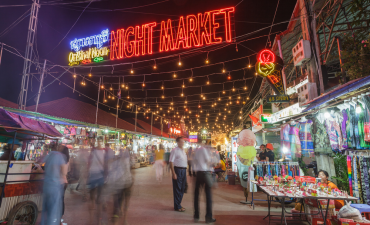
Around Siem Reap
Tourists visit Siem Reap largely for the Angkor Archaeological Park. However, there are much more this wonderful city can offer to make your holiday...
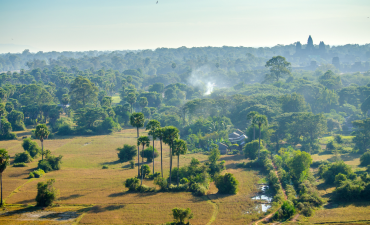
Angkor balloon
It is situated in road from airport to Angkor Wat, 1km west of Angkor Wat, Siem Reap. Opening time is from
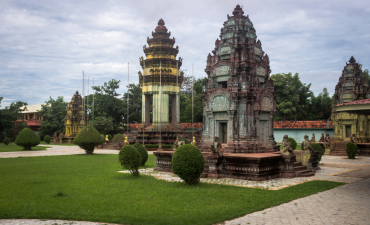
The Museum is situated in Kacam Village of Siem Reap Province, and opening time is from 8:00 to 15:30. I
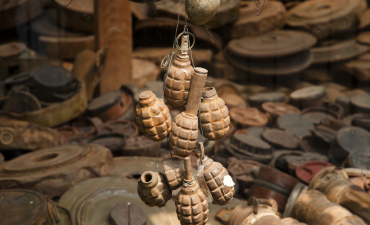
Landmine Museum
It is situated on the way to Banteay Srei Temple, Siem Reap. It was founded by a veteran using most of his
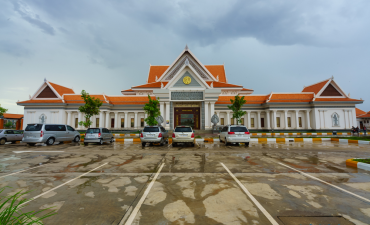
Preah Norodom Sihanouk-Angkor Museum
It is situated in Boeung Don Pa Village, Slakram Commune, Siem Reap. It was opened in 2008. In the
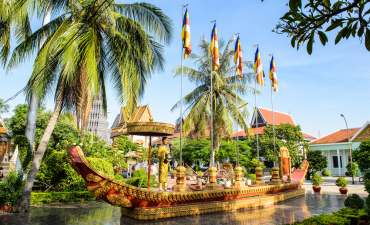
Royal Garden
There is a small palace which the king stays in the garden; it is smaller if compare with the palace in Phnom

Angkor Silk Farm
It is situated in Tortea Village, Knoberiel Commune, Siem Reap. The silkworm breeding and silk center has the

Angkor Golf Resort
It is situated in Kasekam Village, Sra Nga Commune, Siem Reap. The golf course with the 7279 miles, 18

Pub Street is so named because it is lined end to end on both sides by pubs, restaurants and shops. This Centre for pubs, clubs, and bars, is filled...
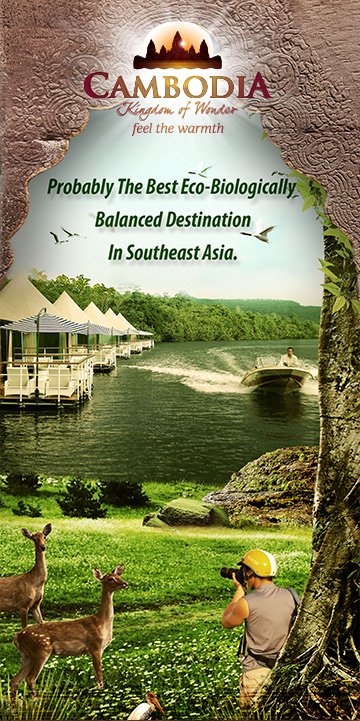
Provincial Guides
Phnom Penh (Capital City) Rattanakiri Mondulkiri Siem Reap Preah Sihanouk Stung Treng Kratie Preah Vihear Kampot Kep Koh Kong Kampong Thom Kandal Takeo Battambang Kampong Cham Kampong Chhnang Kampong Speu Pursat Oddar Meanchey Pailin Prey Veng Svay Rieng Banteay Meanchey Tbong Khmum
This website, Tourismcambodia.org, the official website of Ministry of Cambodia of the Kingdom of Cambodia, is designed and maintained collaboratively by RED DOT (Cambodia) Co., Ltd and Cybernetics Ltd a full service branding and advertising agency in Cambodia. While efforts are made to ensure that all the information hereto are good, accurate and up to date, by visiting the website Tourismcambodia.org, viewing, accessing or otherwise using any of the services or information created, collected, compiled or submitted to Tourismcambodia.org, you agree to be bound by the our Terms and Conditions of Use, (Click here). If you do not want to be bound by our Terms, your only option is not to visit, view or otherwise use the services of Tourismcambodia.org. You understand, agree and acknowledge that these Terms constitute a legally binding agreement between you and Tourismcambodia.org and that your use of Tourismcambodia.org shall indicate your conclusive acceptance of this agreement.
© 2024 | DESIGNED & HOSTED BY: RED DOT (CAMBODIA) CO., LTD | All Rights Reserved. Disclaimer

Visit Koh Ker - The UNESCO World Heritage List
VIEW DETAILS
Book Tour to Angkor Wat
What To See
Angkor complex, angkor thom, bakheng mountain, baksei chamkrong, banteay srei, banteay kdei, banteay samre, bayon temple, beng mealea, chau say tevoda, phimean akas, preah palilay, preah pithu, roluos group, spean thmar, ta prohm - jungle temple, terrace of elephants, terrace of leper king, chapel of the hospital, phnom kulen, phnom penh city, sihanoukville - beach, mondulkiri - minority, rattanakiri - ecotourism, kampot - sea foods, kratie - dolphin, kampong thom, preah vihear, kirirom resort, banteay chhmar temple, book hotels in cambodia.

Angkor Wat - 7th Wonder of the World
Angkor wat - world wonder list.
Angkor Wat, in its beauty and state of preservation, is unrivaled. Its mightiness and magnificence bespeak a pomp and a luxury surpassing that of a Pharaoh or a Shah Jahan, an impressiveness greater than that of the Pyramids, an artistic distinctiveness as fine as that of the Taj Mahal. Angkor Wat is located about six kilometers (four miles) north of Siem Reap, south of Angkor Thom . Entry and exit to Angkor Wat can only be access from its west gate.
Angkor Wat was built in the first half of the 12th century (113-5BC). Estimated construction time of the temple is 30 years by King Suryavarman II, dedicated to Vishnu (Hindu), replica of Angkor Thom style of art.
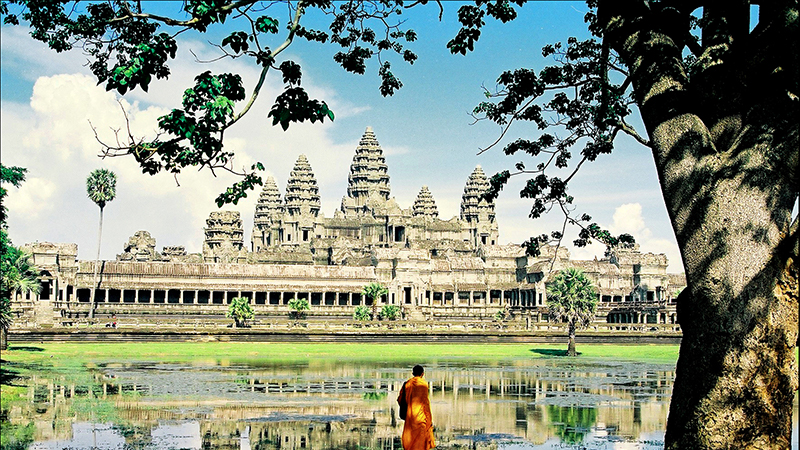
Book Angkor Wat Tours Book Cambodia Hotels Book Bus Ticket in Cambodia
Angkor Wat, the largest monument of the Angkor group and the best preserved, is an architectural masterpiece. Its perfection in composition, balance, proportions, relief's and sculpture make it one of the finest monuments in the world.
Wat is the Khmer name for temple (the French spelling is "vat "), which was probably added to "Angkor "when it became a Theravada Buddhist monument, most likely in the sixteenth century. After 1432 when the capital moved to Phnom Penh, Angkor Wat was cared for by Buddhist monks.
It is generally accepted that Angkor Wat was a funerary temple for King Suryavarman II and oriented to the west to conform to the symbolism between the setting sun and death. The bas-reliefs, designed for viewing from left to right in the order of Hindu funereal ritual, support this function.
ARCHITECTURAL PLAN
The plan of Angkor Wat is difficult to grasp when walking through the monument because of the vastness. Its complexity and beauty both attract and distract one's attention. From a distance Angkor Wat appears to be a colossal mass of stone on one level with a long causeway leading to the center but close up it is a series of elevated towers, covered galleries, chambers, porches and courtyards on different levels linked by stairways.
The height of Angkor Wat from the ground to the top of the central tower is greater than it might appear: 213 meters (699 feet), achieved with three rectangular or square levels (1-3) Each one is progressively smaller and higher than the one below starting from the outer limits of the temple.
Covered galleries with columns define the boundaries of the first and second levels. The third level supports five towers –four in the corners and one in the middle and these is the most prominent architectural feature of Angkor Wat. This arrangement is sometimes called a quincunx. Graduated tiers, one rising above the other, give the towers a conical shape and, near the top, rows of lotuses taper to a point.
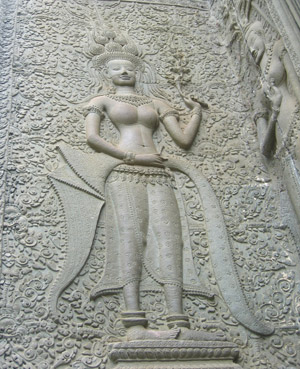
The overall profile imitates a lotus bud, Several architectural lines stand out in the profile of the monument. The eye is drawn left and right to the horizontal aspect of the levels and upward to the soaring height of the towers. The ingenious plan of Angkor Wat only allows a view of all five towers from certain angles. They are not visible, for example, from the entrance. Many of the structures and courtyards are in the shape of a cross. The. Visitor should study the plan on page 86 and become familiar with this dominant layout. A curved sloping roof on galleries, chambers and aisles is a hallmark of Angkor Wat. From a distance it looks like a series of long narrow ridges but close up from identifies itself. It is a roof made of gracefully arched stone rectangles placed end to end. Each row of tiles is capped with an end tile at right angles the ridge of the roof.
The scheme culminates in decorated tympanums with elaborate frames. Steps provide access to the various levels. Helen Churchill Candee, who visited Angkor in the 1920s, thought their usefulness surpassed their architectural purpose.
The steps to Angkor Wat are made to force a halt at beauteous obstruction that the mind may be prepared for the atmosphere of sanctity, she wrote In order to become familiar with the composition of Angkor Wat the visitor should learn to recognize the repetitive elements in the architecture. Galleries with columns, towers, curved roofs, tympanums, steps and the cross-shaped plan occur again and again.
It was by combining two or more of these aspects that a sense of height was achieved. This arrangement was used to link one part of the monument to another. Roofs were frequently layered to add height, length or dimension. A smaller replica of the central towers was repeated at the limits of two prominent areas-the galleries and the entry pavilions. The long causeway at the entrance reappears on the other side of the entry pavilion.
Angkor Wat is a miniature replica of the universe in stone and represents an earthly model of the cosmic world. The central tower rises from the center of the monument symbolizing the mythical mountain, Meru, situated at the center of the universe. Its five towers correspond to the peaks of Meru. The outer wall corresponds to the mountains at the edge of the world, and the surrounding moat the oceans beyond.
LAYOUT Even though Angkor Wat is the most photographed Khmer monument, nothing approaches the actual experience of seeing this temple. Frank Vincent grasped this sensation over 100 years ago.
The general appearance of the wonder of the temple is beautiful and romantic as well as impressive and grand it must be seen to be understood and appreciated. One can never look upon the ensemble of the vat without a thrill, a pause, a feeling of being caught up onto the heavens. Perhaps it is the most impressive sight in the world of edifices.
Angkor Wat occupies a rectangular area of about 208 hectares (500 acres) defined by a laetrile wall. The first evidence of the site is a moat with a long sandstone causeway (length 250 meters, 820 feet; width 12 meters, 39 feet) crossing it and serving as the main access to the monument. The moat is 200 meters (656 feel) wide with a perimeter of 5.5 kilometers (3.4 miles).
The west entrance begins with steps leading to a raised sandstone terrace in the shape of a cross at the foot of the long causeway. Giant stone lions on each side of the terrace guard the monument. Looking straight ahead, one can see at the end of the causeway the entry gate with three towers of varying heights and with collapsed upper portion. This entry tower hides the full view of the five towers of the central group. A long covered failure with square columns and a curved roof extends along the moat to the left and right of the entry tower. This is the majestic facade of Angkor Wat and a fine example of classical Khmer architecture.
Helen Churchill candee must have been standing on this terrace almost 70 years ago when she wrote Any architect would thrill at the harmony of the fasade, an unbroken stretch of repeated pillars leading from the far angles of the structure to the central opening, which is dominated, by three imposing towers with broken summits. This facade originally had another row of pillars with a roof. Evidence of this remains in a series of round holes set in square based in front of the standing pillars.
Tip Before proceeding along the causeway turns right, go down the steps of the terrace and walk along the path a few meters for a view of all five towers of Angkor Wat. Return to the center of the terrace and walk down the causeway towards the main part of the temple. The left-hand side of the causeway has more original sand stone than the right-hand side, which was restored by the French.
In the 1920 when RJ Casey walked on this causeway he noted it was an oddity of engineering The slabs were cut in irregular shapes, which meant that each had to be chiseled to fit the one adjoining. The effect as seen under the noonday sun...is like that of a long strip of watered silk'10 On the left side just before the midway point in the causeway two large feet are carved in a block of sandstone. They belong to one of the figures at the entrances to Angkor Thom and were brought to Angkor Wat in this century the causeway was repaired with reused stones.
The upper portions of the three sections on this tower-one each at the center and the two ends – have collapsed. The porches on each end of the gallery may have served as passages for elephants, horses and carts as they are on ground level.
When Helen Churchill Candee saw these entrances in the 1920 she remarked that architecture made to fit the passage of elephants is an idea most inspiriting. A figure of a standing Visnu (eight arms) is in the right inside the entry tower. Traces of original color can be seen on the ceiling of the entry tower at the left. Continue westward along a second raised walkway (length 350 meters, 1,148 feet; width 9 meters, 30 feet).
A low balustrade resembling the body of a serpent borders each side. Short columns support the balustrade. Looking west one sees the celebrate view of Angkor Wat that appears on the Cambodian flag. Standing at this point one teels compelled to get to the wondrous group of the five domes, companions of the sky, sisters of the clouds, and determine whether or not one lives in a world of reality or in a fantastic dream. Six pairs of ceremonial stairs with platforms on each side of the walkway lead to the courtyard.
A continuation of the serpent balustrade along the walkway frames the stairs. This arrangement is sometimes called a landing platform. The balustrade terminates with the body of the serpent making a turn at right angles towards the sky and gracefully spreading its nine heads to from the shape of a fan. Two buildings, so-called libraries stand in the courtyard on the left and right, just past the middle of the causeway. These 'jewel-boxes Khmer art 'are perfectly formed.
A large central area, four porches, columns and steps present a symmetrical plan in the shape of a cross. Some of the columns have been replaced with cement copies for support. An original pillar lies on the ground before the library on the left. In front of the libraries are two basins (length 65 meters, 213 feet, width 50 meters, 164 feet) the one on the left is filled with water whereas the other lone is usually dry.
Tip Turn left at the first steps after the library and before the basin and follow the path for about 40 meters (131 feet) to a large tree for a superb view of the five towers of Angkor Wat, particularly at sunrise. The walkway leads to a terrace kin the shape of a cross, known as the Terrace of Honor, Just in front of the principal entry tower of Angkor Wat.
Supporting columns and horizontal carved molding around the base accentuate the form of the terrace. Steps flanked by lions on pedestals are on three sides of the terrace. Ritual dances were performed here and it may have been where the king viewed processions and received foreign dignitaries. R Casey sensed such activity in the 1920s One cannot but feel that only a few hours ago it was palpitating with life. The torches were burning about the altars.
Companies of priests were in the galleries chanting the rituals. Dancing girls were flitting up and down the steps... that was only an hour or two ago, monsieur....it cannot have been more.. From the top of the terrace there is a fine view of the gallery on the first level, known as the Gallery of Bas-reliefs (215 by 187 meters, 705 by 614 feet). The outer side, closest to the visitor, comprises a row of 60 columns whereas the inner side is a solid wall decorated with bas-reliefs.
Tip: At this point the visitor has the choice of continuing straight to the central towers or turning right to see the Gallery of Bas-reliefs (see pages 96-108 for a description of the bas-reliefs). The unit providing a link between the first and second levels is the Cross-shaped Galleries. This unique architectural design consists of two covered galleries with square columns in the shape of a cross and a courtyard divided into four equal parts with paved basins and steps. The method used by the Khmers to form corbel arches is visible in the vaults. Several decorative features in these galleries stand out windows with balusters turned as if they were made of wood, rosettes on the vaults, a frieze of Apsaras under the cornices, and ascetics at the base of the columns.
Tip: Some of the pillars in the galleries of this courtyard have inscriptions written in Sanskrit and Khmer. On either side of the courtyard there are two libraries of similar form but smaller than the ones along the entrance causeway The Gallery of 1,000 Buddha's, on the right, once contained many images dating from the period when Angkor Wat was Backlist. Only a few of these figures remain today. The gallery on the left is the Hall of Echoes, so named because of its unusual acoustics.
Tip: To hear the resonance in the Hall of Echoes walk to the end of the gallery, stand in the left-hand corner with your back to the wall, thump your chest and listen carefully. Those who want to visit the library should leave the door at the end of this gallery. There is a good view of the upper level of Angkor Wat from this library.
Return to the center of the cross-shaped galleries and continue walking toward the central towers. Another set of stairs alerts one to the continuing ascent. The outer wall of the gallery of the second level, closest to the visitor, (100 by 115 meters, 328 by 377 feet), is solid and undecorated, probably to create an environment for meditation by the priests and the king.
The starkness of the exterior of the second level gallery is offset by the decoration of the interior. Over 1,500 Apsaras (celestial dancers) line the walls of the gallery offering endless visual and spiritual enchantment. These graceful and beautiful females delight all visitors. They were crated by the Churning of the Ocean of Milk.
When one first walks into the courtyard the multitude of female figures on the walls and in the niches may seem repetitive but as one moves closer and looks carefully one sees that every one of these celestial nymphs is different, the elaborate coiffures, headdresses and jewellery befit, yet never overpower, these 'ethereal inhabitants of the heavens' Apsaras appear at Angkor Wat for the first time in twos and threes. These groups break with the traditional of decoration kin other part of the temple by standing with arms linked in coquettish postures and always in frontal view except for the feet, which appear in profile.
Pang, a Cambodian poet, in a tribute to the Khmer ideal of female beauty wrote of the Apsaras in the seventeenth century. These millions of gracious figures, filling you with such emotion that the eye is never wearied, the soul is renewed, and the heart sated! They were never carved by the hands of men! They were created by the gods living, lovely, breathing women! Only the king and the high priest were allowed on the upper or third level of Angkor Wat, it lacks the stately covered galleries of the other two but is the base of the five central towers, one of which contains the most sacred image of the temple.
The square base (60 meters, 197 feet long) of the upper level is 13 meters (43 feet) high and raises over 40 meters (131 feet) above the second level. Twelve sets of stairs with 40 steps each one in the center of each side and two at the corners-ascend at a 70-degree angle giving access to this level.
Tip: The stairway to the third level is less steep on the west (center) but those who suffer from vertigo should use the south stairway (center, which has concrete steps and a handrail. the steps on all sides are exceptionally narrow. the visitor should ascend and descend sideways. All the repetitive elements of the architectural composition of Angkor Wat appear on the upper level. The space is divided into a cross-shaped area defined with covered galleries and four paved courts. An entry tower with a porch and columns is at the top of each stairway. Passages supported on both sides with double rows of columns link the entry tower to the central structure. The corners of the upper level are dominated by the four towers. Steps both separate and link the different parts. A narrow covered gallery with a double row of pillars and windows and balusters on the outer side surrounds the third level. The Central sanctuary rises on a tiered base 42 meters (137 feet) above the upper level. The highest of the five towers, it is equal in height to the cathedral of Notre Dame in Paris. This central sanctuary sheltered the sacred image of the temple. It originally had four porches opening to the cardinal directions. The central core was walled up some time after the sacking of Angkor in the middle if the fifteenth century. Nearly 500 years later French archaeologists discovered a vertical shaft 27 meters (89 feet) below the surface in the center of the upper level with a hoard of gold objects at the base. At the summit the layout of Angkor Wat reveals itself at last. The view is a spectacle of beauty befitting the Khmer's architectural genius for creating harmonious proportions.
Tip: Walk all the way around the outer gallery of the upper level to enjoy the view of the surrounding countryside, the causeway in the west and the central group of towers. You have not quite an aerial view the Phnom is not high enough for that ...But you can see enough to realize something of the superb audacity of the architects who dared to embark upon a single plan measuring nearly a mile square. Your point of view is diagonal, across the north-west corner of the moat to the soaring lotus-tip of the central sanctuary, you can trace the perfect balance of every faultless line, Worshipful for its beauty bewildering in its stupendous size, there is no other point from which the Wat appears so inconceivable an undertaking to have been attempted-much less achieved by human brains and hands.
GALLERY OF BAS-RELIEF By their beauty they first attract, by their strangeness they hold attention, Helen Churchill Candee wrote of the bas-reliefs in the 1920 .The Gallery of Bas-reliefs, surrounding the first level of Angkor Wat, contains 1,200 square meters (12,917 square feet) of sandstone carvings. The relief covers most of the inner wall of all four sides of the gallery and extend for two meters (seven feet) from top to bottom.
The detail, quality composition and execution give them an unequalled status in world art. Columns along the outer wall of the gallery create an intriguing interplay of light and shadow on the relief. The effect is one of textured wallpaper that looks like the work of painters rather than sculptors' The bas-reliefs are of dazzling rich decoration-always kept in check, never allowed to run unbridled over wall and ceiling possess strength and repose, imagination and power of fantasy, wherever one looks [the] main effect is one of "supreme dignity "wrote a visitor 50 years ago.
The bas-reliefs are divided into eight sections, two on each wall of the square gallery each section depicts a specific theme. In addition the two pavilions at the corners of the west Gallery have a variety of scenes. The book does not include description of badly damaged relief.
Some others are unidentifiable .The composition of the relief can be divided into two types scenes without any attempt to contain or separate the contents and scenes contain or separate the contents; and scenes contained in panels which are some-times superimposed on one another-this type is probably later. The panels run horizontally along the wall and generally consist of two or three parts. Sometimes the borders at the top bottom are also decorated. Themes for the bas-reliefs derive from two main sources-Indian epics and sacred books and warfare of the Angkor Period. Some scholars suggest that the placement of a relief has a relevance to its theme. The relief on the east and west walls, for example, depict themes related to the rising and setting sun. The word bas means low or shallow and refers to the degree of projection of the relief. The method of creating relief at Angkor Wat was generally to carve away the background leaving the design in relief. Sometime, though the method was reversed giving a sunken appearance. of some of the relief have a polished appearance on the surface.
There are two theories as to why this occurred. The position of the sheen and its occurrence in important parts of the relief suggest it may have resulted from visitors rubbing their hands over them. Some art historians, though think it was the result of lacquer applied over the relief. Traces of gilt and paint, particularly black and red, can also be found on some of the relief's. They are probably the remains of an undercoat or a fixative. Several primitive artistic conventions are seen in the bas-reliefs. A river is represented by two parallel vertical lines with fish swimming between them. As in Egyptian art, a person's rank is indicated by size. The higher the rank the larger the size. In battle scenes, broken shafts on the ceremonial umbrellas of a chief signify defeat. Perspective is shown by planes placed one above the other. The higher up the wall, the further away is the scene. Figures with legs far apart and knees flexed are in a flying posture.
INVITING THE GALLERY OF BAS-RELIEFS Those who like to linger in this wonderful gallery of bas-reliefs will always be made happy by new discoveries will return as other joys of Angkor will allow.
Tip: As the bas-reliefs at Angkor Wat were designed for viewing from to lefts the visitor should, follow this convention for maximum appreciation. Enter at the west entrance, turn right into the gallery and continue walking counterclockwise. If you start from another point always keep the monument on your left. If one's time at Angkor is limited, the following bas-recommended.
LOCATION THEME
Description of the bas-reliefs in this guidebook follows the normal route for viewing Angkor Wat. They begin in the middle of the West Gallery and continue counter clockwise. The other half of the West Gallery is at the end of the section. Identifying characteristics are in parenthesis and the locations of scenes on the bas-reliefs are in bold type.
WEST GALLERY - BATTLE OF KURUKSHETRA
This battle scene is the main subject of the Hindu epic Mahabharata. It recalls the historic was wars in Kurukshetra, a province in India, and depicts the last battle between rival enemies who are cousins (see page 54 for a description of this legend). The armies of the Kauravas and the Pandavas march from opposite ends towards the center of the panel where they meet in combat. Headpieces differentiate the warriors of the two armies. The scene begins with infantry marching into battle and musicians playing a rhythmic cadence. The battlefield is the scene of hand-to-hand combat and many dead soldiers.
Chief officers and generals (represented on a larger scale) oversee the battle in chariots and on elephants and horses. The scene builds up gradually and climaxes in a melée. Bisma (near the beginning of the pane), one of the heroes of the Mahabharata and commander of the Kauravas, pierced with arrow, is dying and his men surround him. Arjuna (holding a shield decorated with the face of the demon rahu) shoots an arrow at Krsna, his half-brother, and kills him. After death, Krisna (four arms) becomes the charioteer of Arjuna.
Corner pavilion (southwest)
Enter the pavilion and view the scenes facing you. Then continue clockwise around the pavilion. The bas-reliefs in this pavilion depict scenes from epic the Ramayana.
A- Left, Water festival; two ships (superimposed) with Apsaras, chess players (top ship) B- Center, above the door: A god receiving offerings.
C- Left, top to bottom. A fight between Vali and Sugriva, the monkey king; Rama shoots Vali with an arrow who lies in the arms of his wife (three pointed headdress); monkeys mourn his death D- Center, above the door: Murder of a demon; Krsna extinguishes a fire west. E- Left: Siva sits with his wife Paravati on Mount Kailasa F- Center, above the door: Krisna uproots trees with a stone he is tied to. G- Right: Ravana, disguised as a chameleon, presents himself at the palace of Indra.
H- Left: The Churning of the Ocean of Milk. I - Center, above the door: Rama kills Marica, who, disguised as a golden stag, helped in the abduction of Sita. J- Right: Krisna lifts Mount Govardhana to shelter their shepherds and their herds from the storm ignited by the anger of Indra.
SOUTH (HISTORICAL) GALLERY - ARMY OF KING SORYAVAMAN II This gallery depicts a splendid triumphal procession from a battle between the Khmers and their enemies. The relief's show methods used in warfare, mainly hand-to-hand combat, as they no machinery and no knowledge of firearms.
The naturalistic depiction of trees and animals in the background of this panel is unusual. The central figure of this gallery is King Suryavarman II, the builder of Angkor Wat, who appears twice. An inscription on the panel identifies him by his posthumous name, suggesting it may have been done after his death. The rectangular holes randomly cut n this gallery may have contained precious objects of the temple. On the upper tier the king (seated with traces of gilt on his body) holds an audience on a mountain. Below of the place walk down a mountain in the forest.
The army gathers for inspection and the commander mounted on elephants join their troops who are marching towards the enemy. The commander's rank is identified by a small inscription near the figure. King Suryavarman II stands on an elephant (conical headdress, sword with the blade across his shoulder) and servants around him hold 15 ceremonial umbrellas. Visnu stands on a Garuda on a Garuda on a flagpole in front of the king's elephant. The lively and loud procession of the Sacred Fire (carried in an ark) follows with standard bearers, musicians and jesters. Brahmans chant to the accompaniment of cymbals. The royal sacrifice in a palanquin.
Towards the end of the panel: The military procession resumes with a troop of Thai soldiers (pleated skirts with floral pattern; belts with long pendants; plaited hair; headdresses with plumes; short moustaches) led by their commander who is mounted on an elephant. The Thai troops were probably either mercenaries of a contingent from the province of Louvo (today called Lopburi) conscripted to the Khmer army. A number of the Khmer warriors wear helmets with horns of animal heads (deer, horse, bird) and some of their shields are embellished with monsters for the same purpose.
JUDGMENT BY YAMA; HEAVEN AND HELL Three tiers recount the judgment of mankind by Yama and two tiers depict Heaven and Hell. Inscriptions have identified 37 heavens where one sees leisurely pursuits in palaces and 32 hells with scenes of punishment and suffering. Draperies and Apsaras separate the two and a row of Garudas borders the tier in the bottom. The roof was destroyed by lightning in 1947 and subsequently the ceiling of this gallery was restored by the French. Traces of gilt can be on riders on horses at the beginning of the panel. The lower section of the panel was badly damaged and liter filled with cement.
Lower tier: Yama, the Supreme Judge (multiple arms, wields a staff and rides a buffalo), points out to his scribes the upper road representing heaven and the lower one of hell. Departed spirits a wait judgment. Assistants to Yama shove the wicked through a trap door to the lower regions where torturers deliver punishments such as sawing a body in half for those who overeat. Lawbreakers have their bones broken. Some of the punished wear iron shackles or have nails pierced through their heads. Upper tier: A celestial palace is supported by a frieze of Garudas with Apsaras in the skies.
EAST GALLERY - CHURNING OF THE OCEAN OF MILK This is the most famous panel of bas-reliefs at Angkor Wat and derives from the Indian epic Bagavata-Pourana. The Ocean of Milk is churned by gods and demons to generate Amrta, the elixir of life. the purpose of the churning is to recover lost treasures such as the sourer of immortality, Laksmi the goddess of good fortune, the milk white elephant of Indra, and the nymph of loveliness. The retrieval of these objects symbolizes prosperity. It takes place during the second ascent of Visnu, when he is incarnated as a tortoise.
The scene is decided into three tiers. The lower tier comprises various aquatic animals, real and mythical, and is bordered by a serpent. The middle tier has, on one side, a row of 92 demons (round bulging eyes, crested helmets) and, on the other side, a row of 88 gods (almond-shaped eyes, conical headdresses). They work together by holding and churning the serpent. Hanuman, the monkey god, assists. Visnu, in his reincarnation as a tortoise, offers the back of his shell as a base for the mountain Mandara, and as a pivot for the churning. He sits on the bottom of the Ocean. A huge cord in the form of the body of the serpent Vasuki acts as a stirring instrument to churn the sea.
To begin the motion the gods and demons twist the serpent's body; the demons hold the head and the gods hold the tail of the serpent. Then by pulling it rhythmically back and for th they cause the pivot to rotate and churn the water.
The gods and demons are directed by three persons (identified by their larger size). Indra is on top of Visnu. On the extreme right Hanuman, ally of the gods, tickles the serpent. Upper tier: During the churning various female spirits emerge. Visnu appears in this scene again in yet another reincarnation-as a human being-to preside over the "churning "which, according to legend, lasted more than 1,000 years.
Numerous other beings are depicted such as the three-headed elephant mount of Indra, Apsaras and Laksmmi, the goddess of beauty. They churning provoke the serpent to vomit the mortal venom, which covers the waves. Afraid the venom may destroy the gods and demons, Brahma intervenes and requests Siva to devour and drink the venom, which will leave an indelible trace on Siva's throat. He complies and, as a result, he Amtrak pours forth. The demon rush to capture all the liquid. Visnu hurries to the rescue and assumes yet another reincarnation in the form of Maya, a bewitching beauty, and is able to restore much of the coveted liquid.
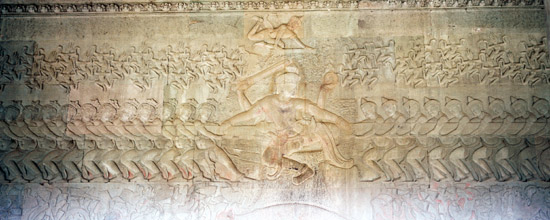
INSCRIPTION Just past the middle of the East Gallery there is an interesting inscription of the early eighteenth century when Angkor Wat was a Buddhist monastery. It tells of a provincial governor who built a small tomb where he deposited the bones of his wife and children. The structure is in poor condition but recognizable in its original location, directly in front of the inscription in the gallery.
VICTORY OF VISNU OVER THE DEMONS The bas-reliefs in this section of the Wast Gallery and the south part of the North Gallery were probably completed at a later date, perhaps the fifteenth or sixteenth century. The stiffness of the figures and the cursory workmanship reveal this change. An army of demons marches towards the center of the panel. Center: Visnu (four arms) sits on the shoulders of a Garuda.
A scene of carnage follows. Visnu slaughters the enemies on both sides and disperses the bodies. The leaders of the demons (mounted on animals or riding or riding in chariots drawn by monsters) are surrounded by marching soldiers. Another group of warriors (bows and arrows) with their chiefs (in chariest of mounted on huge peacocks) follows.
NORTH GALLERY VICTORY OF KRISNA OVER BANA THE DEMON KING At the beginning of the panel Visnu in his incarnation as Krsna (framed by two heroes) sits on the shoulders of a Gruda. Agni, the god of Fire (multiple arms), sits on a rhinoceros behind him. This scene appears several times. A wall surrounding the city is on fire and prevents the advance of Krsna (mounted of a Garuda) and his army of gods. This Krsna scene also appears several times in the panel. The Garuda extinguishes the fire with water from the sacred river Ganges. The demon Bana (multiple arms, mounted on a rhinoceros) approaches from the opposite direction. Extreme right: Krsna (1,000 heads, hands across his chest) kneels in front of Siva who sits enthroned on Mount Kailasa with his wife Parvati and their son ganesa (head of an elephant) as they demand that Siva spare the life of Bana.
BATTLE BETWEEN THE GODS AND THE DEMONS A procession of 21 gods of the Brahmanic pantheon march in procession carrying classic attributes and riding traditional mounts. One-god battles against a demon while warriors on both sides battle in the background. A series of adversaries follow, the Kubera, God of riches (with bow and arrow), Appears on the shoulders of a Yaksa; followed by Skanda, Goe of war (multiple heads and arms), mounded on a peacock; Indra stands on his mount the elephant; Visnu (four arms) sits on his mount, a Guard; a demon (tiered heads) shaking swords; Yama, God of Death and. Justice (sword and shield), stands in a chariot pulled by horses; and Varian, God of the Water, stands on a five-headed serpent harnessed like a beast of burden.
CORNER PAVILION (NORTHWEST) Enter the pavilion and walk counter-clockwise. Several of the scenes are in good condition.
NORTH A- Right: The women's quarters of a palace. B- Center, above the door: An attempt to abduct site in the forest. C- Left, badly damaged: A scene from the Ramayana. Above: Tiers of monkeys and a pyre
WEST D- Right: rama in his chariot (drawn by geese) returns victorious to Ayodhya E- Center, above the door: Rama and Laksmana surrounded by monkeys. F- Left: A conversation between Sita and Hanuman in the forest; Hanuman gives Rama’s ring to Sota.
SOUTH G- Right Visni (seated, four arms) surrounded by Apsaras. H- Center, above the door: Rama and Laksmana battle a monster (headless, face on stomach) I- Left: Rama wins an archery competition; Rama and Sita sitting together.
EAST J- Right: Visnu (four arms) on a Garuda; Krsna (mounted on a Garuda) bring back Mount Maniparvata which he took from a demon he killed; his army carries the remains of the demon. K- Center, above the door: Discussions on an alliance. Left: Rama and his brother Laksmana. Right: Suryva, the monkey king L- Left: Visnu reclines on the serpent Anent. Below: A group of nine gods with their mounts (1) Surya in a chariot pulled by horses (2) Kubera standing on the shoulders of a Yaksa (3) Brahma riding a goose (4) Skanda on a peacock (5) An unidentified god on a horse (6) Indra on a three-headed elephant (7) Yama riding a buffalo (8)Siva on a bull (9) An unidentified god on a lion
WEST GALLERY - BATTLE OF LANKA This scene from the Ramayana is a long and fierce struggle between Rama and the demon king Ravana (10 heads and 20 arms), near the center. It is among the finest of the bas-reliefs at Angkor Wat. The battle takes place in Lanka (Sri Lanka) and ends with the defeat of Ravana, captor of Sita, the beautiful wife of Rama. The central figures are the monkey warriors who fight against the raksasas on Rama's side.
The brutality of war is juxtaposed with a graceful rendition of lithesome monkeys. Past the center: Rama stands on the shoulders of Sugriva surrounded by arrows; Laksmana, his brother, and an old demon, stand by Rama. Nearby, the demon king Ravana (10 heads and 20 arms) rides in a chariot drawn by mythical lions.
Further on, Nala, the monkey who built Rama's bridge to Lanka, is between them leaning on the heads of two lions. He throws the body of one he has just beaten over his shoulder. A monkey prince tears out the tusk of an elephant, which is capped with a three-pointed headdress and throws him and the demon to the ground.
Related Articles...

More Articles on What To See
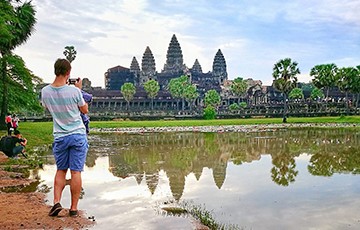
Recommended Cambodia Tours

Cambodia Day Tours

Angkor Temple Tours

Cambodia Classic Tours

Promotion Tours

Adventure Tours

Cycling Tours
Trip planner.
- Essential Information
- General Infomation
- Food & Drink
- Events in cambodia
- Travel Maps
- Accommodations
- Flight Details
- Transportation
- Tour Packages
- Travel Guides
Useful Links
- Cambodia Visa
- Useful Contacts
- Tourist Information
- Phnom Penh Postal Code
- Advertise with us
Travel Services
- Cambodia Tours
- Cambodia Flights
- Cambodia Hotels
- Boat/Cruise Ticket
Travel News & Media
- Cambodia Travel News
- Cambodia Events
- Download & Media
- Photo Gallery
Agency offering information about Cambodia on tourism, culture, history, visa, attractions, province guides, trip planner, hotels, flights, cars, tours, news, photo and online bookings.
- Copyright © 1999-2024 Tourism of Cambodia. |
- Privacy Policy |
- Terms of Service |
APRIL SALE: Book now and get up to 60% off!
Angkor Wat Tours & Trips
Find the right tour for you through Angkor Wat. We've got 551 adventures going to Angkor Wat, starting from just one day in length, and the longest tour is 104 days. The most popular month to go is October, which has the largest number of tour departures.
250+ Angkor Wat tour packages with 2,650 reviews

- In-depth Cultural
- Christmas & New Year
Ancient Angkor Wat Independent Adventure
Cheak is a very good guide, he tells us the history of the Angkor Wat and took good care of us. We really enjoyed our time with him in Cambodia.

Private Angkor Wat 2 Days Tour for All Highlight Angkor Temples

6 Days Cambodia Highlights
Top tour............

Angkor Adventure & Beyond
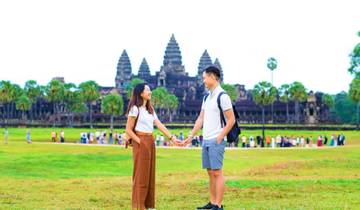
Private Angkor Wat Sunrise with All Angkor Highlight Temples 2 Days Tour
We had 6 days tour to see all highlights of Angkor temples and it was amazing to cover all important sites in and around Siem reap. Our guide Sara was excellent knowledge, friendly and helpful. We had nice hotel and large room, foods were delicious. Overall the services were excellent and great experience.
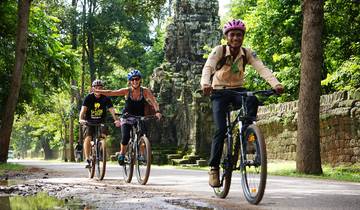
5 Days - Angkor Family Bicycle Tour
We had an awesome bike tour around Angkor Wat temples with Lot as our guide. Our bikes were extremely comfortable, the views were breathtaking, and the ride was amazing! I really appreciated the opportunity to see the cultural and historical aspects of Cambodian life that were brought up on this visit. It will be a great way to start our family holiday in Cambodia. Thanks for a great tour!!!
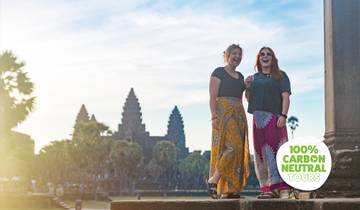
Cambodia Intro
The tour was amazing! Learned and experienced some incredible things. The tour leader, Becca, was super friendly and helpful and became more of a friend than a leader. She spent time with everyone and we always had a laugh. I hope you never change Becca!
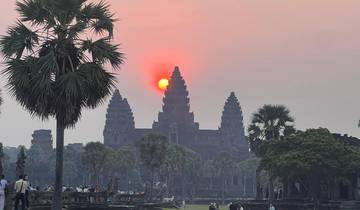
Private Siem Reap 3 Day Tour to Discover All Highlight Angkor Temples
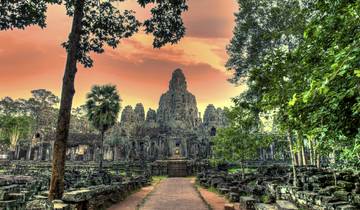
Best of Angkor 4-Day Tour
Excellent Service right from the Start of booking to the Finnish of the Tour; This was an amazing Holiday the Tour Guides and Drivers where brilliant.
- 10% deposit on some dates Some departure dates offer you the chance to book this tour with a lower deposit.
- Book With Flexibility This operator allows you to rebook your dates or tours with them for free, waiving change fees.
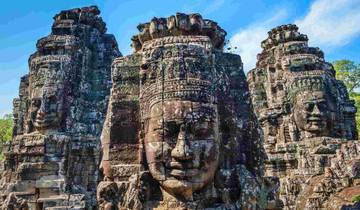
HIGHLIGHTS OF VIETNAM AND CAMBODIA - Hanoi City / Halong Bay / Siem Reap/Angkor
First time to visit Vietnam n Cambodia. We found that there's still lot of things, activities, tours...that we 've not joined. We will continue maybe next time. The tour company is great, good services from pick up / drop off. Definitely support and comback soon

- Sightseeing
Temple Small circuit & Tonle Sap Lake Joining Tour
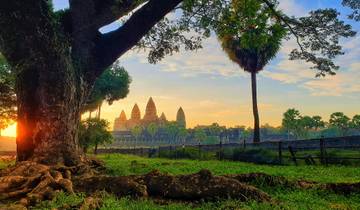
Private Siem Reap 2 Days Tour for Angkor Temples and Floating Village at Tonle Sap Lake
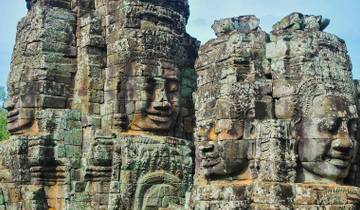
3 DAYS SIEM REAP PACKAGE (PRE or POST MEKONG RIVER CRUISE)
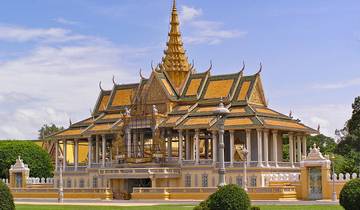
Classic Cambodia
The trip surpassed my expectations. The day trips were amazing, and our guide was the best guide I've ever had. The only thing I was not pleased with was one of our 2 hotels. They were undergoing renovations so it was extremely loud and dusty.
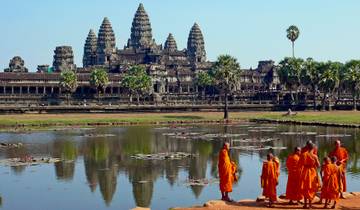
3-Days Angkor Temples - Cambodia
What people love about angkor wat tours.
Polite people, well organized and magnificent archeological sites
- to Asia (2)
- Cambodia Travel Guide | All You Need to Know

A Cambodian adventure to Angkor Wat and Siem Reap
Explore the historical and colourful sights of cambodia’s second-largest city.
A s the gateway to Angkor Wat, Siem Reap might seem like a place you pass through on your way to something more interesting nearby.
- SEE MORE Cambodia: from tenth-century temples to mid-century modern
But this unsuspecting city is the second largest in Cambodia and people have lived here for around 1,200 years. For those travellers willing to spend an extra few days enjoying the surrounding area, there is so much to offer.
A ‘magical experience’ at Angkor Wat
Ok, you can’t go to Siem Reap without visiting the 900-year-old temple that made the town famous, so let’s get that one out of the way first. There are very few things that can make me wake up at 3am, a flight being the main one, but by far the best reason I ever had to set my alarm at that ungodly hour is to watch the sunrise at Angkor Wat.
Taking a guide isn’t necessary, but they do know exactly where to find the best views. We arrived in complete darkness and were told to sit on a wall. The lake below us was only visible when a fish broke the surface, creating ripples that reflected in the moonlight, but soon the sky began its journey from deep purple to the warmest pink and the temple’s ancient towers came into view. Watching a fiery sun rise above this site is a magical experience I will remember for the rest of my life.
Our guide Dalign spent the next four hours showing us around three of the most famous temples, highlighting some of the most interesting bits of history and architecture. Between nuggets of information about Angkor’s history were stories of his own experience growing up locally in the shadow of the Cambodian civil war and the Khmer Rouge. You can book Angkor Wat tours with Journey Cambodia through Get Your Guide .
Panoramic Images/Alamy Stock Photo
Things to see and do in Siem Reap
Some people travel here just to see Angkor Wat and don’t enjoy the town. That would be a mistake. There’s so much to see and do in Siem Reap. To get around, take a rickshaw tour of the town for approximately $20 for half a day. This will be the best way to travel when it gets hot – and it gets really, really hot.
If you are interested in all things military, or in the history of the Cambodian civil war, then head to the War Museum . On display you’ll find tanks, weapons, grenades, and many other items left behind after the fighting stopped. Unlike other more polished museums, these items are available to touch, hold and really get to grips with, giving a very personal insight into the atrocities that occurred here.
Simon Rinderer/Alamy Stock Photo
The Angkor National Museum will give you an even deeper understanding of the Angkor Wat temple complex, and it is dedicated to preserving the archaeology of the area, as well as sharing the complex history of the Khmer civilisation that built and lived in it. One of the newest attractions is the Angkor Eye, a 278ft-tall ferris wheel that has panoramic views over the town towards the temples of Angkor.
You also really must spend one evening of your visit at Phare Circus , an extraordinary celebration of Cambodian culture and dance. It was founded in 1994 by nine young men returning from a refugee camp who wanted to help poor young people. The school now has 1,200 students daily, some of whom end up performing at the circus. The energy and talent on stage is incredible, and the audience of all ages were completely engrossed in a story that told of the importance of the rice fields through song and dance. The site has food and performances before the show as well as a shop selling locally made goods.
Peter Erik Forsberg/Alamy Stock Photo
Where to shop
It is very easy to shop in Cambodia , and there are just so many interesting markets and outlets to explore. The Made in Cambodia market is small but stuffed full of gems that you will want to reserve space for in your suitcase, from craft alcohol to home-made jewellery.
Both the Angkor Night Market and the Old Market are open late and situated right in the centre of the city, and you can find pretty much everything in either. Siem Reap is also home to dozens of interesting boutique stores, from the Australian-owned Wild Poppy, to Manava, which sells chic homewares made by Cambodian women.
Artisans Angkor is a museum, craft studio and shop that gives job opportunities to local people. Helping to revive traditional craftsmanship, we saw how they made glorious silk fabrics, as well as intricate wooden carvings and stonework.
Where to stay
Designed by American architect Bill Bensley, Shinta Mani Angkor and Bensley Collection Pool Villas are located in the leafy French Quarter of Siem Reap near the Royal Gardens, just a 10-minute walk from the city centre.
The resort, which is split into two hotels, prides itself on genuine, personalised service that is high-quality but refreshingly informal. Guests in the pool villas have a private Bensley butler, and the Shinta Mani Spa by Khmer Tonics offers an extensive menu of therapeutic treatments based on traditional and modern healing rituals, using natural, locally sourced products.
The selling point really is the modern and fun interior design, with a monochrome colour scheme and quirky art adorning the walls and halls. Our room was large, with a comfortable king-size bed and sustainable, refillable toiletries. On the ceiling above the bed was a dimly lit picture of Angkor Wat, which was surprisingly nice to look at as I fell asleep.
There are two pools: one is chic and minimalist in a courtyard adorned with greenery and plants, while the other is large and catches the sun all day long. Both have bars serving delicious cocktails to your lounger.
The hotel supports the Shinta Mani Foundation, which helps with education and development of young adults living in the area, and a percentage of every room rate is donated to this.
Where to eat?
Eating in the hotel might feel like a cop out, but not when the restaurant is as special as this. Kroya by Chef Chanrith is a unique dining experience inspired by the area’s rich heritage. We were treated to six courses of elevated Cambodian cuisine. The chef uses local ingredients and knowledge to create a modern menu inspired by the dishes of his youth, and the result is fragrant, exciting, and delicious. A particular highlight was the Tonlé Sap Lake butter-catfish soup and the sautéed Koh Kong scallops with chilli minced pork. We sat on a swing table over a pond full of koi as tuk-tuks and scooters whizzed past, and our waiter Yaya helped make the experience extra enjoyable.
For more traditional local food try Sambo Khmer restaurant, where the Lok Lak, a spicy beef dish, is a particular speciality. Other must-tries are the amok – steamed, curried fish in a banana leaf parcel – and spring rolls.
You can also keep the budget really low by eating at one of the food trucks that park up by the river each evening. Tables and chairs are available for you to eat your street food in comfort, and you will be surrounded by local people enjoying their dinner.
imageBROKER/Alamy Stock Photo
Where to drink?
If partying is your aim then Pub Street has to be your destination. The name was originally thought up by backpackers back in the late 2000s, but it is officially called Street 8. Now it is the centre of nightlife in Siem Reap. Crowds throng along a jumping street full of bars, clubs and, peculiarly, fish pedicure places that offer you a beer as you dangle your feet in tanks of water. It is definitely worth seeing.
If you prefer your evening entertainment to be a little on the lighter side then head down to the river, where bars and restaurants line either side. Sip a cocktail as you enjoy the sunset from one of the many rooftops.
How to get there
Currently, there are no airlines that fly direct from London to Siem Reap, but you can fly via most of the major cities in the region on carriers such as Vietnam Airlines, Singapore Airlines, and Thai Airways.
Jaymi McCann was a guest of Shinta Mani Angkor and Bensley Collection Pool Villas. Rates start from $150 for the Bayon Wing, $165 for Shinta Mani Angkor and $615 for the Bensley Collection Pool Villas. All rates include breakfast and are subject to applicable service charge and government taxes as well as seasonality. Junction of Oum Khun & 14th Street, Siem Reap, Cambodia; shintamani.com
Sign up for the Travel newsletter for destination inspiration and the latest news and trends
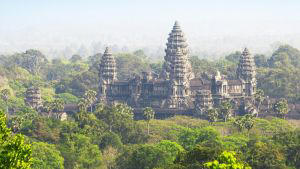
- Hospitality Industry
Angkor Wat: The Impacts of Mass Tourism
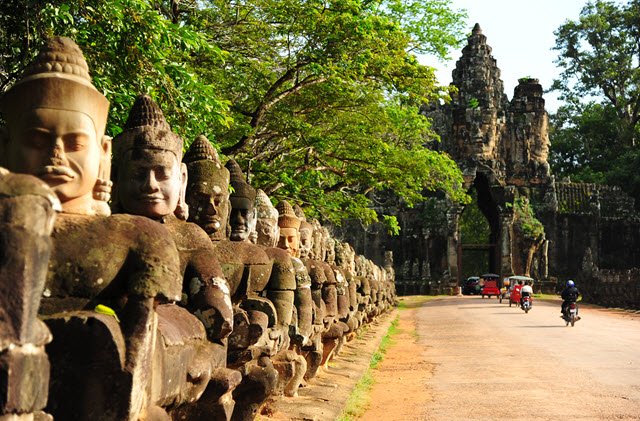
October 18, 2019 •
6 min reading
Overtourism is now a term that is frequently used to describe the negative impacts of excessive tourism on a destination. The impacts of overtourism are numerous and even if the term is quite new, we can find traces of this concept already among scholars in the beginning of mass tourism . Plog, for example, related the evolution of the number of tourists in a destination to the type of tourists visiting that same destination.
Tourists are divided into 3 categories:
- Allocentric tourists with a preference for non-touristy areas and novel destinations
- Midcentric tourists , being less adventurous and preferring quasi mainstream attractions
- Psychocentric tourists , seeking familiarity and preferring tour packages.
What the figure below below illustrates is that the more touristic the destination is, the more psychocentric the tourists are. This modification in tourists’ segments has a direct impact on the destination.
Typically, psychocentric travelers can cause cultural change, because of their demand for standardized infrastructures and services, economic leakage because of their use of services provided by foreigners (e.g. tour packages) and loss of clients, because allocentric and mid-centric tourists will leave for other destinations.
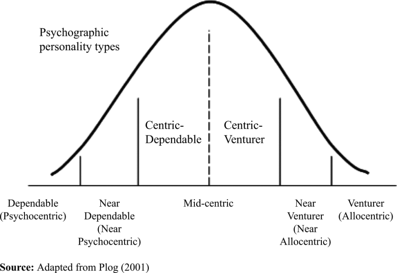
Figure 1: Plog’s tourist model of destination preferences
Cambodia, and more specifically, Angkor Wat’s nearby city Siem Reap, is a great example of this phenomenon.
- In 1992, the archaeological site of Angkor is added to the UNESCO World Heritage list. With the political stabilization in the country, tourism explodes.
- While only 118,183 international tourists visited the country in 1993, Cambodia hosted 6,201,077 visitors in 2018 .
- To host the booming tourism, an airport is built in Siem Reap in 2006.
- In 2017, Angkor Wat is chosen as the World’s Top Tourism Landmark by TripAdvisor .
- In 2018, 2,590,815 foreign visitors arrived in Siem Reap, representing 38.3% of the country’s international tourism.
Tourism growth has impacted tourism segments throughout the years.
In the early 2000s, the main visitors to Cambodia were westerners (USA, France, UK). Now China, Vietnam, Laos, Thailand and Korea account for 67.1% of the tourism industry, with 32.6% for the Chinese market, which represents an increase of 67.2% between 2017 and 2018.
In 2011, Chheang studied tourists’ motivations to visit Angkor Wat. The study showed that the main interests to visit the region were learning new things, local culture and history and experience the local atmosphere. These interests, which could be attributed to allocentric travelers, were stronger among non-Asian tourists than among Asian tourists. The increase of Asian tourists in Angkor Wat could lead to the replacement of allocentric travelers by psychocentric travelers.
Cambodia and Angkor Wat are becoming increasingly attractive to Chinese tourists.
Cambodia’s Deputy Prime Minister declared wanting to target 20 million Chinese tourists in 2020 and he uses all the necessary means to achieve his objective.
There are currently 31 direct flights per week between Siem Reap and China, Chinese investments are encouraged by the government (e.g. a Chinese company obtained a concession to build a new airport near the Angkor Wat area, the construction is expected to be completed by 2022) and the government created an accreditation for “Chinese-friendly” tour operators, based on the criteria of the Ministry of Tourism’s China Ready Center.
But what are the impacts of these modifications of tourism segments?
First, Chinese tourists tend to frequent Chinese-owned businesses and usually book organized tours with them. These preferences, typical of psychocentric travelers, increase the economic leakage, already very high in Cambodia.
In 2008, although only 15% of the touristic infrastructure in Siem Reap was owned by foreigners, 28.3% of the benefits left the country. Moreover, Chinese tourists usually spend only a few days in the destination, therefore, they spend little. In 2018, the average length of stay was seven days, one day less than in 1995. Chinese tourists, and more generally, the Asian tourism market is booming, replacing slowly the decreasing old markets, like westerners.
On the other hand, with the great relations between Cambodia and China, many Chinese companies are investing in the development of the country, creating jobs, building bridges, roads and solar power plants. Moreover, Chinese tourists are also interested in nature, this is the second main attraction for them in Cambodia, after culture. To meet their demand for nature, the Cambodian government promotes and develops eco-tourism. For example, Kulen Revealed, has provided, since 2018, community-based ecotours in Kulen Mountain, near Siem Reap.
A Chinese-dominated tourism economy generates diverse impacts in a destination such as Siem Reap.
The tourism strategy needs to be managed carefully, focusing on the right segments to avoid irreversible impacts. In Thailand, Chinese tourists are also a major segment, representing 8.7 million visitors in 2016. The government had to take measures, like banning cheap tours bringing no benefits to the country or discouraging big tour groups.
These measures, combined with cultural differences between the level of education between tourists and the local population, can limit the conflicts and avoid tourism rejection seen elsewhere (e.g., Venice, Barcelona, etc.). Moreover, the new Chinese generation differs from its predecessors. They are mostly independent travelers, seeking unique experiences.
With 149.2 million Chinese tourists in the world in 2018, destinations need to understand how they can tap into this growing market, without compromising the interests of other markets.

References:
Aldama, Z. (2017). How Chinese tourists are changing the world. Post Magazine . Retrieved from: https://www.scmp.com/magazines/post-magazine/long-reads/article/2113116/how-chinese-tourists-are-changing-world
CAPA. (2018). Siem Reap new international airport. CAPA . Retrieved from: https://centreforaviation.com/data/profiles/newairports/siem-reap-new-international-airport
Chheang, V. (2011). Angkor heritage tourism and tourist perceptions. Tourismos: an international multidisciplinary journal of tourism, 6 (2), 213-240. Retrieved from: http://www.chios.aegean.gr/tourism/VOLUME_6_No2_art13.pdf
Construction & Property. (2019). Cambodia to see massive infrastructure investment from Chinese firms. Construction & Property . Retrieved from: https://www.construction-property.com/read-news-1612/
Connor, L. (2019). ‘They only go to Chinese shops’: why Cambodia’s influx of mainland tourists is causing tensions. This week in Asia . Retrieved from: https://www.scmp.com/week-asia/society/article/2180257/they-only-go-chinese-shops-why-cambodias-influx-mainland-tourists
Neth, B. (2011). Angkor as World Heritage Site and the Development of Tourism: A Study of Tourist Revenue in the Accommodation Sector in Siem Reap-Angkor. In: World Heritage Angkor and Beyond: Circumstances and Implications of UNESCO Listings in Cambodia (pp.147-176). Retrieved from: http://books.openedition.org/gup/313
Peltier, D. (2018). Independent Chinese travellers close gap with tour groups. Skift . Retrieved from: https://skift.com/2018/10/29/independent-chinese-travelers-close-gap-with-tour-groups/
Plog, S. C. (2001). Why destination areas rise and fall in popularity: An update of a Cornell Quarterly Classic. Cornell Hotel and Restaurant Administration Quarterly, 42 (3), 13-24
Southern, N. P. (2017). Cambodia’s tourism industry: A Kingdom for more tourists. Globe. Retrieved from: https://southeastasiaglobe.com/cambodia-future-tourism/
Sullivan, N. (2015). Siem Reap warned Chinese tourists pose challenge and opportunity. The Phnom Penh Post . Retrieved from: https://www.phnompenhpost.com/siem-reap-insider/siem-reap-warned-chinese-tourist-post-challenge-and-opportunity
Tourism Statistics Department, Ministry of tourism [MOT]. (2006). Cambodia tourist statistical report 2006. Ministry of tourism . Retrieved from: https://www.catacambodia.com/Cambodia%20Tourism%20Statistics%20-%202006.pdf
Tourism Statistics Department, Ministry of tourism [MOT]. (2018). Tourism Statistics Report - Year 2018. Ministry of tourism . Retrieved from: https://amchamcambodia.net/wp-content/uploads/2019/04/Year_2018.pdf
Vannak, C. & Manet, S. (2016). Cambodia-China tourism pact. Khmer Times . Retrieved from: https://www.khmertimeskh.com/7913/cambodia-china-tourism-pact/
Xinhua (2019). Chinese tourists make nearly 150 mln outbound trips in 2018. China Daily . Retrieved from: http://www.chinadaily.com.cn/a/201902/14/WS5c64e2fca3106c65c34e9528.html

Assistant professor at EHL Hospitality Business School
Keep reading
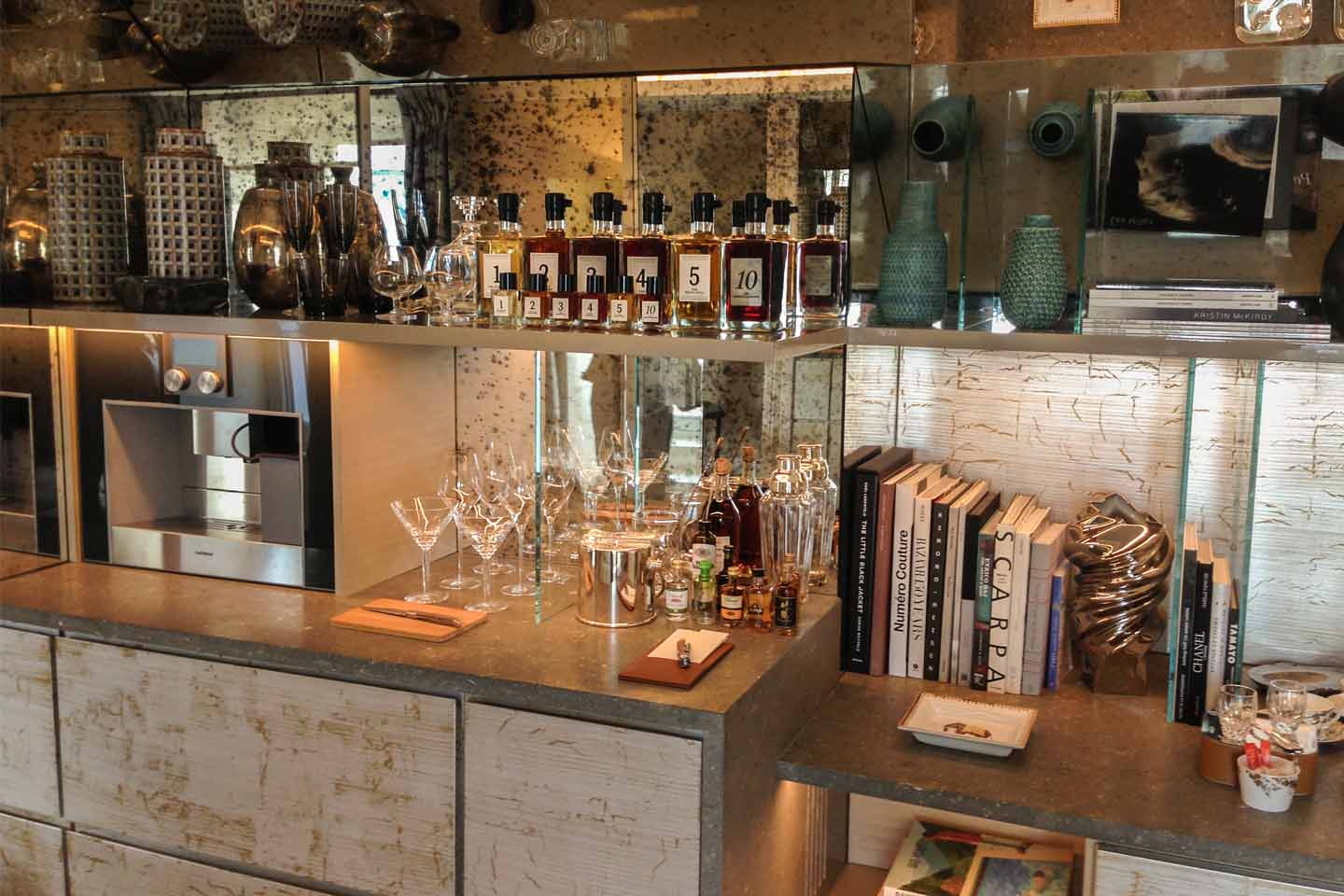
Luxury hotels and a ‘sense of place’: Brand identity and experiences
Apr 24, 2024

Luxury hotels and a ‘sense of place’: The branding imperative
Apr 17, 2024

Navigating challenges of AI and maximizing value in the service sector
Apr 16, 2024
This is a title
This is a text
- Bachelor Degree in Hospitality
- Pre-University Courses
- Master’s Degrees & MBA Programs
- Executive Education
- Online Courses
- Swiss Professional Diplomas
- Culinary Certificates & Courses
- Fees & Scholarships
- Bachelor in Hospitality Admissions
- EHL Campus Lausanne
- EHL Campus (Singapore)
- EHL Campus Passugg
- Host an Event at EHL
- Contact our program advisors
- Join our Open Days
- Meet EHL Representatives Worldwide
- Chat with our students
- Why Study Hospitality?
- Careers in Hospitality
- Awards & Rankings
- EHL Network of Excellence
- Career Development Resources
- EHL Hospitality Business School
- Route de Berne 301 1000 Lausanne 25 Switzerland
- Accreditations & Memberships
- Privacy Policy
- Legal Terms
© 2024 EHL Holding SA, Switzerland. All rights reserved.

- The Star ePaper
- Subscriptions
- Manage Profile
- Change Password
- Manage Logins
- Manage Subscription
- Transaction History
- Manage Billing Info
- Manage For You
- Manage Bookmarks
- Package & Pricing
The main reason for visiting Angkor is still the mystery that surrounds it
- Asia & Oceania
Tuesday, 23 Apr 2024
Related News

Malaysia will firmly address Israeli violence in Gaza, tensions in West Asia, says Foreign Minister
Ns matrix seal bcl asia spot after beating prawira, vietnam expected to become e-commerce powerhouse in south-east asia, reports nikkei, many tourists head to angkor before dawn to capture beautiful snapshots of the temple ruins at sunrise. — photos: david bowden.
Tourism was identified as a major industry for Cambodia after years of civil unrest, and the listing of Angkor as a United Nations Education, Scientific and Cultural Organisation (Unesco) World Heritage Site in 1992 was key to implementing a national tourism plan for the country.
The jewel in Cambodia’s tourism crown is Angkor Wat, the world’s largest religious site. It’s worth noting that this temple is but one of the many close to the rapidly growing township of Siem Reap. Archaeologists have identified over 1,000 religious sites scattered over the plains of northern Cambodia, with Unesco recognising greater Angkor as a heritage site for all to admire.
Interestingly, the area was declared the Parc d’Angkor or Angkor National Park in 1925. Covering 11,000ha, it preceded the opening of Malaysia’s King George V National Park, which later became Taman Negara, in 1938-1939.
Before the civil unrest in Cambodia, the park was administered by Conservation d’Angkor (now Apsara National Authority).
The first temples in this part of the country date back to the 9th century, with the last being built in the 12th century. During this period, Angkor culture dominated South-East Asia, but it declined for reasons that still baffle the experts. While the Khmer people still used the temples, the forests grew over most of them, and they seemingly disappeared. In the mid-19th century, the temples were “rediscovered” by French explorer Henri Mouhot, although even this is disputed by some experts.
Dedicated temple-goers can spend weeks discovering all the Angkor sites, while others will be able to see the main temples in just one or two days. Organised tours are available, or enthusiastic independent guides with their own transport can be hired at a (usually) reasonable price.
Siem Reap has many other non-temple attractions to make it a complete travel destination. If your budget permits, check into the Raffles Grand Hotel d’Angkor to be graciously immersed in its heritage and have the ever-helpful staff arrange some iconic journeys to the temples and into the region.

It’s in the timing
The monsoon plays a big role in the lives of those residing in South-East Asia, and the situation is no different in rural Cambodia, with the parched dry season being the most desolate time of the year.
The rainy season extends from June to October and reinvigorates the land to enable the rice crop to be planted in order to sustain life for all Cambodians. Tonle Sap, the region’s largest lake, fills and then overflows into the Mekong River system, where an abundance of fish are harvested.
The Angkor is very much a mixed site in that it protects both cultural and natural assets. Indeed, Angkor was a city that some suggest was bigger in its time than London then was. It was also a hydrological society, with large dams or barays that were based on the management of water to enable farming and religious activities. The management of the Unesco site takes into consideration that the local Khmer people live in and around the temples and are still dependent on the land and the forests in their daily lives. There are many faces to Angkor, depending upon the season and the time of day. During the wet season, small depressions within many temple grounds fill with water to present spectacular reflective surfaces for photographs.
Angkor Wat covers an area of 162ha with a moat and laterite walls on its periphery. When viewed from the front entrance, it looks sparsely vegetated, but from the air, or the elevated temple of Phnom Bakheng, the forests are most apparent.
The best times to visit Angkor are to avoid the height of the dry and wet seasons, with the period from November to February being the most popular with tourists. The build-up to the wet season from March to June is very hot and humid and should be avoided.
Temple touring
Access to most of the Angkor temples is strictly controlled, and visitors must purchase access passes. Tourists may be able to check out some of the more remote and lesser-visited temples without purchasing a pass, but only visiting those and not the main ones defeats the purpose of travelling to Angkor. A day pass costs US$37 (RM177), while a three-day pass is US$62 (RM296).
One of the features of most of the sandstone walls is the bas-relief, or three-dimensional engravings. Those of Angkor Wat and the Bayon temple are particularly intricate, with various apsaras, or celestial dancers, as well as numerous carvings that portray Angkor life in the past. Very few apsaras are the same, and there are thousands to be found throughout Angkor, despite many having been illegally removed.

Ta Prohm temple remains entwined by the roots of huge trees, as it was intentionally left by early French archaeologists to show visitors what it looked like in the late 19th century, when they began documenting the temples of Angkor. This is the temple that was used as a backdrop in the 2001 Angelina Jolie movie, Lara Croft: Tomb Raider.
Then, archaeologists faced the dilemma of either letting the destructive forces of biological weathering go unchecked, as nature would have it or stepping in and restricting tree growth. The debate continues in the hallowed halls of global archaeological departments.
Proving that archaeology is alive and thriving, as recently as last year archaeologists unearthed some significant 600-year-old sandstone Buddhist statues buried under the platform at the southern gate of Ta Phrom.
The Elephant Terrace near the Temple of the Leper King is one of the best-restored areas. Local Khmer archaeologists and artisans, with the assistance of foreign experts, meticulously reassembled this part of the Angkor jigsaw puzzle.
Temple town
Siem Reap is the gateway to ancient temples and a civilisation that, at its height, was considered the world’s largest pre-industrial city with an estimated one million residents.
Siem Reap is a town that’s easy to get around on foot or on the back of a motorbike, the most common form of public transport here. Siem Reap was once a town that mostly attracted adventurous backpackers, but now it’s a trendy destination for hip travellers. It has evolved into a tourist town with many activities, from its legendary Pub Street to duty-free shopping, heli-tours, spas and bike tours, in addition to archaeological tourism.
Phare, the Cambodian Circus, is not to be missed, so start the night with sunset drinks, move on to the marvellously uplifting and skilful circus before booking a late dinner.

While visiting Pub Street in Siem Reap is a rite of passage for many young travellers, there are some fine bars, cafés and restaurants here, too, and in other parts of the town. Seek out restaurants such as Spoons, Cuisine Wat Damnak and Chanrey or the numerous hawker food outlets in the Old Market.
Grand accommodation
The exclusive Raffles Grand Hotel D’Angkor has always been the place to stay in town since it first opened in the 1920s. It fell into disrepair during the days of the Khmer Rouge but is now renovated to accommodate those who appreciate life’s little luxuries after a hard day of temple touring.
Raffles is also the preferred address for those who love heritage hotels, as it’s the grand colonial property in town. It has accommodated royalty, writers and movie stars, who were then the equivalent of today’s influencers and key opinion leaders.
The hotel reopened as Raffles in 1997 after a meticulous restoration and refurbishment effort. If the hotel is beyond your budget, at least take time out to enjoy a refreshing beverage in the hotel’s famous Elephant Bar.
It’s amazing how quickly the tourists have returned to Siem Reap after the horrors of the Khmer Rouge and the deleterious impacts of Covid-19. Direct international flights on airlines such as AirAsia have made this easier, but it is the determination of Cambodians for tourism to work that has led to millions of annual visitors discovering the temples of Angkor.
Travel notes
Getting there: AirAsia flies direct from Kuala Lumpur to the new Siem Reap-Angkor International Airport. The new, Chinese-built and funded airport, is located 50km to the east of Siem Reap.
Visa: Malaysians don’t require a visa to enter Cambodia, but some other nationalities do, and visas can be issued on arrival for US$30 (RM143) and a passport photo.
Where to stay: Being the tourist town that it is, Siem Reap has accommodation to satisfy all budgets, but those who want to reminisce the romantic days of grand touring, check out the Raffles Grand d’Angkor (raffles.com).
The mysteries of Angkor
Get off the tourist paths to explore antiquities like the angkor thom east gate, also known as the gate of the dead., angkor wat is one of many temples scattered among the forests on the plains of central cambodia., angkor was once a massive city with agriculture as an integral component., vespa tours of the temples can be organised as a raffles curated journey., ta phrom temple has been left in its original state and is overrun by rainforest trees., unesco protection helps in protecting a few temples from being plundered for their antiquities., sunrise is a popular time for eager temple-goers to visit angkor wat., the grand hotel d’angkor siem reap is the hotel of choice for discerning travellers., angkor is an expansive site surrounded by forests and farm land., one of the features of most of the sandstone walls in angkor is the bas-relief, or three-dimensional engravings..
Related stories:
Tags / Keywords: Angkor Wat , Tourism , Heritage tourism , Unesco World Heritage Site , Siem Reap , historical tourism , Tonle Sap , Angkor National Park , Cambodia
Found a mistake in this article?
Report it to us.
Thank you for your report!

REVIVING ‘THE GODDESS’ IN NADIAH BAMADHAJ’S WORK
Next in travel.

Trending in Lifestyle
Air pollutant index, highest api readings, select state and location to view the latest api reading.
- Select Location
Source: Department of Environment, Malaysia
Others Also Read
Best viewed on Chrome browsers.

We would love to keep you posted on the latest promotion. Kindly fill the form below
Thank you for downloading.
We hope you enjoy this feature!
- Election 2024
- Entertainment
- Newsletters
- Photography
- Personal Finance
- AP Investigations
- AP Buyline Personal Finance
- AP Buyline Shopping
- Press Releases
- Israel-Hamas War
- Russia-Ukraine War
- Global elections
- Asia Pacific
- Latin America
- Middle East
- Election Results
- Delegate Tracker
- AP & Elections
- Auto Racing
- 2024 Paris Olympic Games
- Movie reviews
- Book reviews
- Personal finance
- Financial Markets
- Business Highlights
- Financial wellness
- Artificial Intelligence
- Social Media
Cambodia’s relocation of people from UNESCO site raises concerns
Chhem Hay, 37, stands at a main door of her house under construction at Run Ta Ek village in Siem Reap province, Cambodia, on April 2, 2024. She decided last June to take the opportunity to move from the village where she’d lived since she was a young teenager to the new settlement. Cambodia’s program to relocate people living on the famous Angkor archaeological site is drawing international concern over possible human rights abuses, while authorities maintain they’re doing nothing more than protecting the UNESCO World Heritage Site from illegal squatters. (AP Photo/Heng Sinith)
Tourists visit Bayon temple at Angkor Wat temple complex in Siem Reap province, Cambodia, Wednesday, April 3, 2024. The Angkor site is one of the largest archaeological sites in the world, spread across some 400 square kilometers (155 square miles) in northwestern Cambodia. It contains the ruins of Khmer Empire capitals from the 9th to 15th centuries, including the temple of Angkor Wat, featured on several Cambodian banknotes, such as the 2,000 riel note depicting rice farmers working fields around the temple, as well as the country’s flag. (AP Photo/Heng Sinith)
Yun Chantha, 40, right, and his wife Yem Srey Pin, 35, left, stand at their home in Run Ta Ek village in Siem Reap province, Cambodia on April 2, 2024. It’s been more than a year since Yem Srey Pin moved with her family from the village where she was born on Cambodia’s Angkor UNESCO World Heritage site to Run Ta Ek, a dusty new settlement about 25 kilometers (15 miles) away. Cambodia’s program to relocate people living on the famous Angkor archaeological site is drawing international concern over possible human rights abuses, while authorities maintain they’re doing nothing more than protecting the UNESCO World Heritage Site from illegal squatters. (AP Photo/Heng Sinith)
A view of Bayon temple at Angkor Wat temple complex in Siem Reap province, Cambodia, Tuesday, April 2, 2024. The Angkor site is one of the largest archaeological sites in the world, spread across some 400 square kilometers (155 square miles) in northwestern Cambodia. It contains the ruins of Khmer Empire capitals from the 9th to 15th centuries, including the temple of Angkor Wat, featured on several Cambodian banknotes, such as the 2,000 riel note depicting rice farmers working fields around the temple, as well as the country’s flag. (AP Photo/Heng Sinith)
Boys, who are among the families relocated from Cambodia’s archaeological site, ride bicycle at Run Ta Ek village in Siem Reap province, Cambodia, on April 2, 2024. Cambodia’s program to relocate people living on the famous Angkor archaeological site is drawing international concern over possible human rights abuses, while authorities maintain they’re doing nothing more than protecting the UNESCO World Heritage Site from illegal squatters. (AP Photo/Heng Sinith)
Yem Sam-eng, 43, who is among the families relocated from Cambodia’s archaeological site, takes his cow for drinking water in a jar behind his new home at Run Ta Ek village in Siem Reap province, Cambodia, on April 2, 2024. Cambodia’s program to relocate people living on the famous Angkor archaeological site is drawing international concern over possible human rights abuses, while authorities maintain they’re doing nothing more than protecting the UNESCO World Heritage Site from illegal squatters. (AP Photo/Heng Sinith)
Children of Yem Srey Pin who moved from Cambodia’s Angkor UNESCO World Heritage site, sit on the ground at their home in Run Ta Ek village in Siem Reap province, Cambodia, on April 2, 2024. Cambodia’s program to relocate people living on the famous Angkor archaeological site is drawing international concern over possible human rights abuses, while authorities maintain they’re doing nothing more than protecting the UNESCO World Heritage Site from illegal squatters. (AP Photo/Heng Sinith)
Long Kosal, spokesperson for APSARA, the Cambodian office that oversees the Angkor archaeological site, speaks to The Associated Press at his office in Siem Reap province, Cambodia, on April 1, 2024. Cambodia’s program to relocate people living on the famous Angkor archaeological site is drawing international concern over possible human rights abuses, while authorities maintain they’re doing nothing more than protecting the UNESCO World Heritage Site from illegal squatters. (AP Photo/Heng Sinith)
Chhem Hay, 37, pumps water behind her home at Run Ta Ek village in Siem Reap province, Cambodia, on April 2, 2024. She decided last June to take the opportunity to move from the village where she’d lived since she was a young teenager to the new settlement. Cambodia’s program to relocate people living on the famous Angkor archaeological site is drawing international concern over possible human rights abuses, while authorities maintain they’re doing nothing more than protecting the UNESCO World Heritage Site from illegal squatters. (AP Photo/Heng Sinith)
Kheang Pichphanith, 24, who is among the families relocated from Cambodia’s archaeological site, sits next to her one-month-old twin babies at her home in Run Ta Ek village in Siem Reap province, Cambodia, on April 2, 2024. Cambodia’s program to relocate people living on the famous Angkor archaeological site is drawing international concern over possible human rights abuses, while authorities maintain they’re doing nothing more than protecting the UNESCO World Heritage Site from illegal squatters. (AP Photo/Heng Sinith)
- Copy Link copied

RUN TA EK, Cambodia (AP) — It’s been more than a year since Yem Srey Pin moved with her family from the village where she was born on Cambodia’s Angkor UNESCO World Heritage site to Run Ta Ek, a dusty new settlement about 25 kilometers (15 miles) away.
A tattered Cambodian flag flaps gently in the scorching midday sun on her corner lot, its depiction of the Angkor Wat temple barely still visible, while her brother scoops water from a clay cistern onto a neighbor’s cow that he tends during the day.
Hers is one of about 5,000 families relocated from the sprawling archaeological site, one of Southeast Asia’s top tourist draws, by Cambodian authorities in an ongoing program that Amnesty International has condemned as a “gross violation of international human rights law.” Another 5,000 families are still due to be moved.
The allegations have drawn strong expressions of concern from UNESCO and a spirited rebuttal from Cambodian authorities , who say they’re doing nothing more than protecting the heritage land from illegal squatters.
Yem Srey Pin’s single-room home, its reused corrugated steel siding perforated by rust and old nail holes, is a far cry better than the makeshift tent she lived in with her husband and five children when they first arrived, which did little to protect from the monsoon rains and blew down in the winds.
And their 600-square-meter (6,500-square-foot) property is significantly bigger than the 90-square-meter (1,000-square-foot) plot they occupied illegally in the village of Khvean on the Angkor site.
But the 35-year-old is also in debt from building the new house. Her husband finds less construction work nearby and his wages are lower, and there are no wild fruits or vegetables she can forage, nor rice paddies where she can collect crabs to sell at her mother’s stand.
“After more than a year here I haven’t been able to save any money and I haven’t earned anything,” she said, as her 12-year-old son rocked her 8-month-old daughter in a hammock in front of a fan to take the edge off midday heat nearing 40 degrees Celsius (topping 100 degrees Fahrenheit).
“Living here is just hand to mouth because the income we do have goes to pay for the rice, food and my children’s school.”
The Angkor site is one of the largest archaeological sites in the world, spread across some 400 square kilometers (155 square miles) in northwestern Cambodia. It contains the ruins of Khmer Empire capitals from the 9th to 15th centuries, including the temple of Angkor Wat, featured on several Cambodian banknotes, such as the 2,000 riel note depicting rice farmers working fields around the temple, as well as the country’s flag.
UNESCO calls it one of the most important archaeological sites in Southeast Asia, and it is critical to Cambodia’s tourism industry.
When it was inscribed as a World Heritage Site in 1992, it was named a “living heritage site” whose local population observed ancestral traditions and cultural practices that have disappeared elsewhere.
Still, UNESCO at the time noted that Angkor was under “dual pressures” from some 100,000 inhabitants in 112 historic settlements who “constantly try to expand their dwelling areas,” and from encroachment from the nearby town of Siem Reap.
Cambodia’s answer was a plan to entice the 10,000 families illegally squatting in the area to resettle at Run Ta Ek and another site, as well as to encourage some from the 112 historic settlements to relocate as their families grow in size.
“People got married, they had children, so the number of people were on the rise, including those coming illegally,” said Long Kosal, deputy director general and spokesperson for the Cambodian agency known as APSARA that’s responsible for managing the Angkor site .
“What we did was that we provided an option.”
Cambodia began moving people to Run Ta Ek in 2022, giving those who volunteered to leave their homes in the Angkor area plots of land, a two-month supply of canned food and rice, a tarp and 30 sheets of corrugated metal to use to build a home. Benefits also included a Poor Card, essentially a state welfare program giving them around 310,000 riel (about $75) monthly for 10 years.
In a November report, Amnesty questioned how voluntary the relocations actually were, saying many people they interviewed were threatened or coerced into moving and that the relocations were more “forced evictions in disguise.”
The rights group cited a speech from former Prime Minister Hun Sen in which he said people “must either leave the Angkor site soon and receive some form of compensation or be evicted at a later time and receive nothing.”
Amnesty also noted Hun Sen’s track record, saying that under his long-time rule Cambodian authorities had been responsible for several forced evictions elsewhere that it alleged “constituted gross violations of human rights.” It said Run Ta Ek — with dirt roads, insufficient drainage, poor sanitation and other issues — did not fulfil international obligations under human rights treaties to provide people adequate housing.
That has now changed: Homes with outhouses have been built, roads paved, and sewers installed. Primitive hand pumps made of blue PVC piping provide water, and electricity has been run in.
There’s a school, a health center, a temple; bus routes were added, and a market area was built but is not yet operating, Long Kosal said.
Hun Sen’s successor, his son Hun Manet , traveled to Run Ta Ek in December to meet with residents and highlight infrastructure improvements in an attempt to allay the growing international concerns surrounding Cambodia’s most important tourist site .
Tourists visit Bayon temple at Angkor Wat temple complex in Siem Reap province, Cambodia, Wednesday, April 3, 2024. (AP Photo/Heng Sinith)
He reiterated his father’s contention that if the squatters are not removed, the site risks being delisted by UNESCO — something UNESCO has never threatened.
Amnesty itself concedes life has gotten better for the residents of Run Ta Ek, but maintains there are major concerns.
Families have had to take on heavy debt to build even their basic houses, there is little work to be found, and the village — without any significant tree cover — is swelteringly hot during the day and has little shelter from winds or monsoon rains, said Montse Ferrer, the head of Amnesty’s research team investigating the Angkor Wat resettlements.
“People no longer have income,” she said in an interview in Geneva. “They had a clear source of income at the time — tourism — but also other sources of income linked to the location at Angkor. They are now at least 30 minutes away from the site and can no longer access these sources.”
Following Amnesty’s scathing report, UNESCO moved up the timeline for Cambodia’s submission of its own report on the state of conservation at the Angkor site, specifically asking for the allegations to be addressed.
In that report, submitted to UNESCO in March, Cambodia said it had not violated any international laws with the relocations, saying it was only moving people involved in the “illegal occupation of heritage land” and that in Run Ta Ek many were now property owners for the first time in their lives.
UNESCO said it would not comment on the situation until it has been able to analyze Cambodia’s response, but referred The Associated Press to previous comments from Lazare Eloundou Assomo, director of the UNESCO World Heritage Center.
Speaking after Amnesty released its report, he stressed the agency had “always categorically rejected the use of forced evictions as a tool for management of World Heritage listed sites.”
“Since the Cambodian authorities announced their population relocation program in 2022, UNESCO has repeatedly and publicly recalled the importance of full respect for human rights,” he said.
Ferrer said Cambodia’s response avoids addressing many of the issues raised by Amnesty, and that UNESCO — even though it says it has little ability to change national policies — has not yet used the significant leverage it does have.
“They could decide that the site is in danger, which they haven’t. They can advise the World Heritage Committee, which is the ultimate body that can decide to take specific action against the state of Cambodia,” she said. “It can also conduct its own investigation and make public recommendations about what the state can be doing.”
Run Ta Ek resident Chhem Hay decided in June to take the opportunity to move from the village where she’d lived since she was a young teenager to the new settlement, enticed by the prospect of owning her own land, and a larger property than she’d ever had.
Her situation has improved since the austere early days living with her husband and teenage daughter in a tent on a dirt lot surviving on rice and prahok — a fermented fish paste that is an inexpensive staple for many Cambodians — paid for by charity handouts from Buddhist monks.
“I didn’t dare eat anything much,” she said. “I tried to save money to buy bricks and sand.”
She was able to get a bank loan for $1,000 for the materials for a house, and now lives in a single-room brick structure built by her construction-worker husband and other family.
The income from the government Poor Card is enough for the monthly payments on the high-interest 2-year loan, which will have cost her almost double the principle when it’s paid off. She has four chickens and some newly hatched chicks, though had to kill six others to feed the men building her house.
But the 37-year-old lost her work as a garbage collector in her village, and her husband has to drive in to Siem Reap for construction work, setting out at 5 a.m. to make it on time and spending about a third of his 35,000 riel ($8.70) daily income on gas for his motorbike.
She’s looking forward to the day when the village market is opened, and hopes the government will establish a factory or similar business that will provide jobs.
“I don’t know what will happen at the moment,” she said, standing in her doorway. “I’m just living day by day.”
For residents like Chhem Hay, Cambodia plans to offer vocational training, but does not envision further financial compensation, Long Kosal said.
“Once you have education, once you have a vocational skill, you can find a job easily,” he said. “Where you just remain there waiting for support, then you’re not going to go anywhere. You’re not going to make it.”
Meanwhile, villagers say many have already given up on Run Ta Ek, putting padlocks on their new homes and moving away — presumably back closer to Siem Reap and the Angkor site where it is easier to make a living.
Yem Srey Pin said even though Run Ta Ek has slowly improved since she arrived in February 2023, and her new home will be paid off fairly soon, she’d rather return to her village if it were possible.
But the village of Khvean is already slowly being reclaimed by the jungle, with grass growing through the foundations of houses, all that remains of the former homes. A hair curler, tattered blue playing cards and a trampled baseball cap lying on the ground are among the last vestiges of the lives left behind.
With almost all of the village’s 400 families moving out, aside from a few who work at a neighboring military facility, Yem Srey Pin says there’s nothing left for her there, even if APSARA would let her return.
“I can’t live in my old village alone,” she said.
Associated Press writer Jamey Keaten contributed to this report from Geneva.


COMMENTS
Angkor Wat is the prized temple and showpiece of what is now known as the Angkor Archaeological Park. The city of Angkor itself was built in the 12th century to be an unparalleled Khmer capital for King Suryavarman II. When built, the ancient city extended over 400 kilometres, which makes it the largest pre-industrial city in history.
Visiting Angkor Wat is not hard. Being one of the most popular tourist attractions in Asia and the biggest highlight of Cambodia, the ancient Khmer city hosts millions of tourists every year.. Visiting Angkor Wat the best way possible and having a wonderful time - well, this is not as easy as it sounds.
Angkor Wat can be seen a short distance away in the jungle. 11. Touring Angkor Wat By Bicycle. A guided cycling tour of the Archaeological Park of Angkor will give you a very special insight into the landscape, culture and history of Cambodia, and is an ideal way to embrace responsible tourism. With your bicycle, you will feel so close to the ...
Angkor Wat during COVID-19. Angkor Wat remained open throughout most of the COVID-19 pandemic, only closing for a few weeks during Cambodia's very brief lockdowns. Visitor numbers plummeted by 99% between Q1 2020 and Q1 2021 as international visitors stayed away due to strict quarantine policies on arrival.
Visiting times for the temples are as follows: Angkor Wat Temple and Srassrang - from 5am to 5:30pm. Phnom Bakheng and Pre Rup Temple - from 5am to 7pm. Other temples - 7:30am to 5:30pm. Be aware, the lines for purchasing your entry ticket for Angkor Wat can be VERY long, especially for the 1-day pass.
Most of the temples are open daily from 7:30 a.m. to 5:30 p.m., so you can fit a lot of sightseeing into your one day. The exceptions are Angkor Wat and Srah Srang, which open at 5:30 a.m. for sunrise, and Phnom Bakheng and Pre Rup, which are open from 5 a.m. to 7 p.m. for sunrise and sunset. The ticket office is open from 4:30 a.m. to 5:30 p.m.
Including forested areas and newly discovered "suburbs" Angkor covers more than 400 square kilometers. Though just one of hundreds of surviving temples and structures, the massive Angkor Wat ...
1-Day Angkor Pass - $37. 3-Day Angkor Pass (valid for 1 week) - $62. 7-Day Angkor Pass (Valid for 1 month) - $72. Angkor Wat is open daily from 5:00am to 6:00pm. Whereas Phnom Bakheng and Pre Rup Temples are open from 5:00 am to 7:00 pm, and all other temples open at 7:30 am and close at 5:30 pm.
Angkor Wat. Cambodia, Asia. The traveller's first glimpse of Angkor Wat, the ultimate expression of Khmer genius, is matched by only a few select spots on earth. Built by Suryavarman II (r 1112-52) and surrounded by a vast moat, the temple is one of the most inspired monuments ever conceived by the human mind. 01 / Attractions.
Angkor. Angkor is one of the most important archaeological sites in South-East Asia. Stretching over some 400 km2, including forested area, Angkor Archaeological Park contains the magnificent remains of the different capitals of the Khmer Empire, from the 9th to the 15th century. They include the famous Temple of Angkor Wat and, at Angkor Thom ...
Angkor Wat is open year-round but no matter when you visit Angkor Wat, it's a toss-up: either you'll have a rainy, muddy visit with fewer people around, or great weather and crazy tourist hordes. But if you're concerned mainly with the weather, the best time to visit is during the dry season (from late November to early April).
A: The best tours in Angkor Wat according to Viator travelers are: 2-Days in Temple. Phnom Kulen Waterfall, 1000 Linga National Park Tour. Private Kulen Mountain and Beng Mealea Temple Tour. Two Days Angkor Wat Park-Beng Mealea and Kampong Phluk Village. Kulen National Park Ticket.
Angkor Wat was listed as a UNESCO World Heritage Site in 1992. The entire park is open year-round; most tourists visit arrive as soon as the temple opens at 5am to catch the sun rising over the towers and the reflecting pool. Occupying a 208-hectare rectangle, surrounded by a 200-meter-wide moat and centered around five towers whose central ...
Angkor Wat: Guide to the Grand Circuit Tour. September 9, 2023 / By Valerie Wheatley. The Angkor Archaeological Park is massive - 400 square kilometers to be exact. And figuring out what temples to visit, how to get there, and how to avoid the crowds and the heat can be a daunting task. We purchased the 7-day pass so that we could explore all ...
Angkor Wat (/ ˌ æ ŋ k ɔːr ˈ w ɒ t / ... The Angkor Wat is a major tourist attraction and attracts more than 2.5 million visitors every year. Etymology. The modern name Angkor Wat, means "Temple City" or "City of Temples" in Khmer language.
Following the typical weather patterns for much of Southeast Asia, the best time to visit Angkor Wat in Cambodia is during the dry season from late November to early April. Fortunately, with a little timing, you can take advantage of the best times to visit Angkor Wat. Even better, travelers who hire drivers to visit ruins farther afield get ...
702. You could spend days exploring the vast temple complex of Angkor, but this private tour lets you take in the highlights in one day. Watch the sunrise over Angkor Wat, marvel at the grand gates of Angkor Thom, and visit the jungle temple of Ta Prohm. Also included is Bayon temple and Bantey Srei. 8 to 9 hours.
Angkor Zoo. Angkor Zoo How to go: 5 km (10mn) From Provincial Town. Location: Description: Nature Wildlife and Preserves, Location: Mondol Chon Pika, Angkor Compound.The Angkor Zoo, Siem Reap is one of the most visited and popular tourist attractions in the town. Tourists coming to the town make it a point to visit this zoo in their pass time ...
Angkor Wat is an enormous Buddhist temple complex located in northern Cambodia. It was originally built in the first half of the 12th century as a Hindu temple. Spread across more than 400 acres ...
Unlike most Angkorian temples, Angkor Wat is built facing to the west and this has scholars divided as to its significance. This magnificent temple combines two basic plans of Khmer temple architecture; the temple mountain and the later galleried temple, based on early South Indian Hindu architecture. Surrounded by a moat, an outer wall with ...
ANGKOR WAT - World Wonder List Angkor Wat, in its beauty and state of preservation, is unrivaled. Its mightiness and magnificence bespeak a pomp and a luxury surpassing that of a Pharaoh or a Shah Jahan, an impressiveness greater than that of the Pyramids, an artistic distinctiveness as fine as that of the Taj Mahal.
Angkor Wat Tours & Trips. Find the right tour for you through Angkor Wat. We've got 547 adventures going to Angkor Wat, starting from just one day in length, and the longest tour is 104 days. The most popular month to go is October, which has the largest number of tour departures.
A 'magical experience' at Angkor Wat. Ok, you can't go to Siem Reap without visiting the 900-year-old temple that made the town famous, so let's get that one out of the way first.
To host the booming tourism, an airport is built in Siem Reap in 2006. In 2017, Angkor Wat is chosen as the World's Top Tourism Landmark by TripAdvisor. In 2018, 2,590,815 foreign visitors arrived in Siem Reap, representing 38.3% of the country's international tourism. Tourism growth has impacted tourism segments throughout the years.
The jewel in Cambodia's tourism crown is Angkor Wat, the world's largest religious site. It's worth noting that this temple is but one of the many close to the rapidly growing township of ...
Tourists visit Bayon temple at Angkor Wat temple complex in Siem Reap province, Cambodia, Wednesday, April 3, 2024. The Angkor site is one of the largest archaeological sites in the world, spread across some 400 square kilometers (155 square miles) in northwestern Cambodia. ... "They had a clear source of income at the time — tourism ...